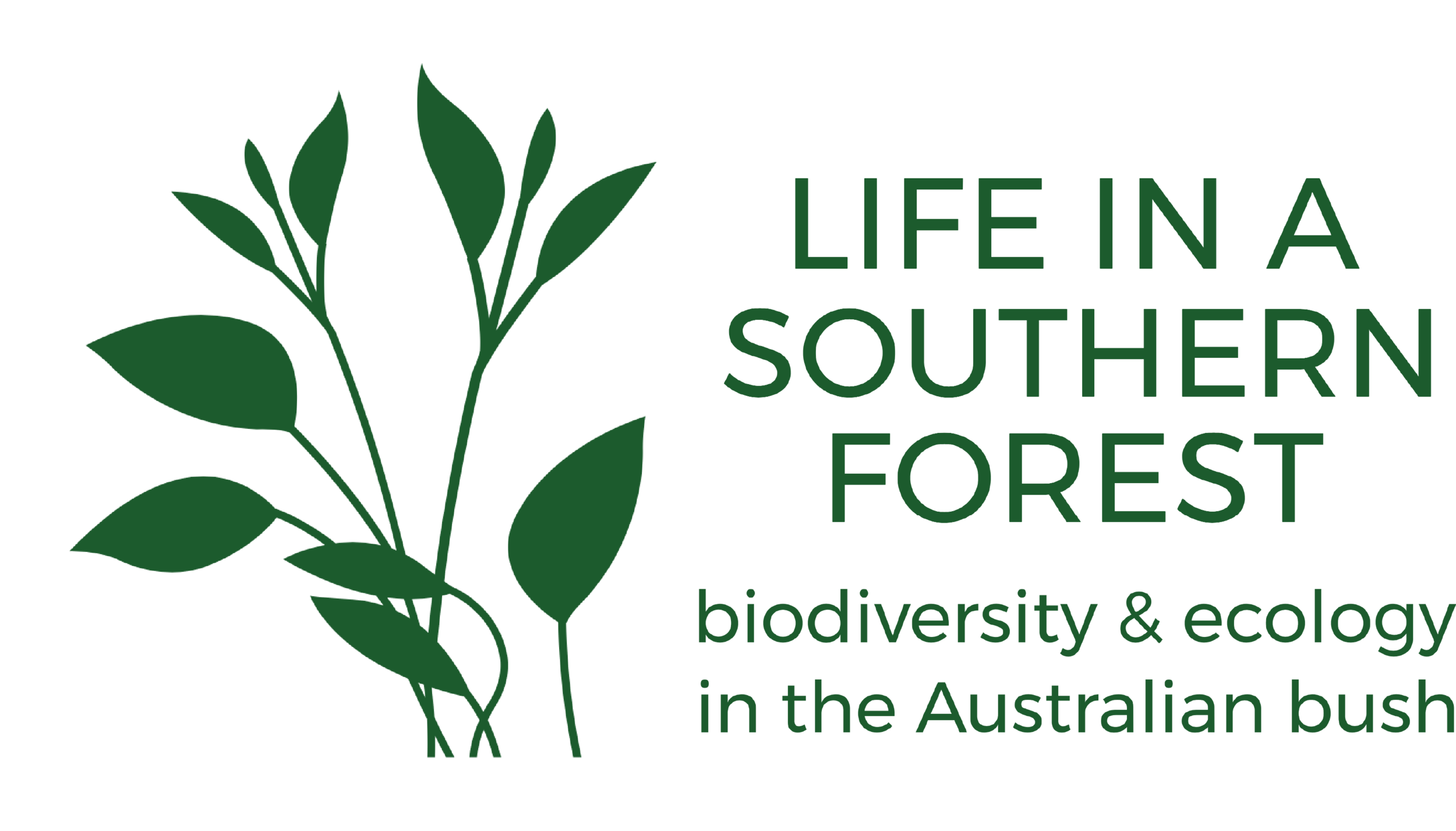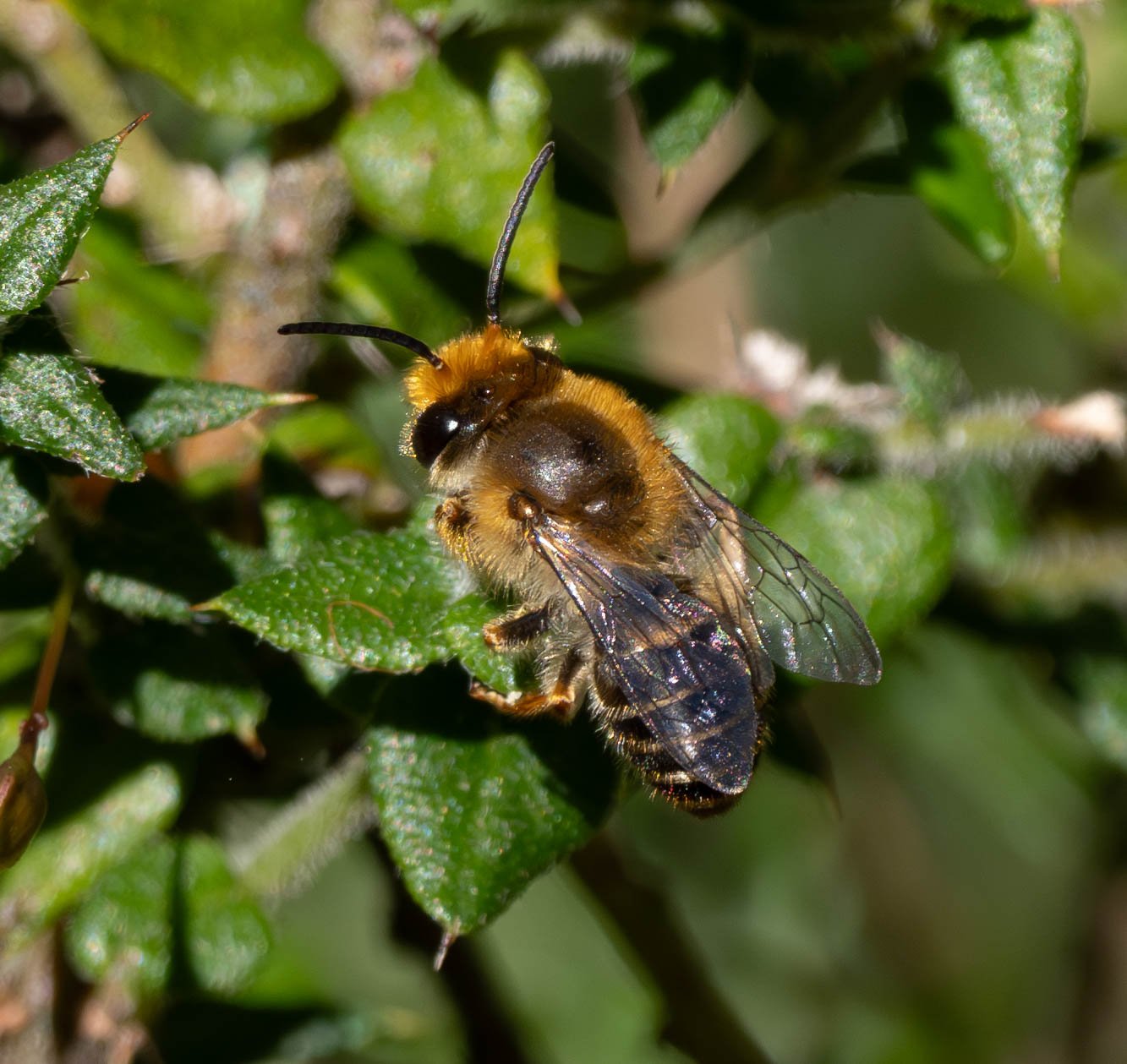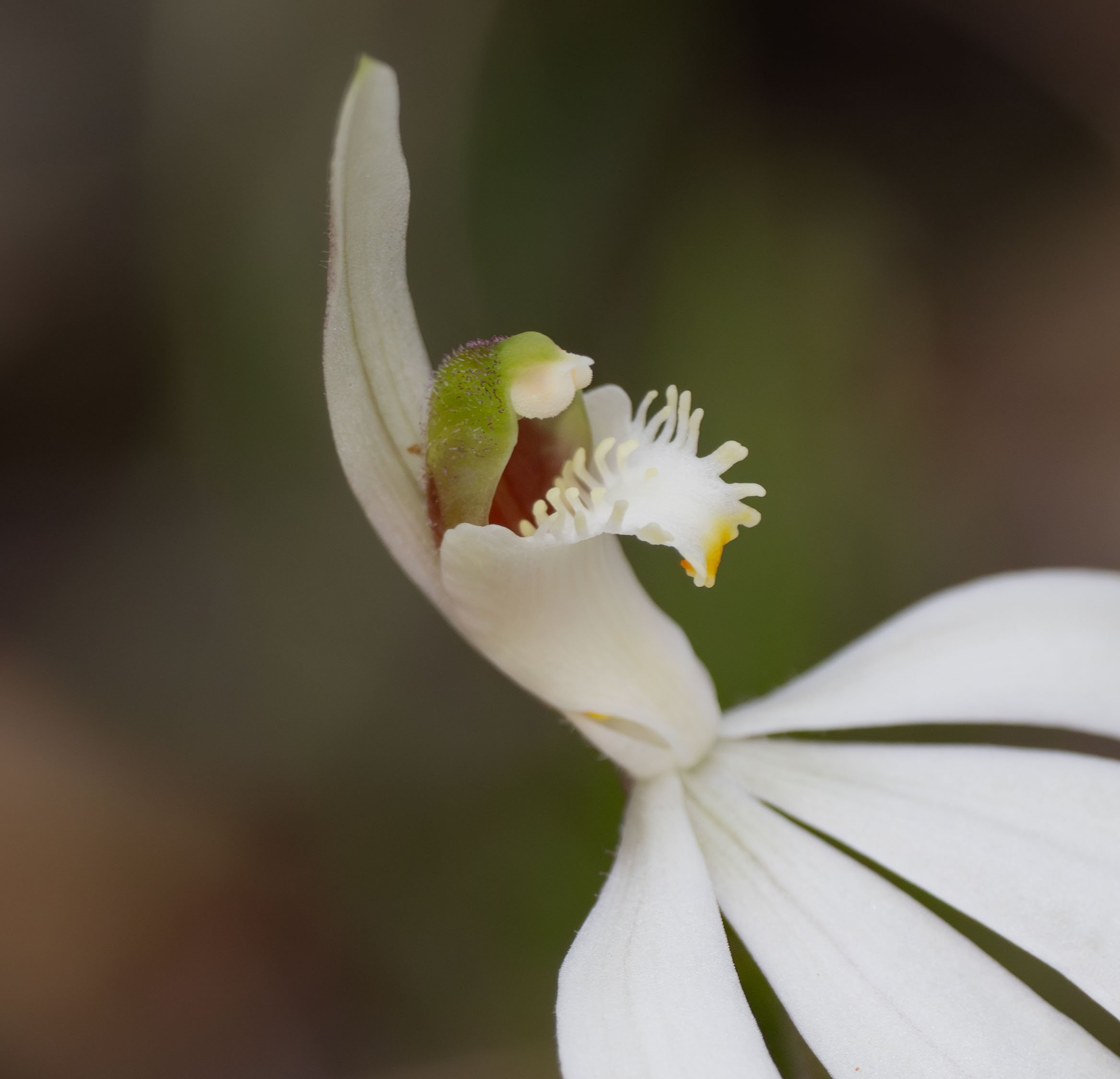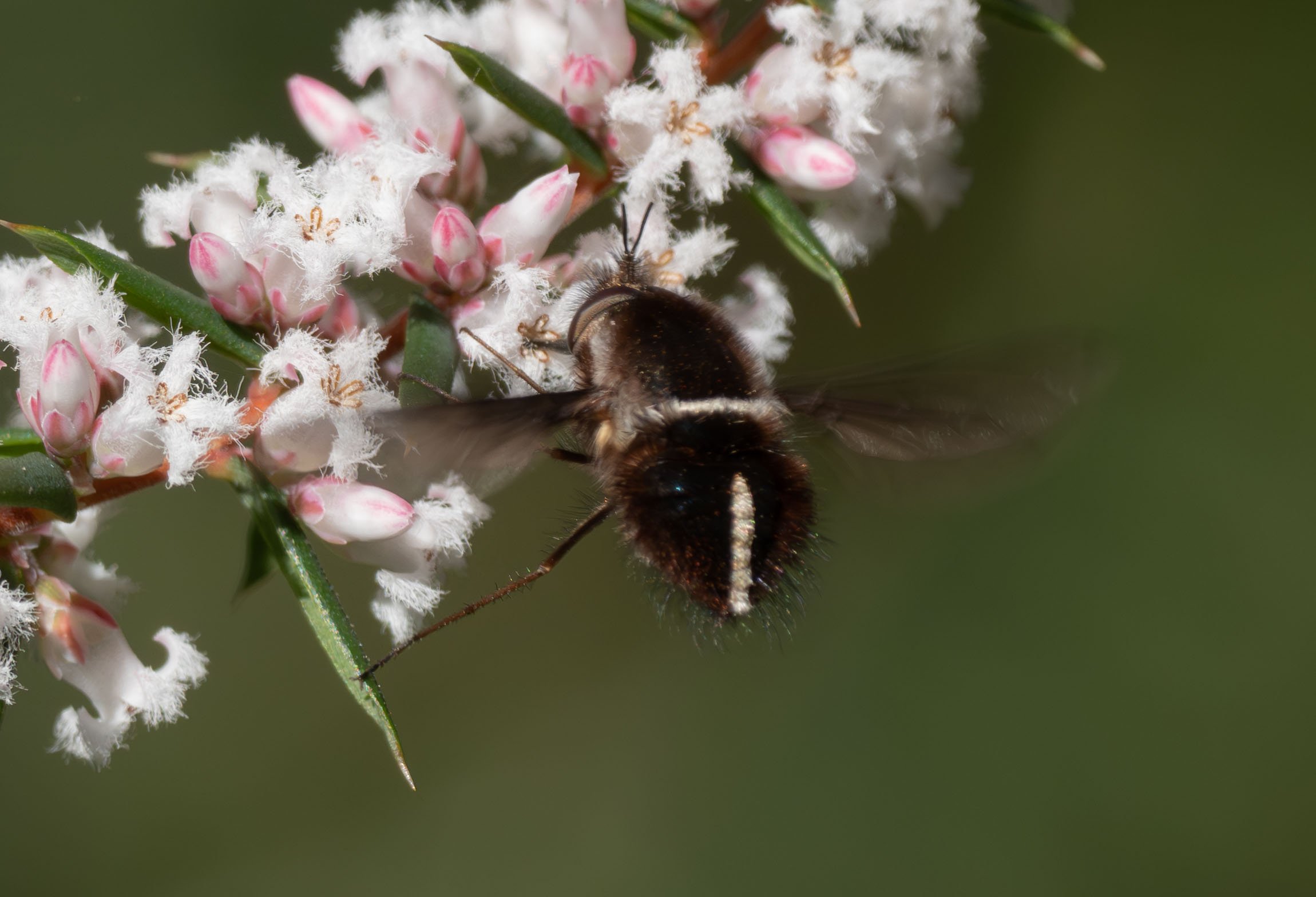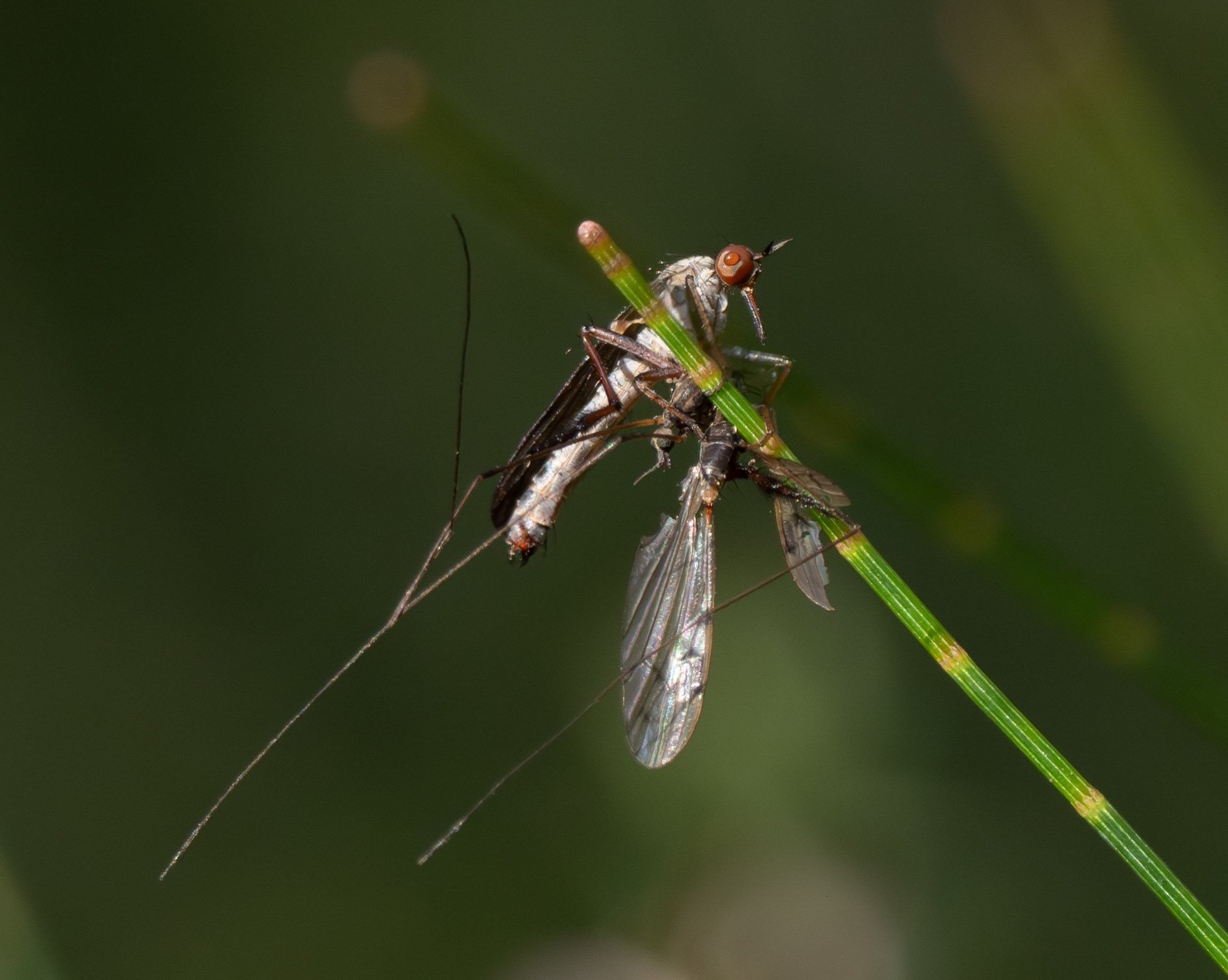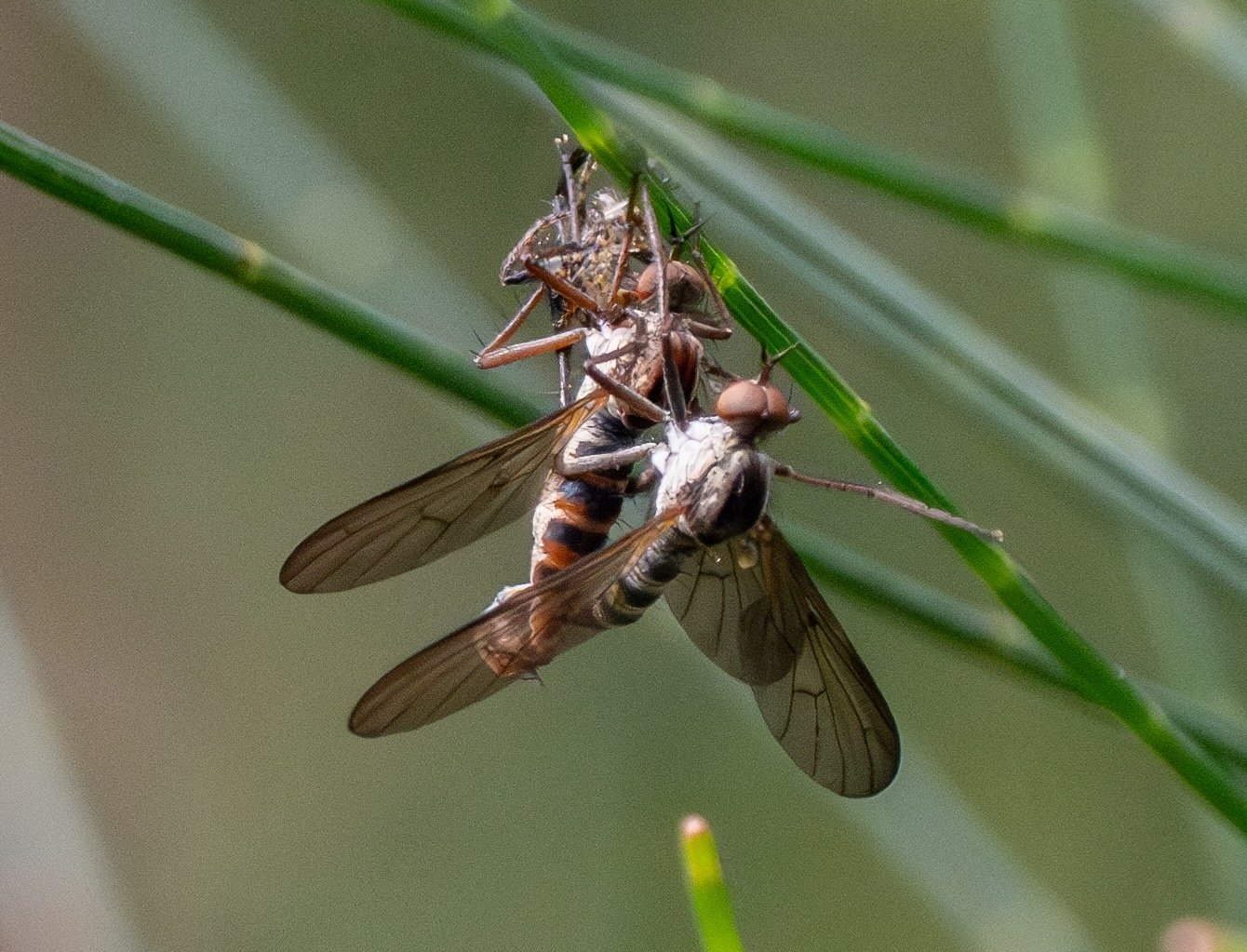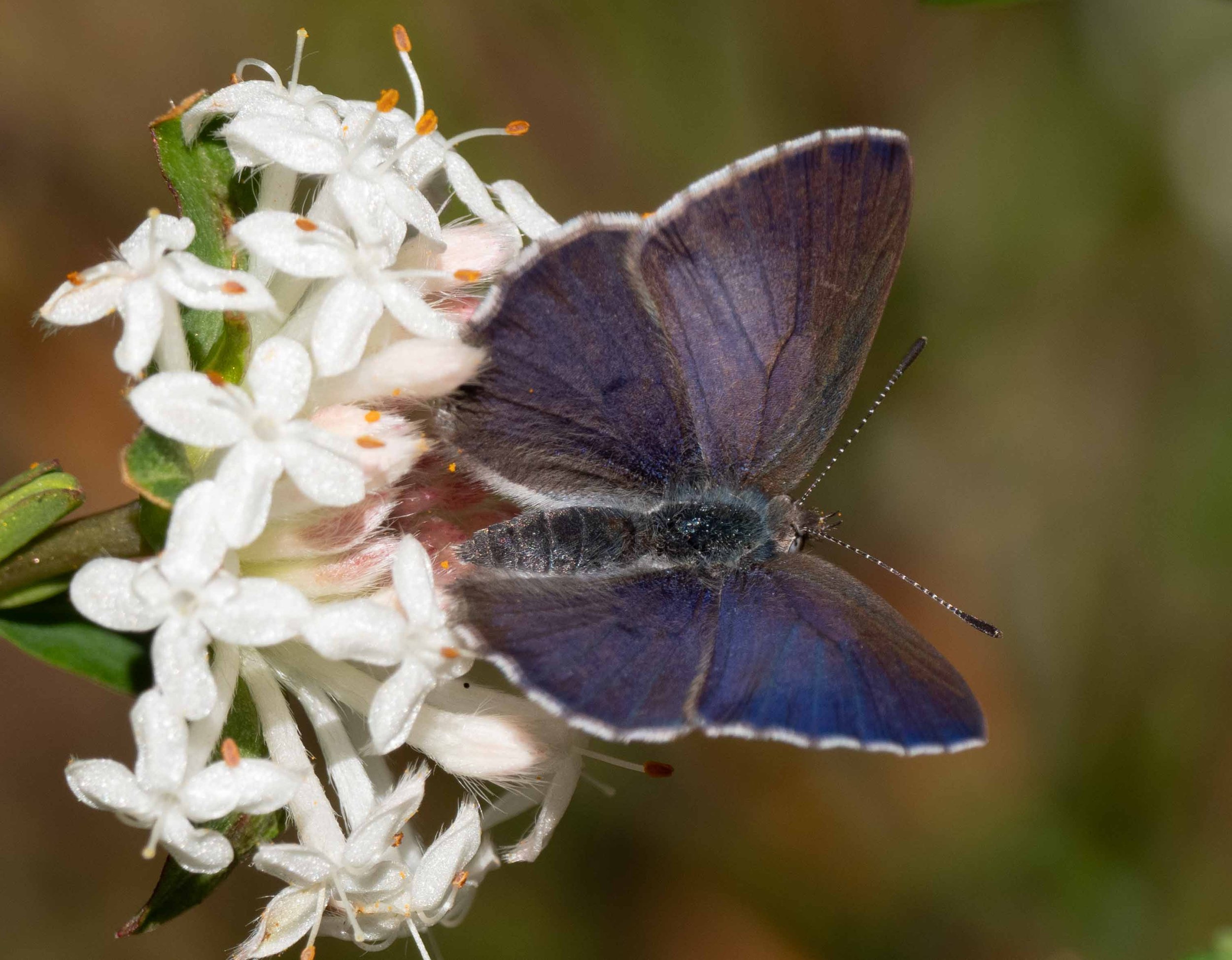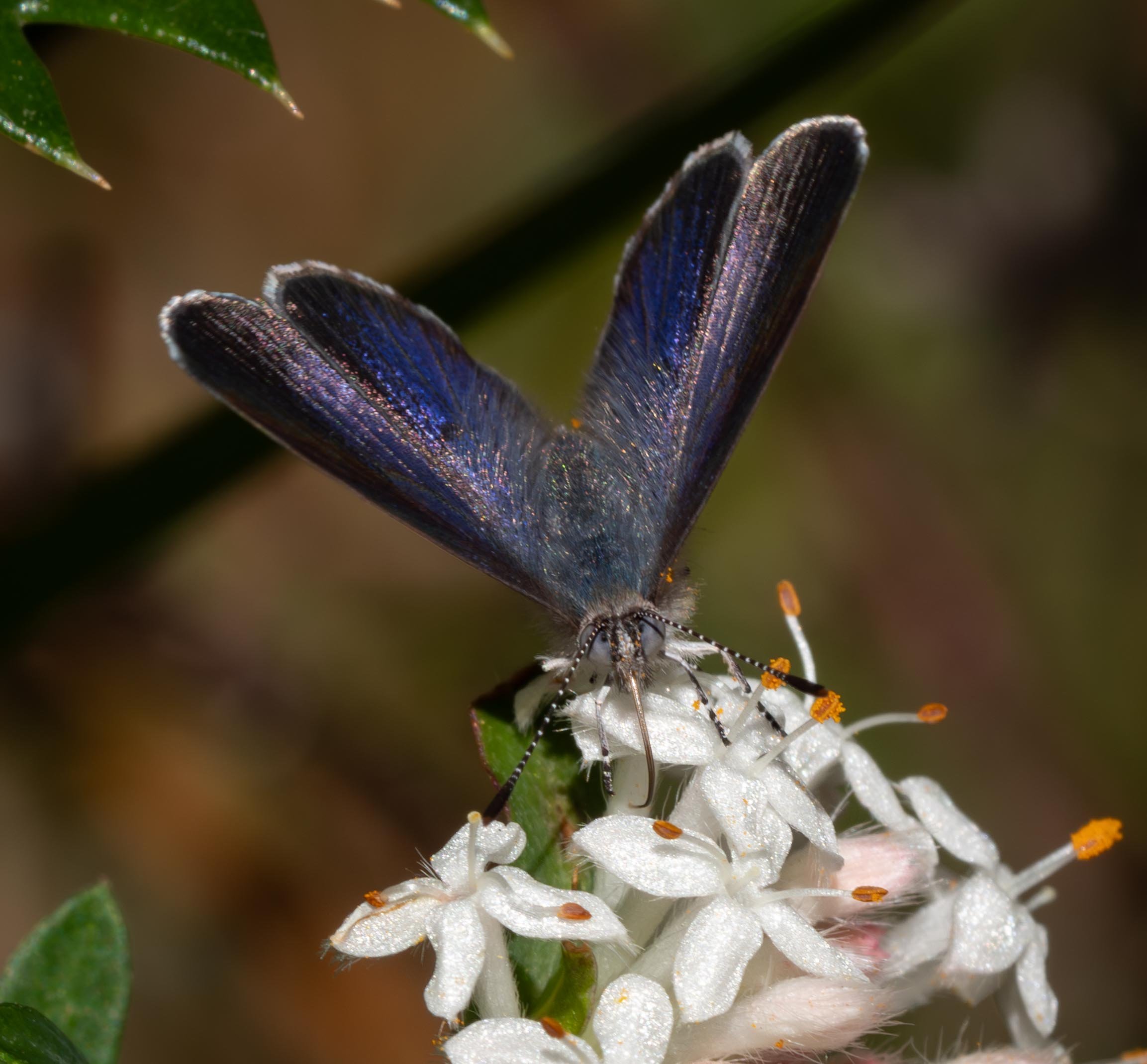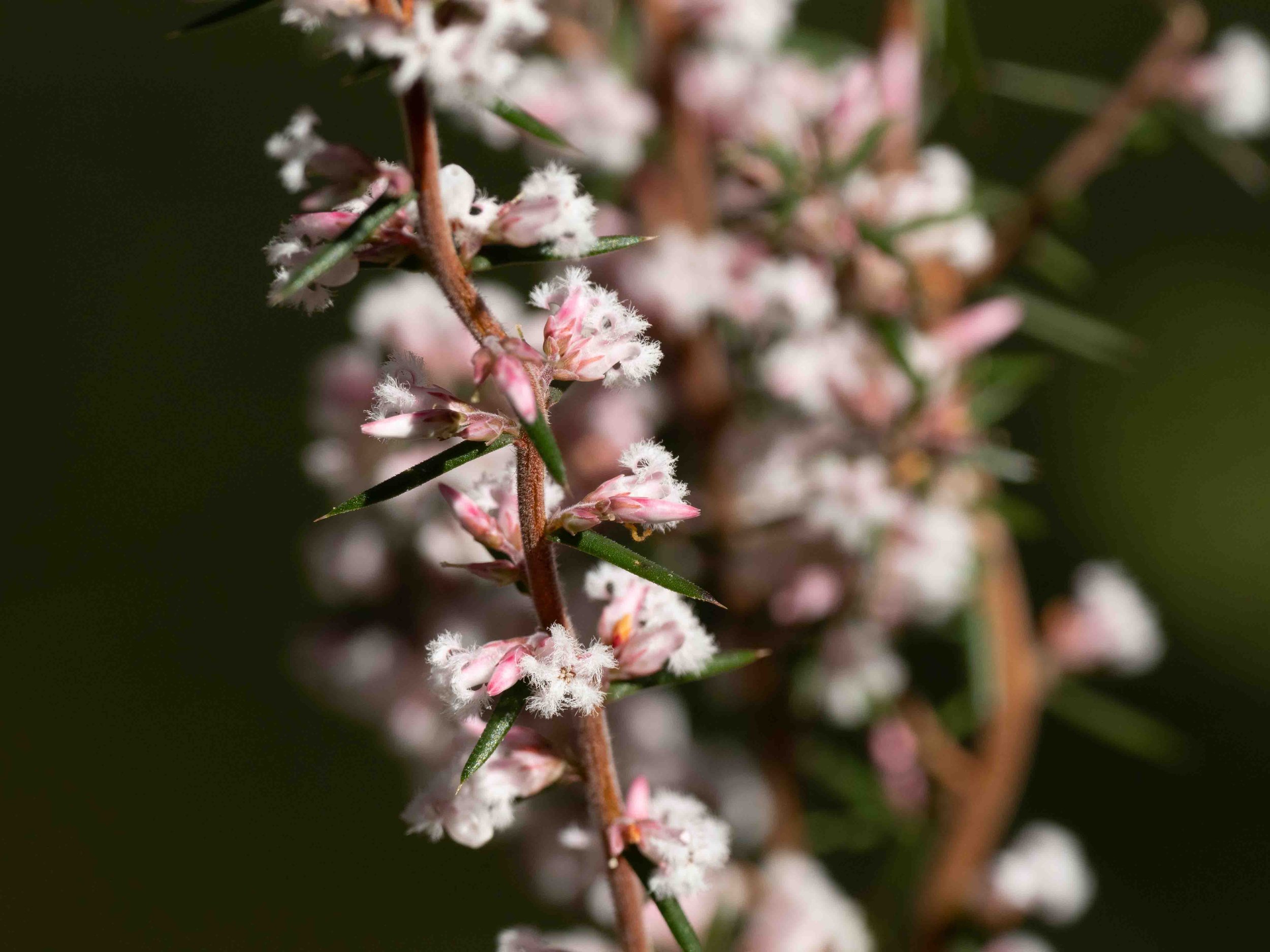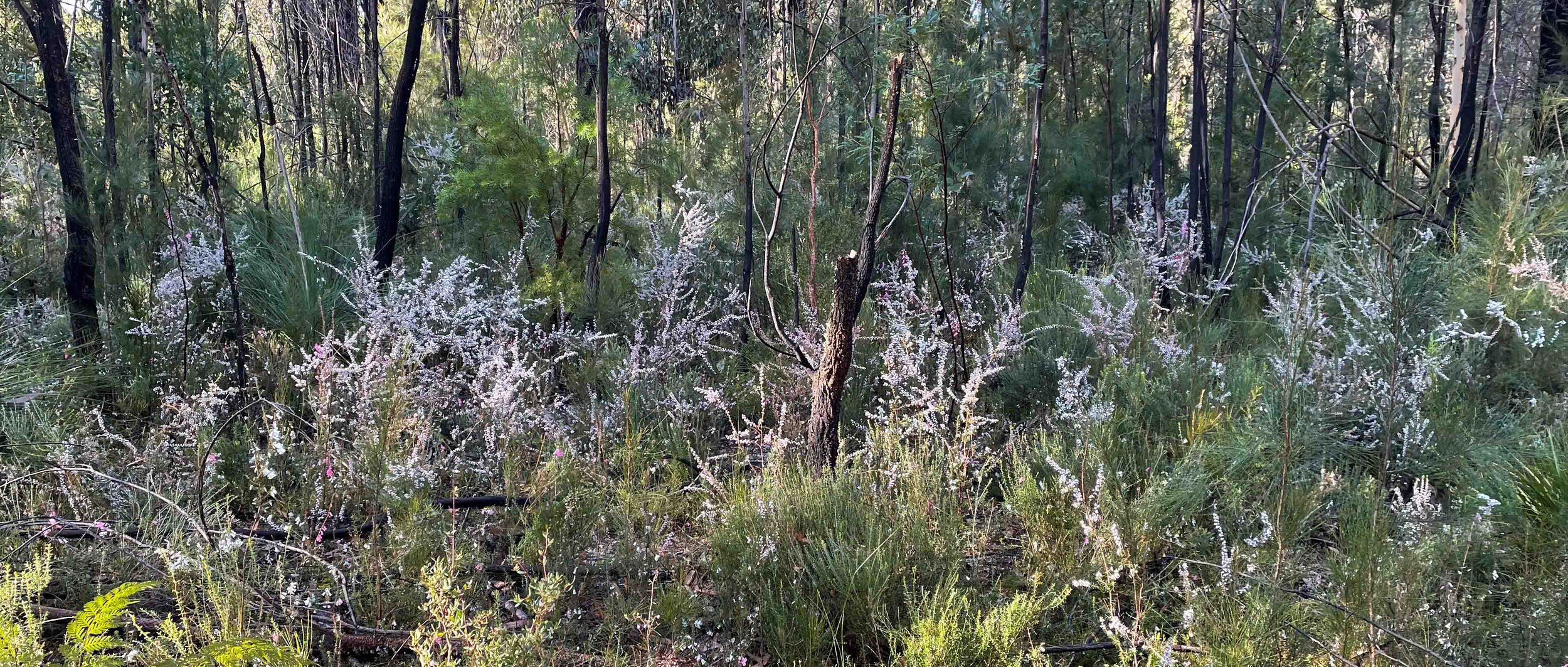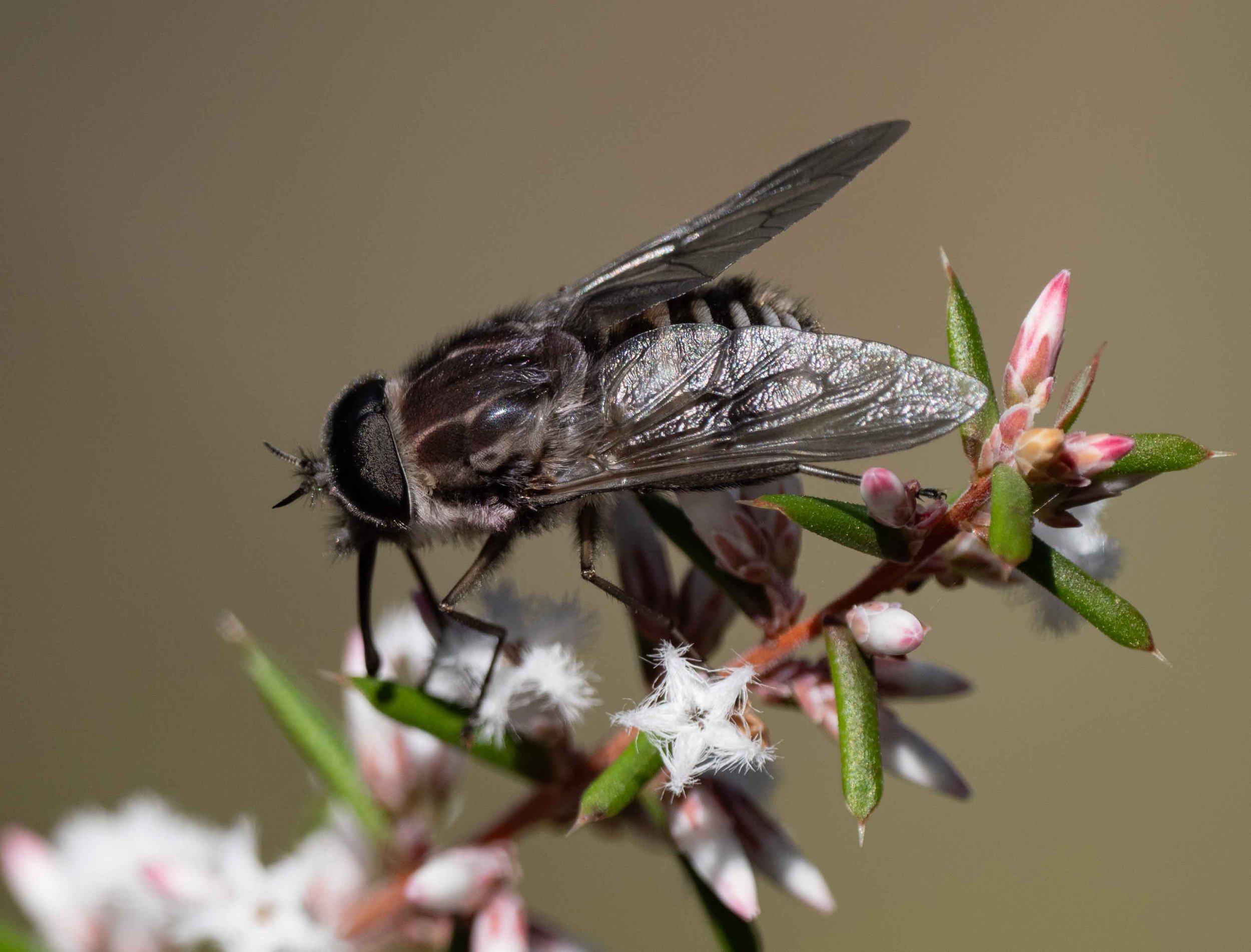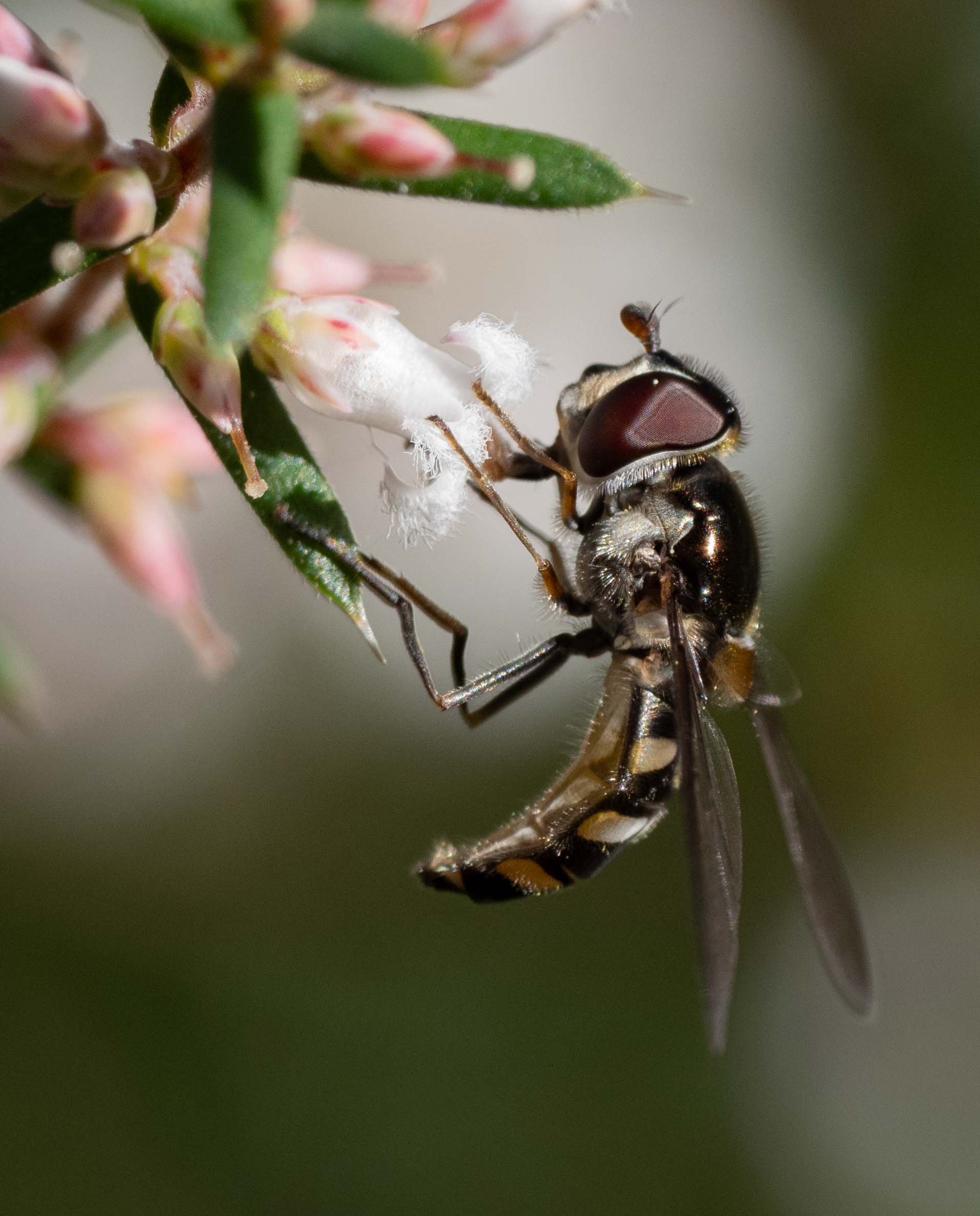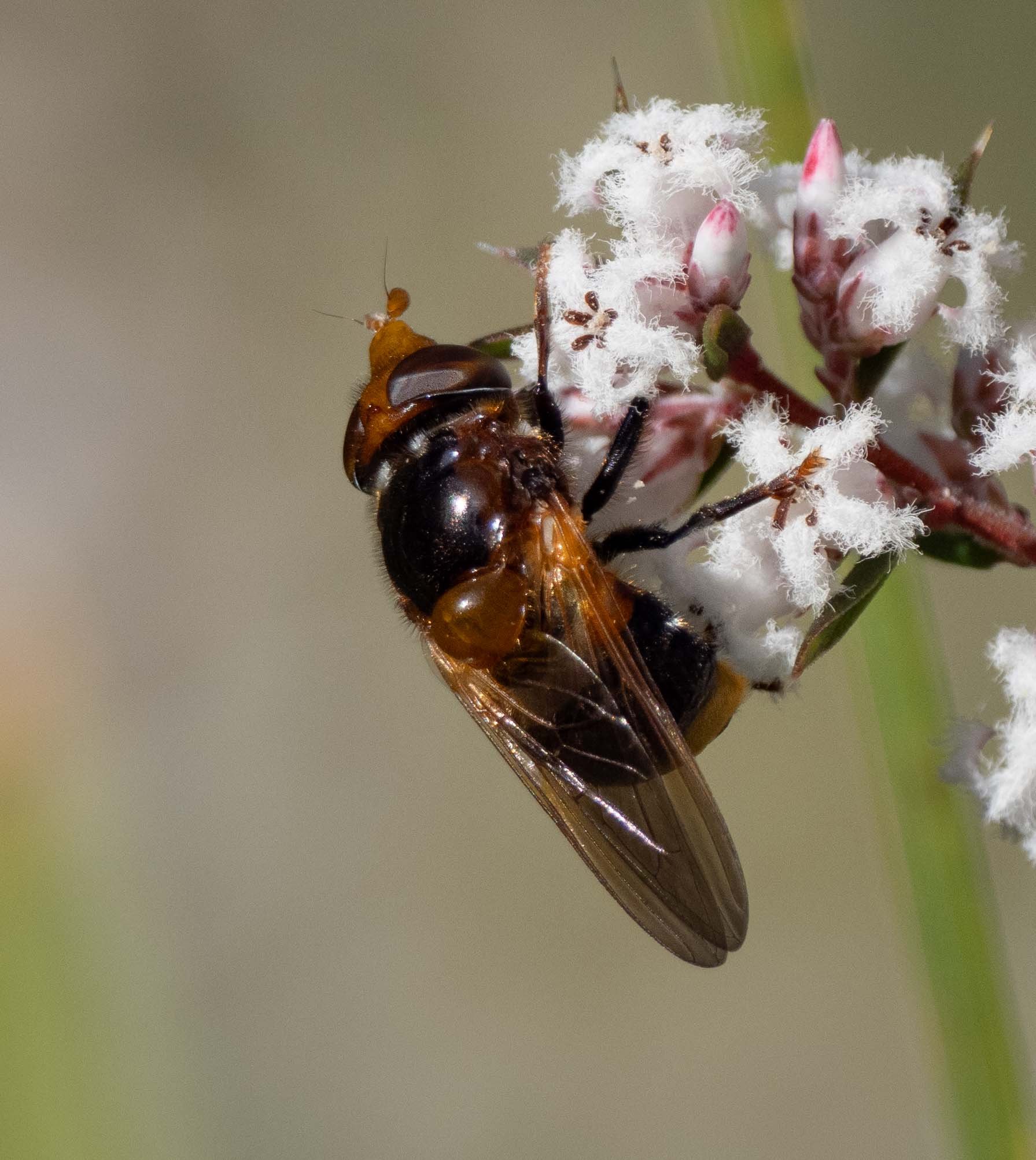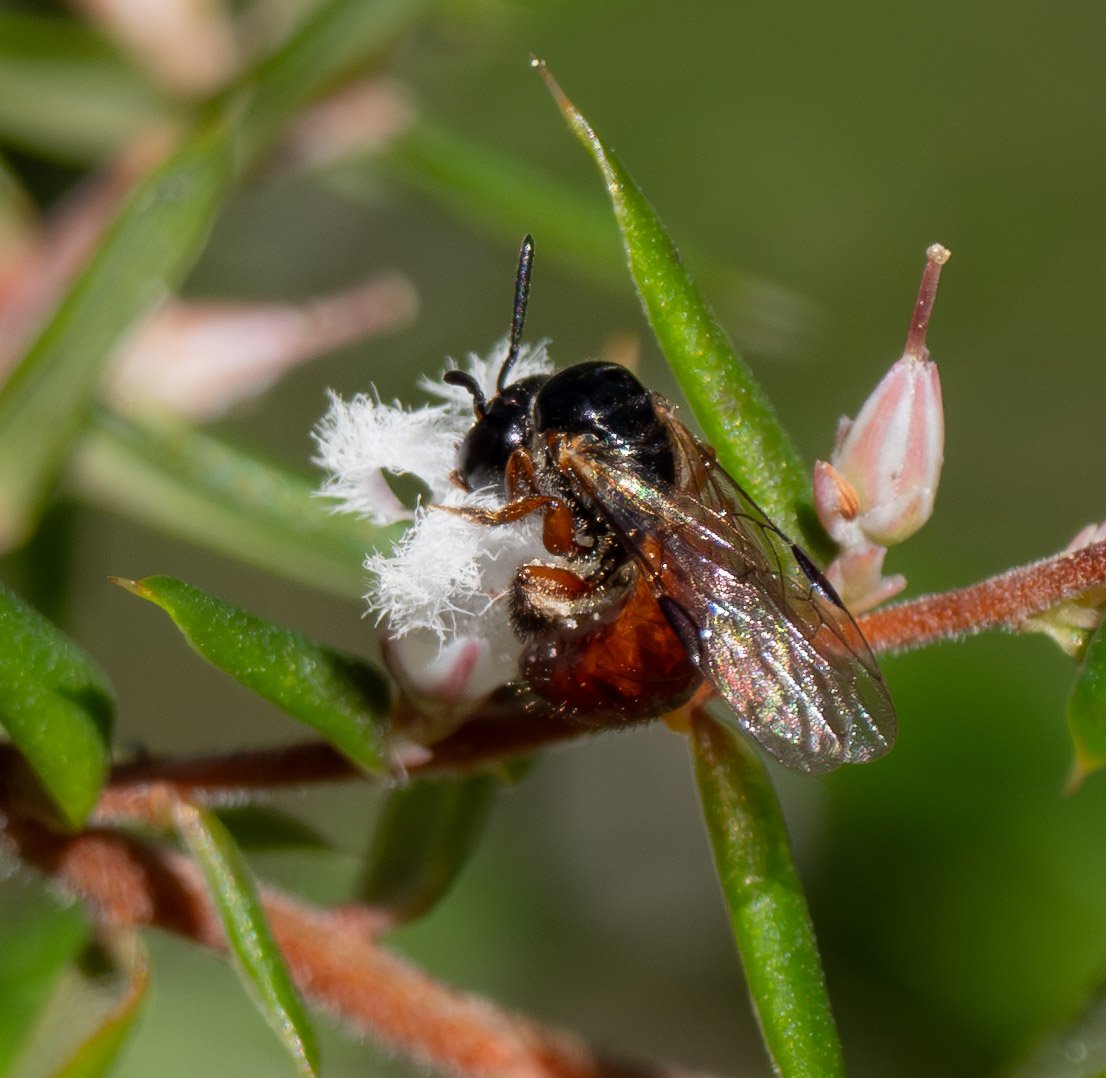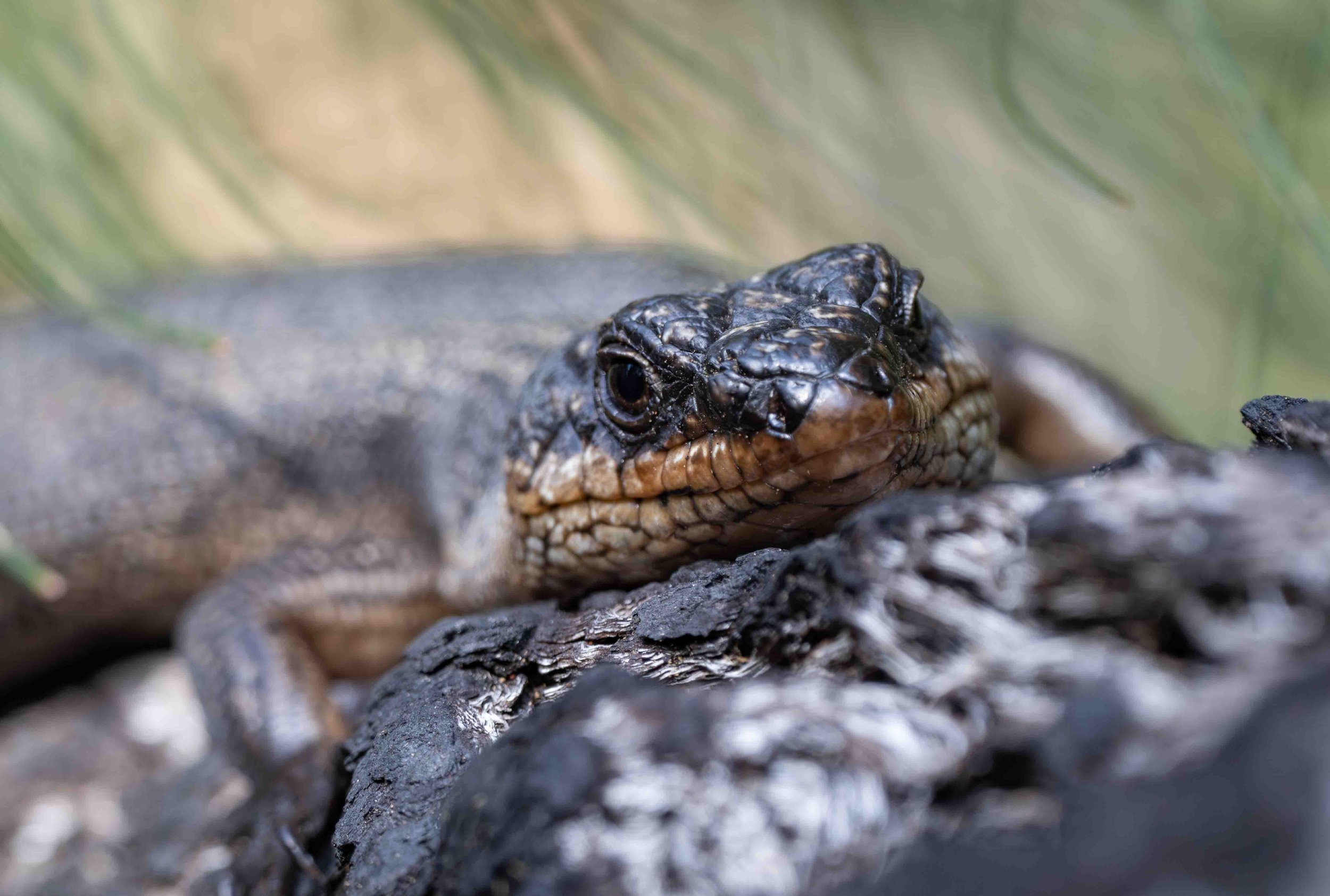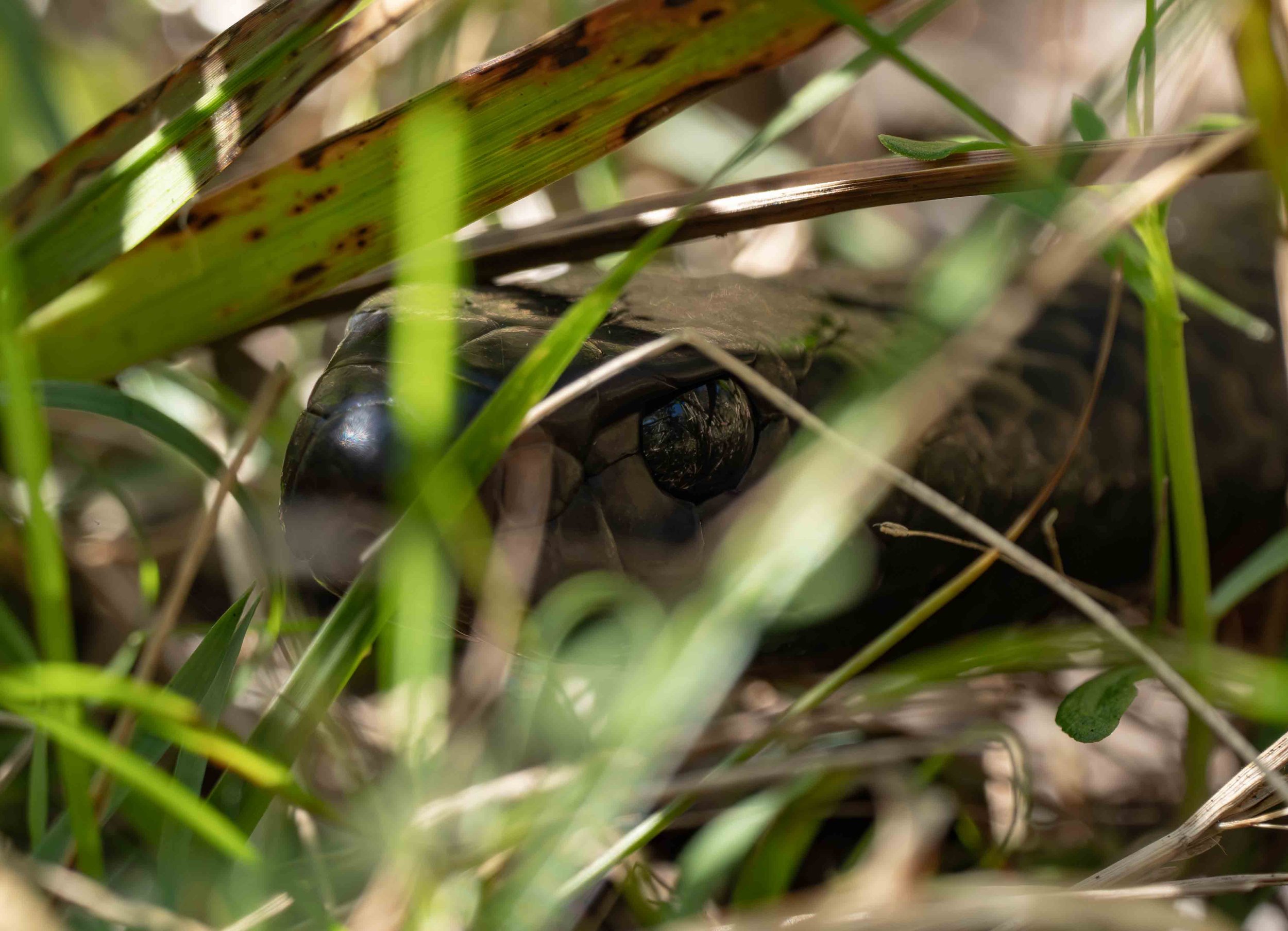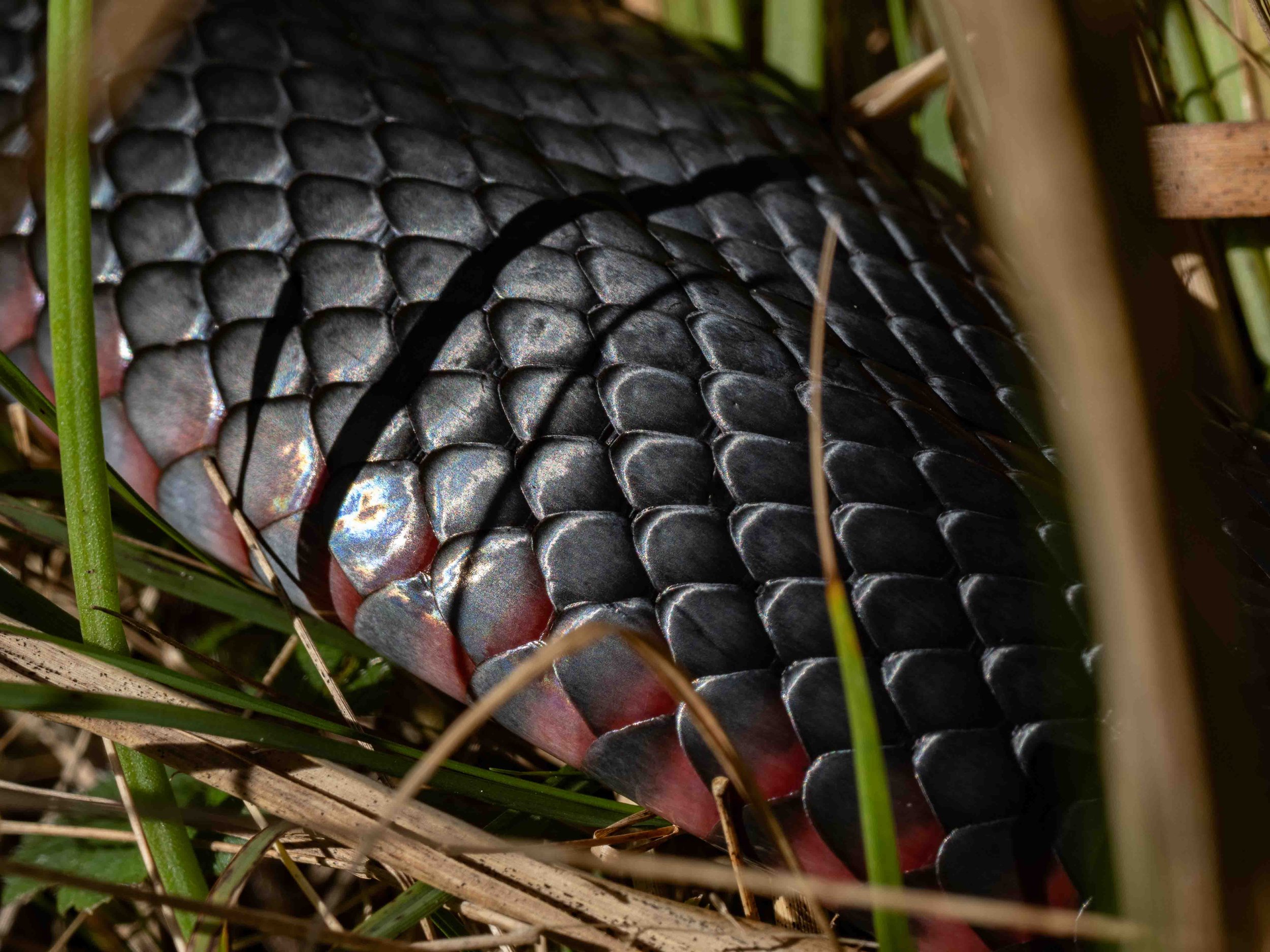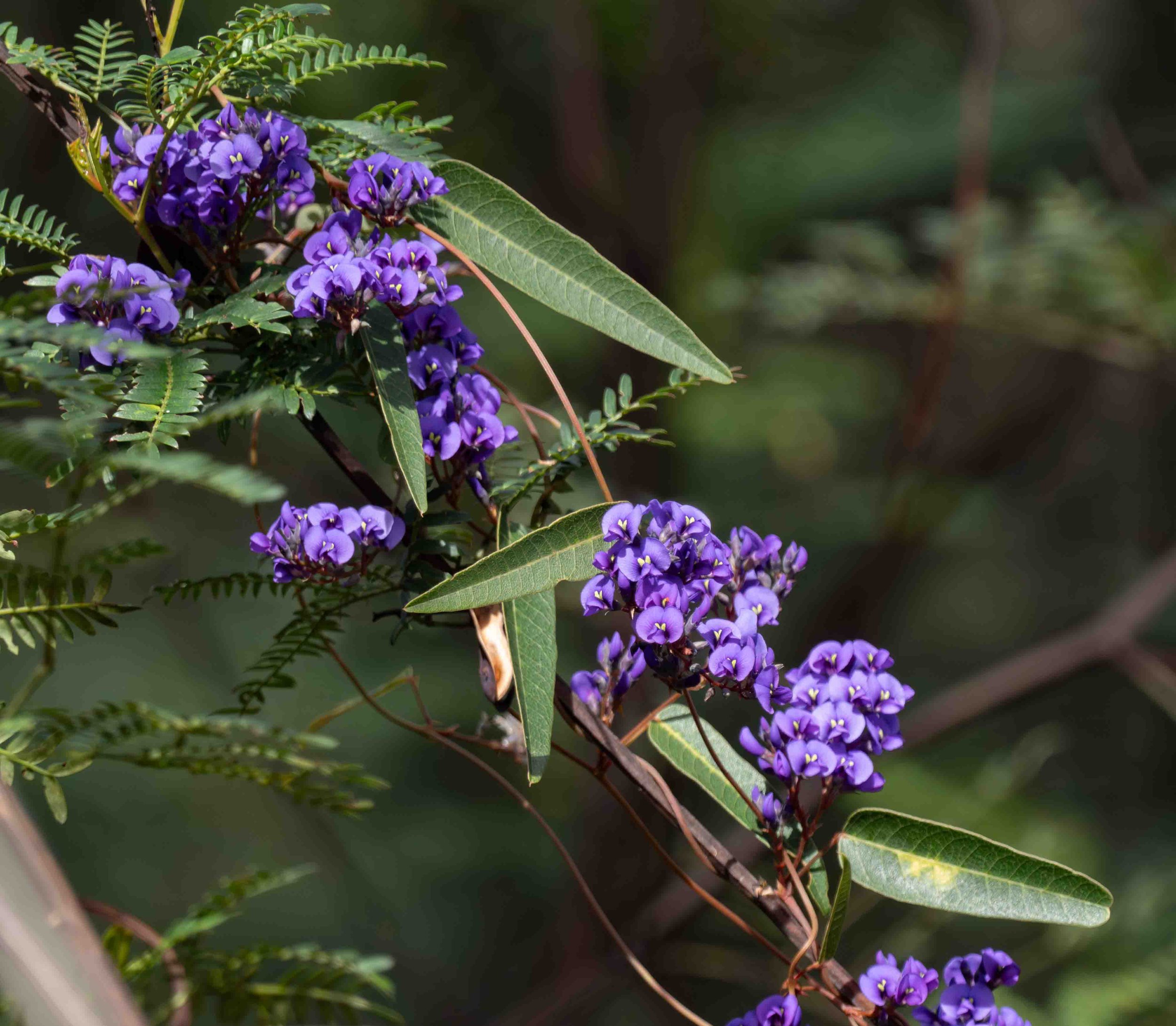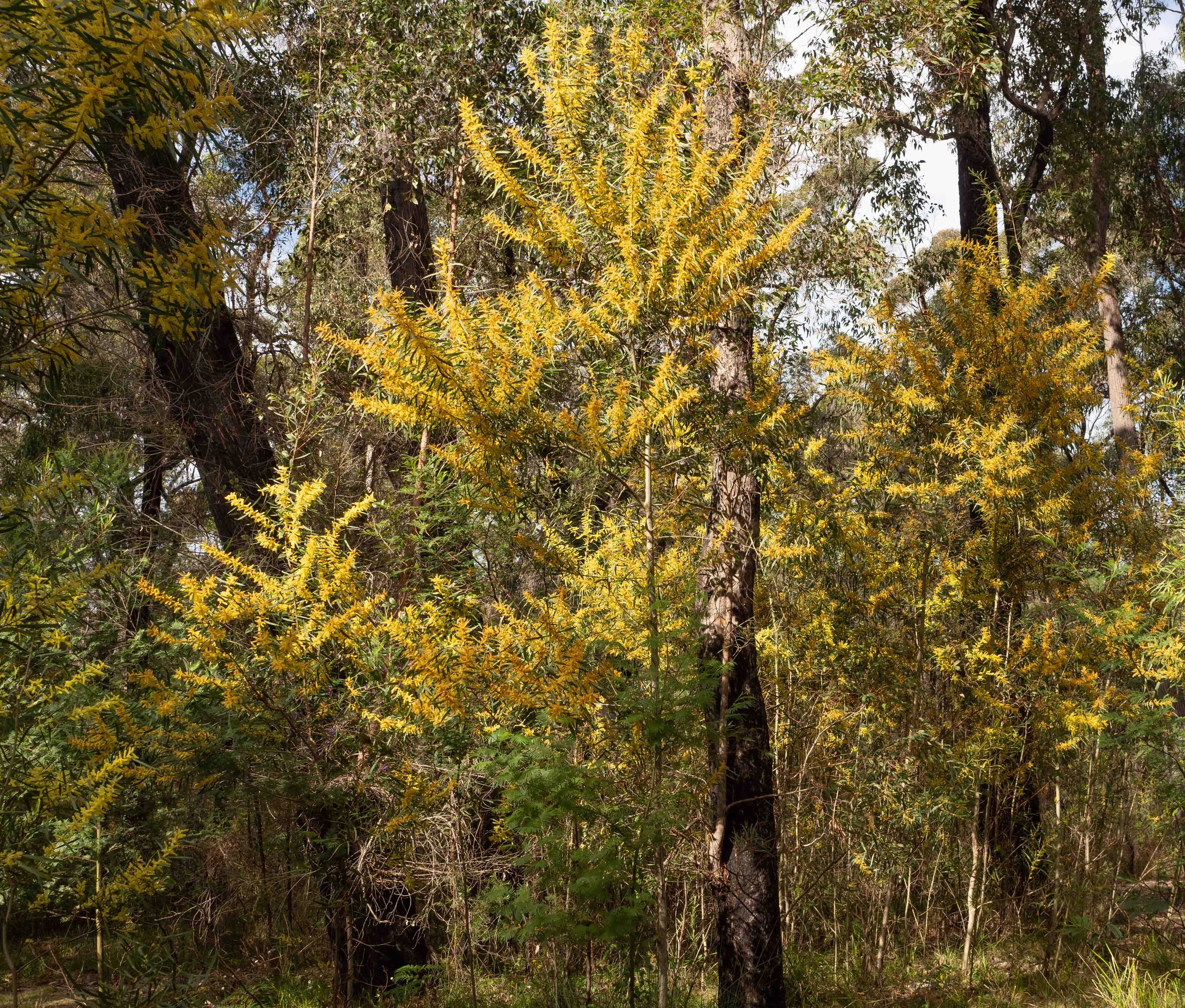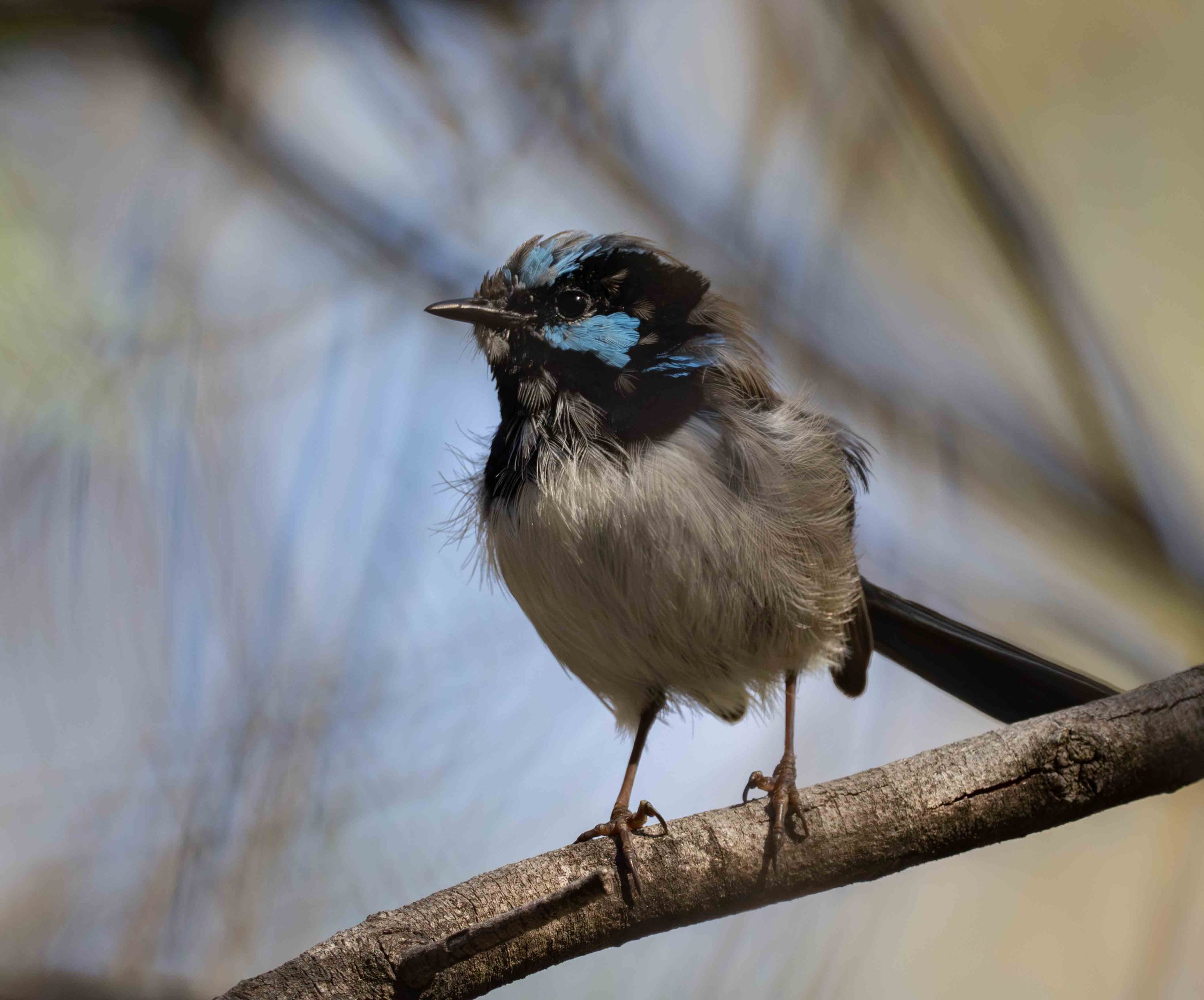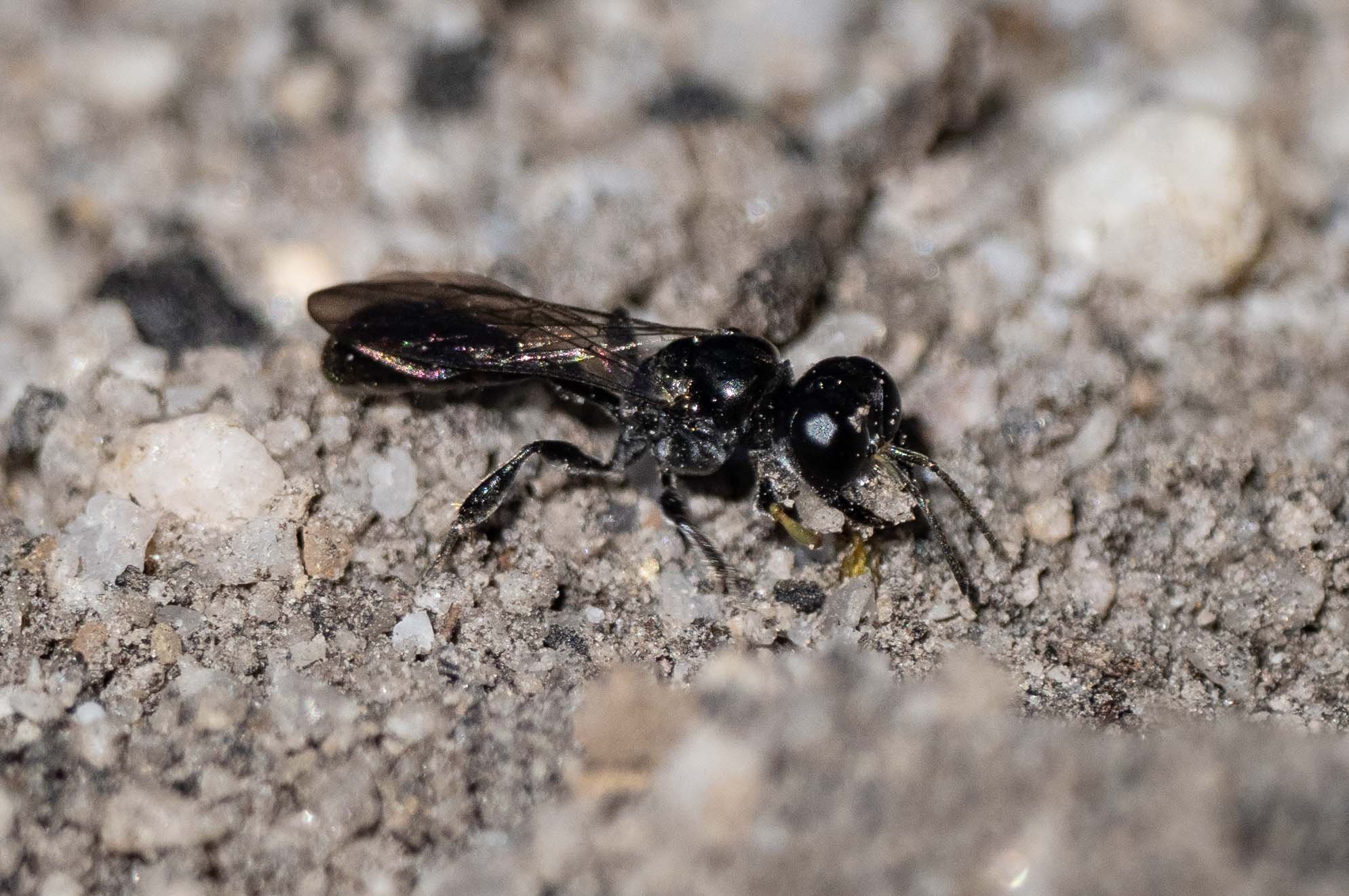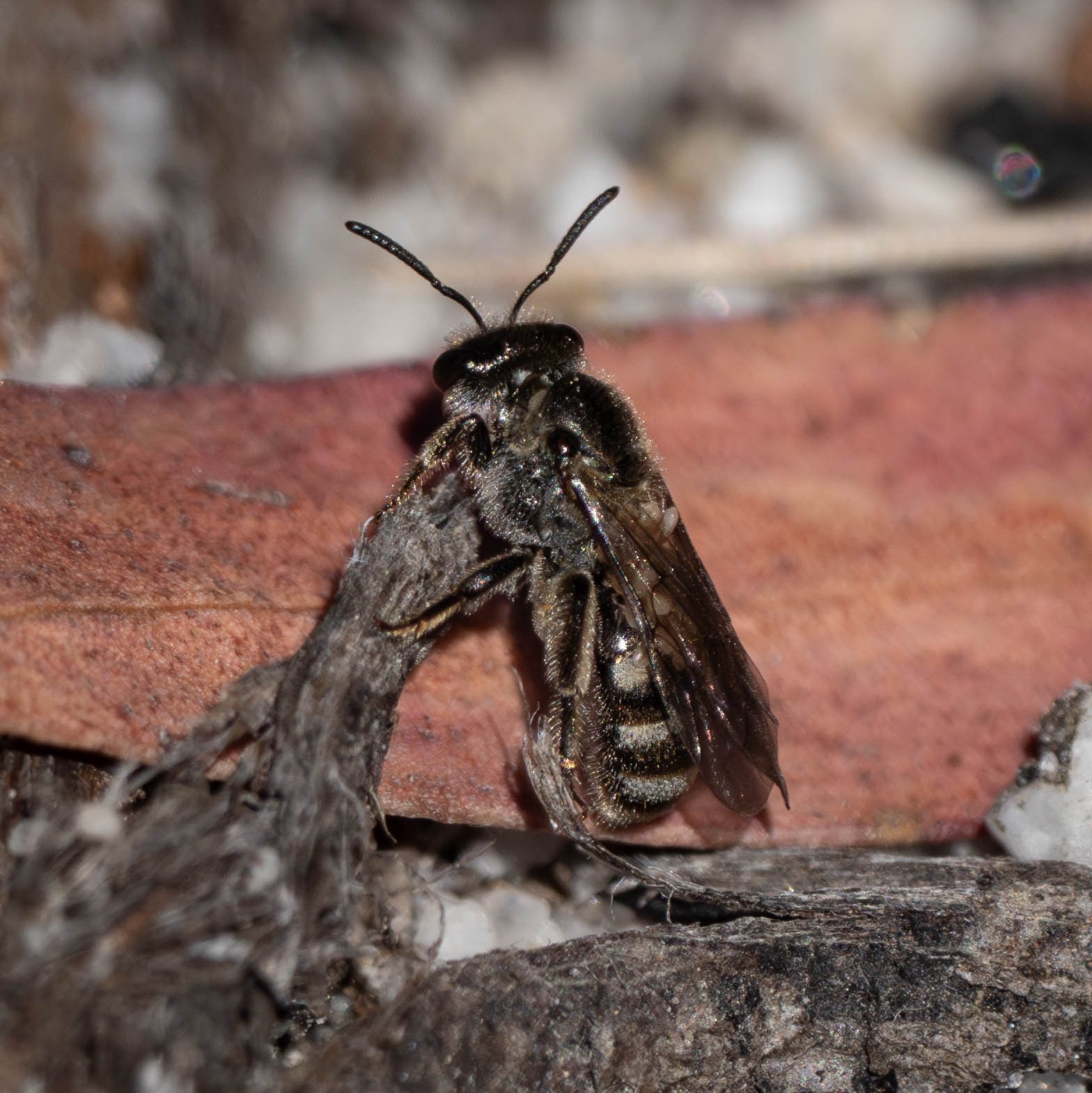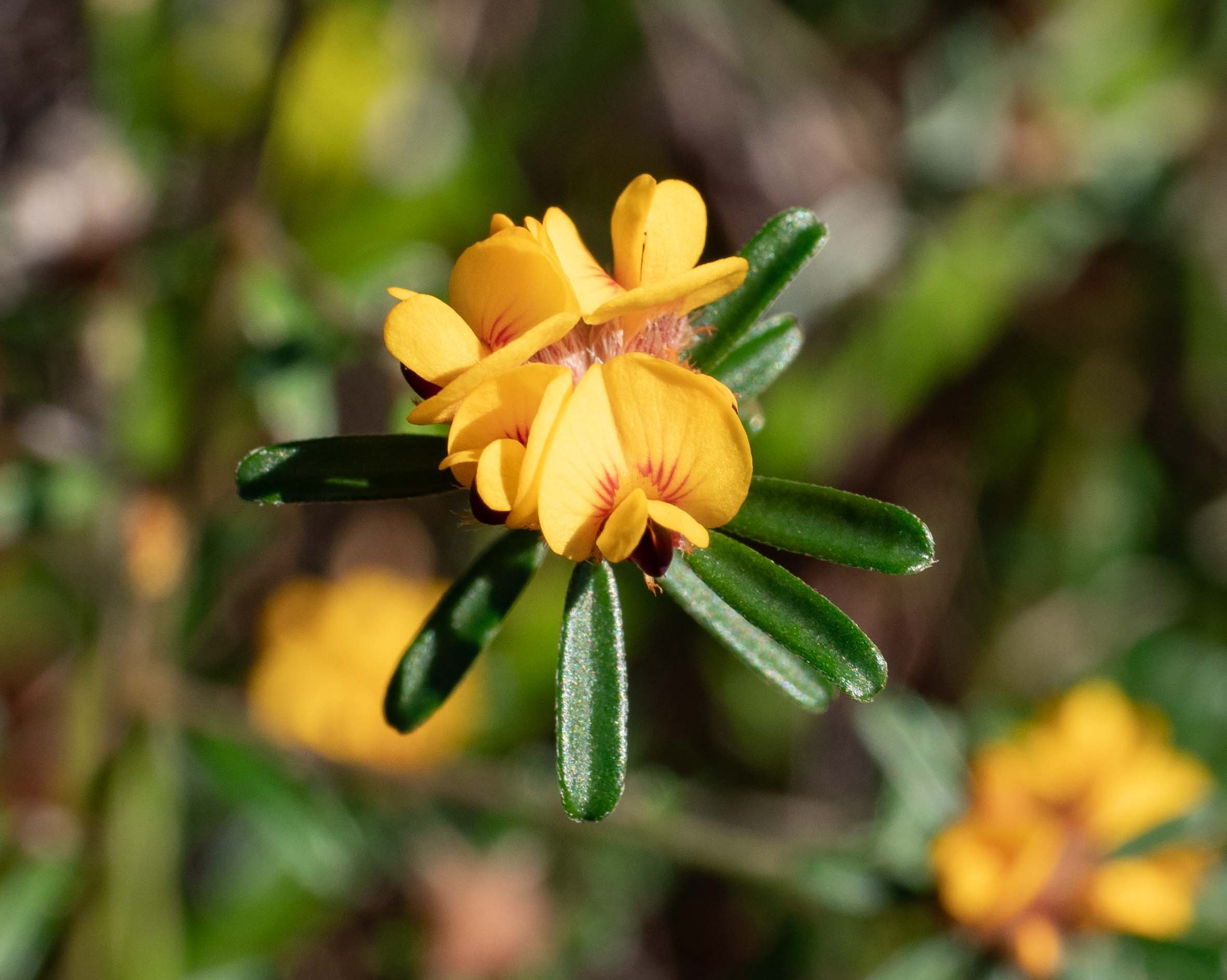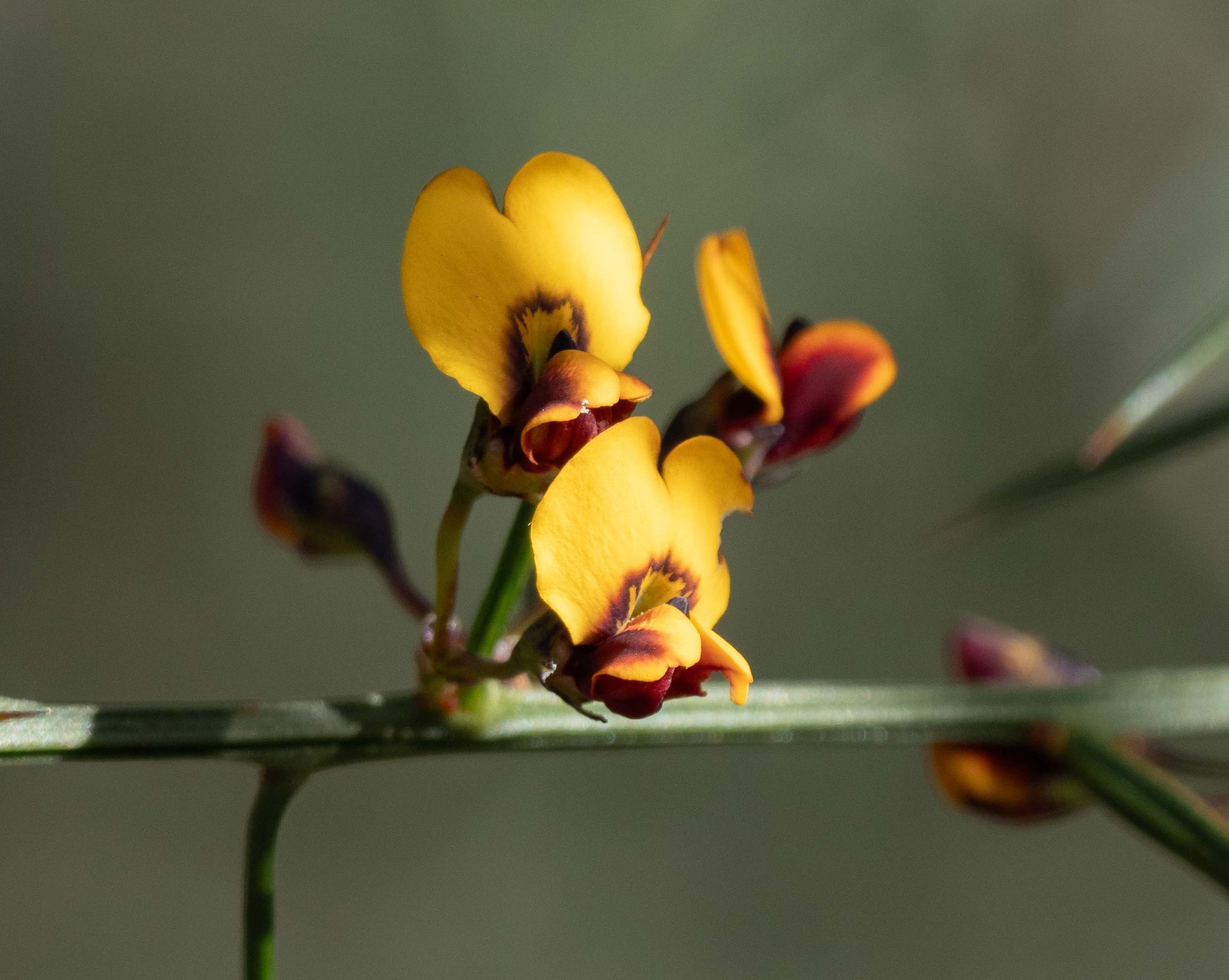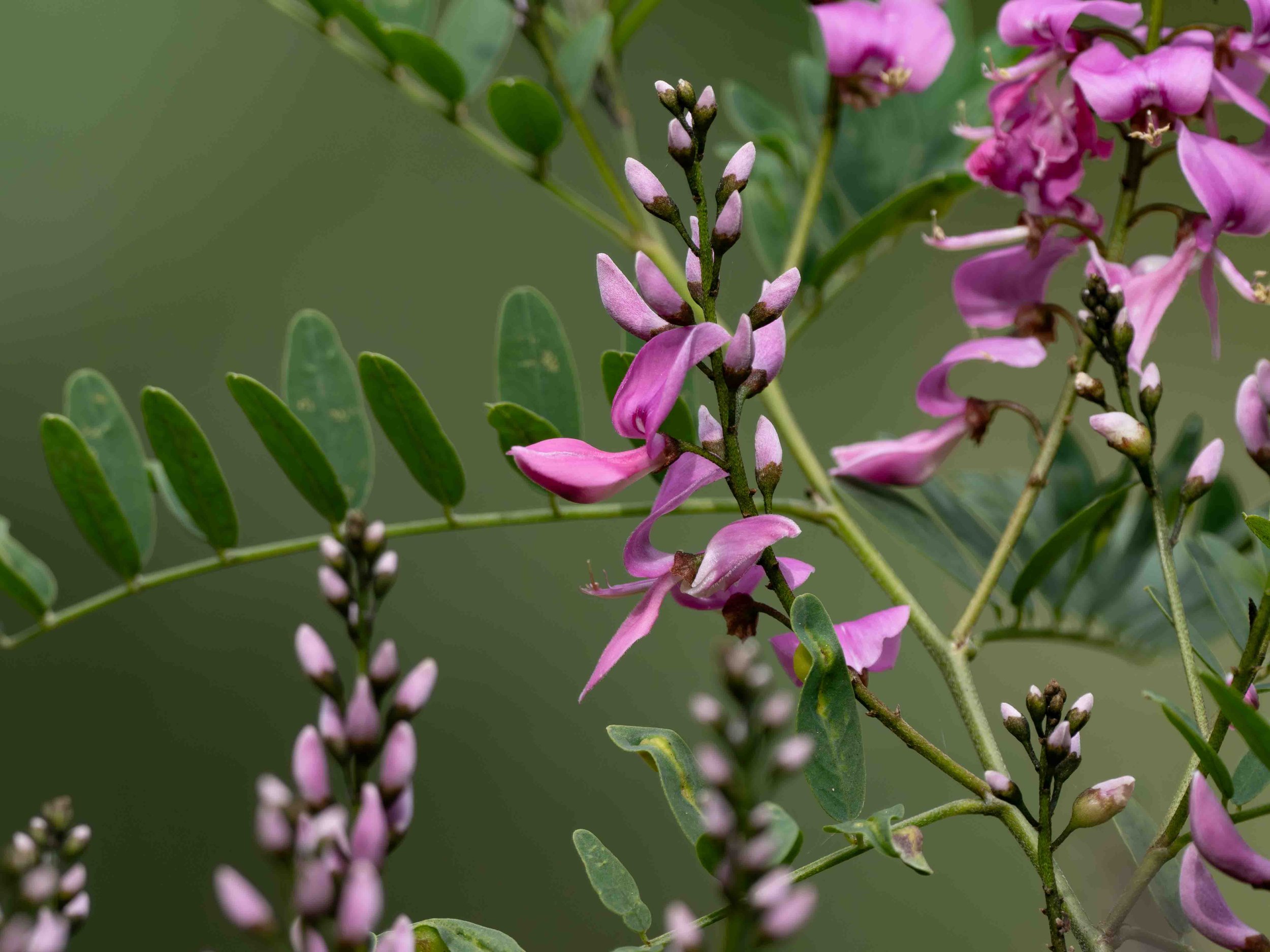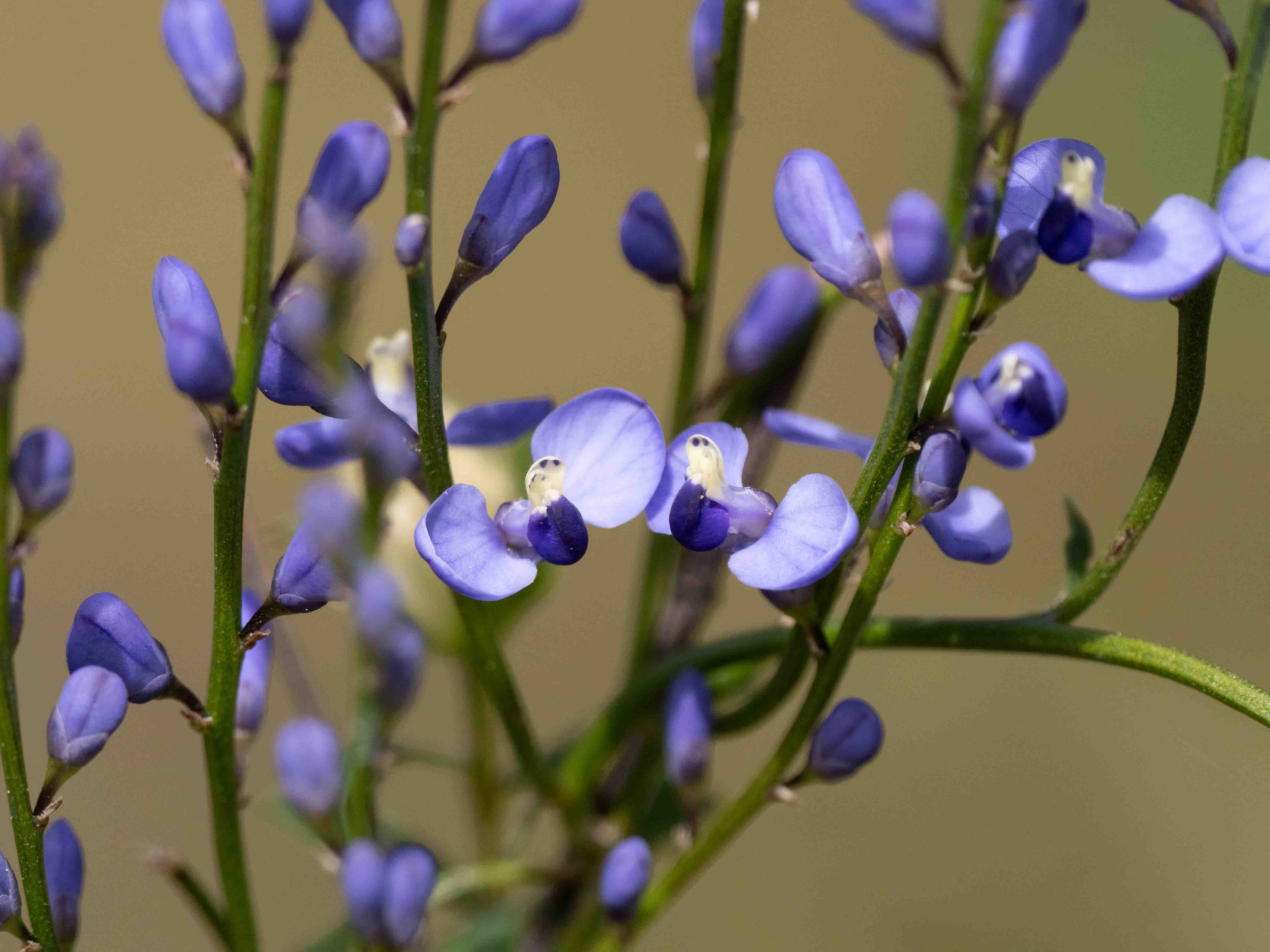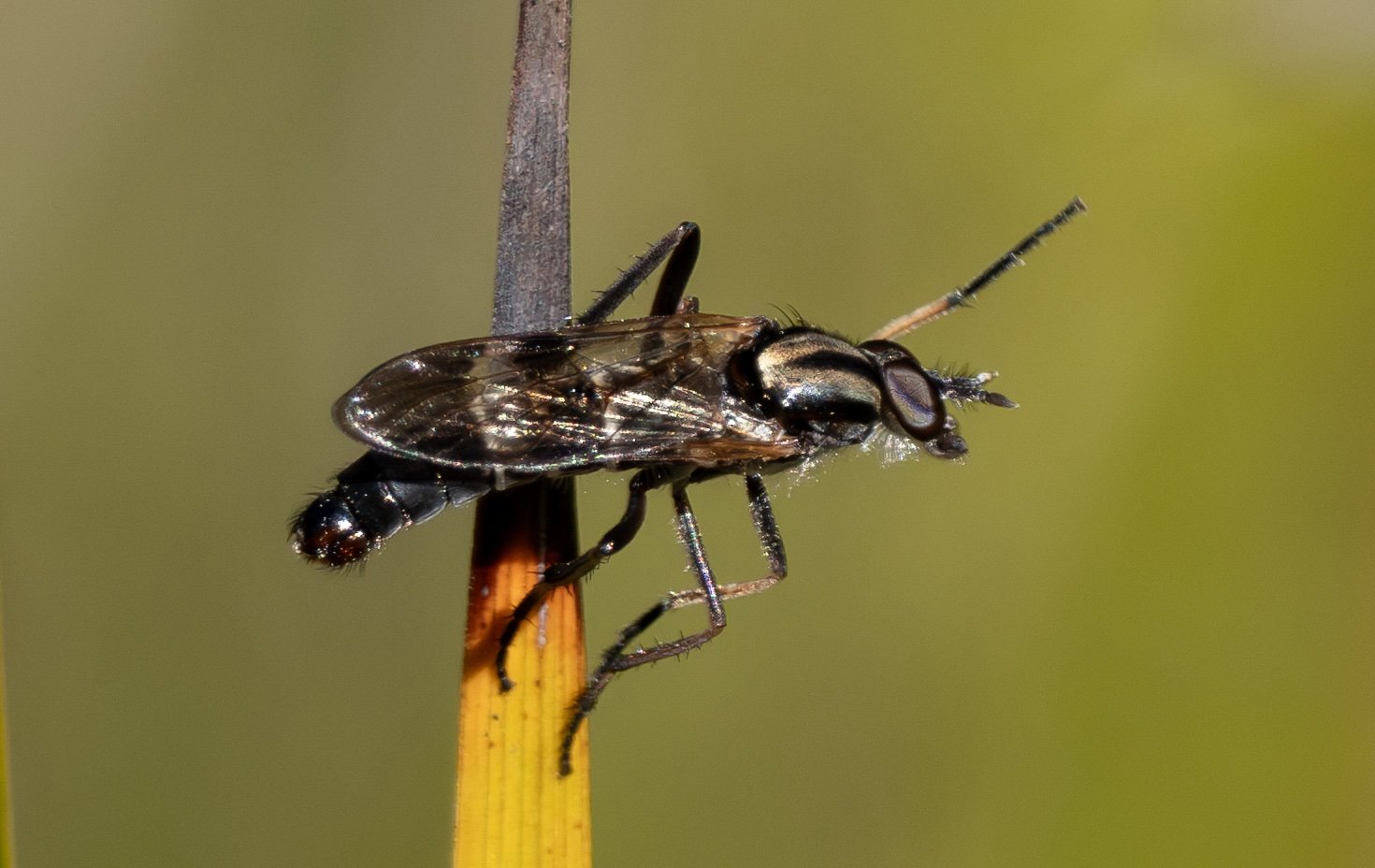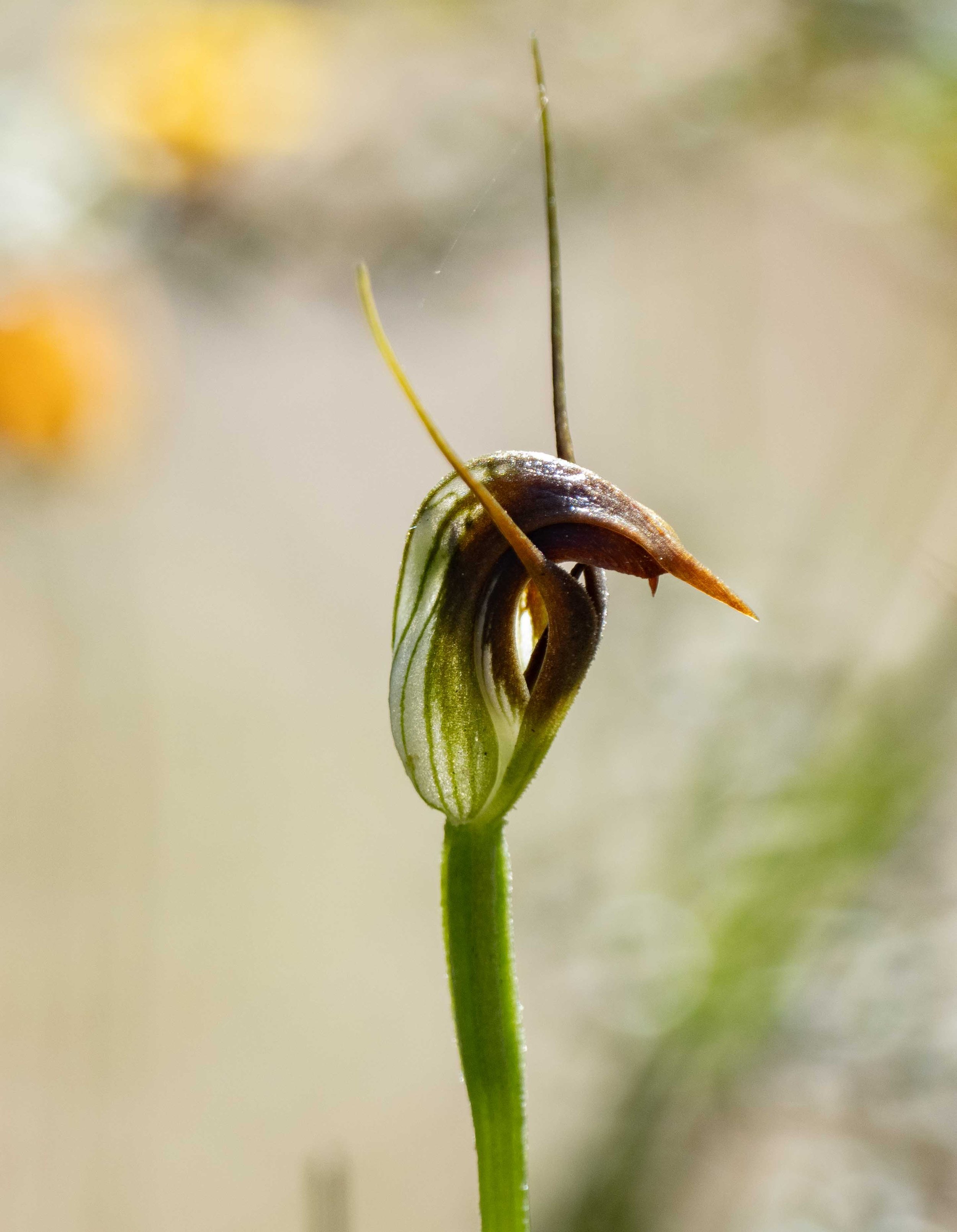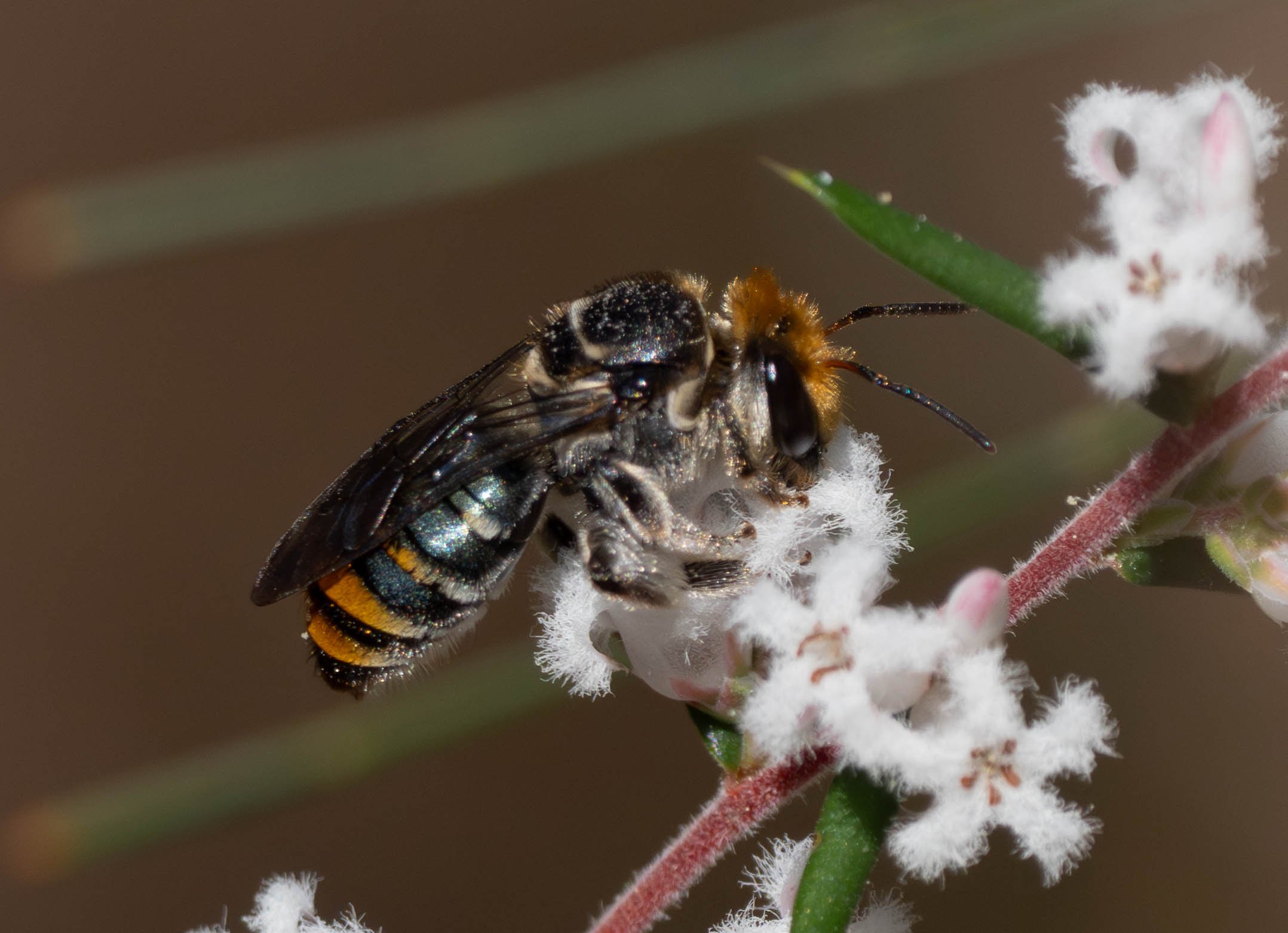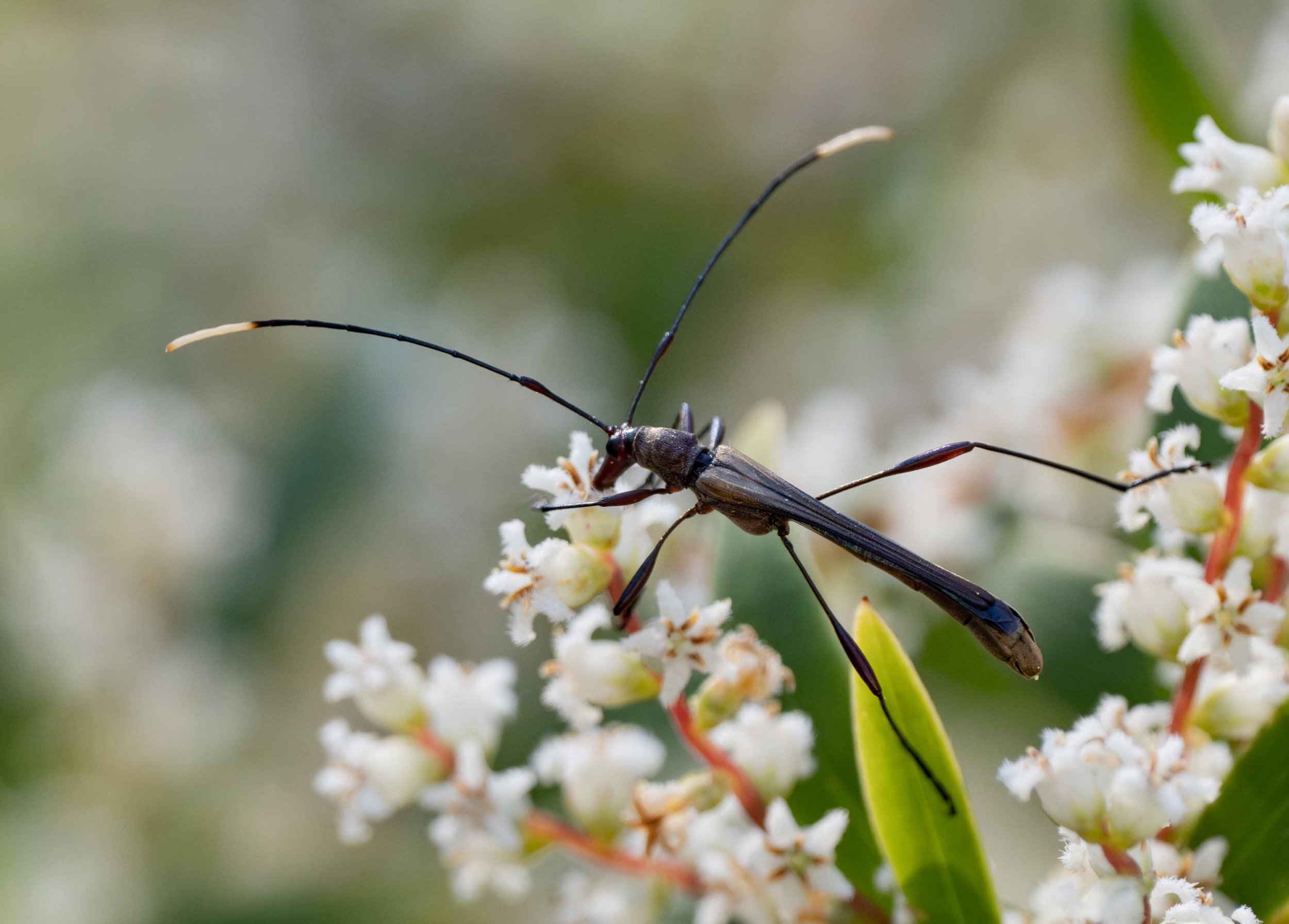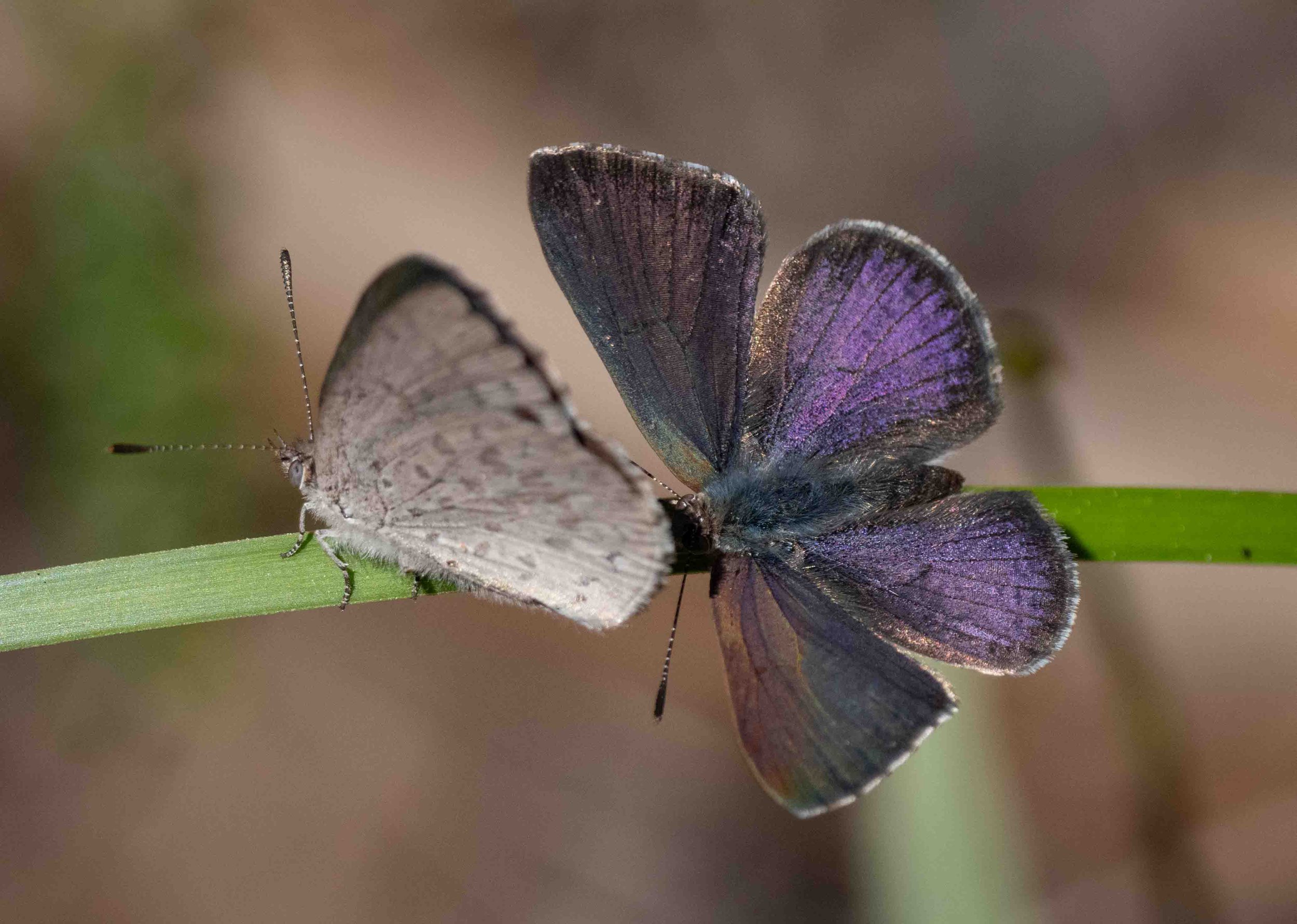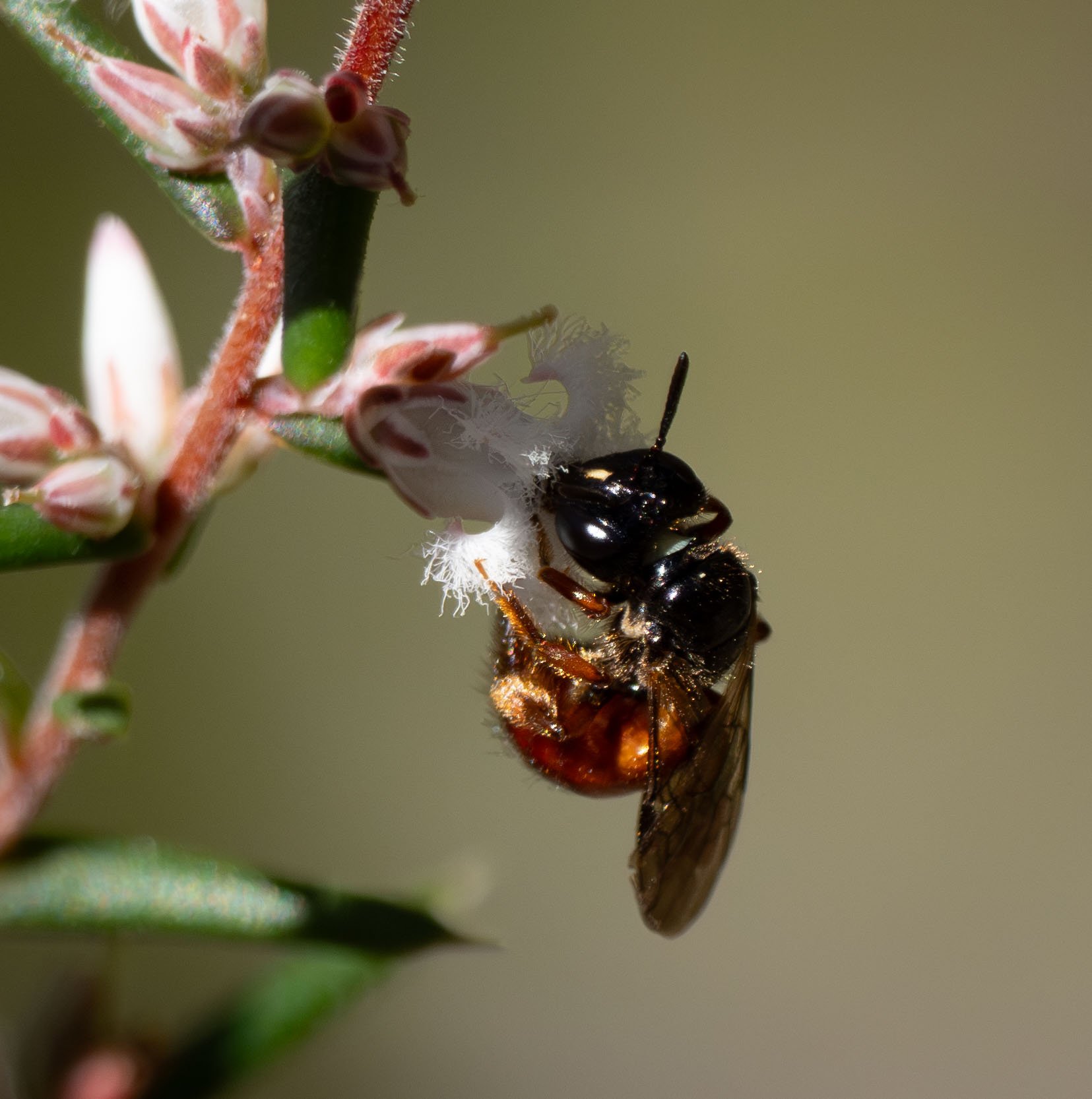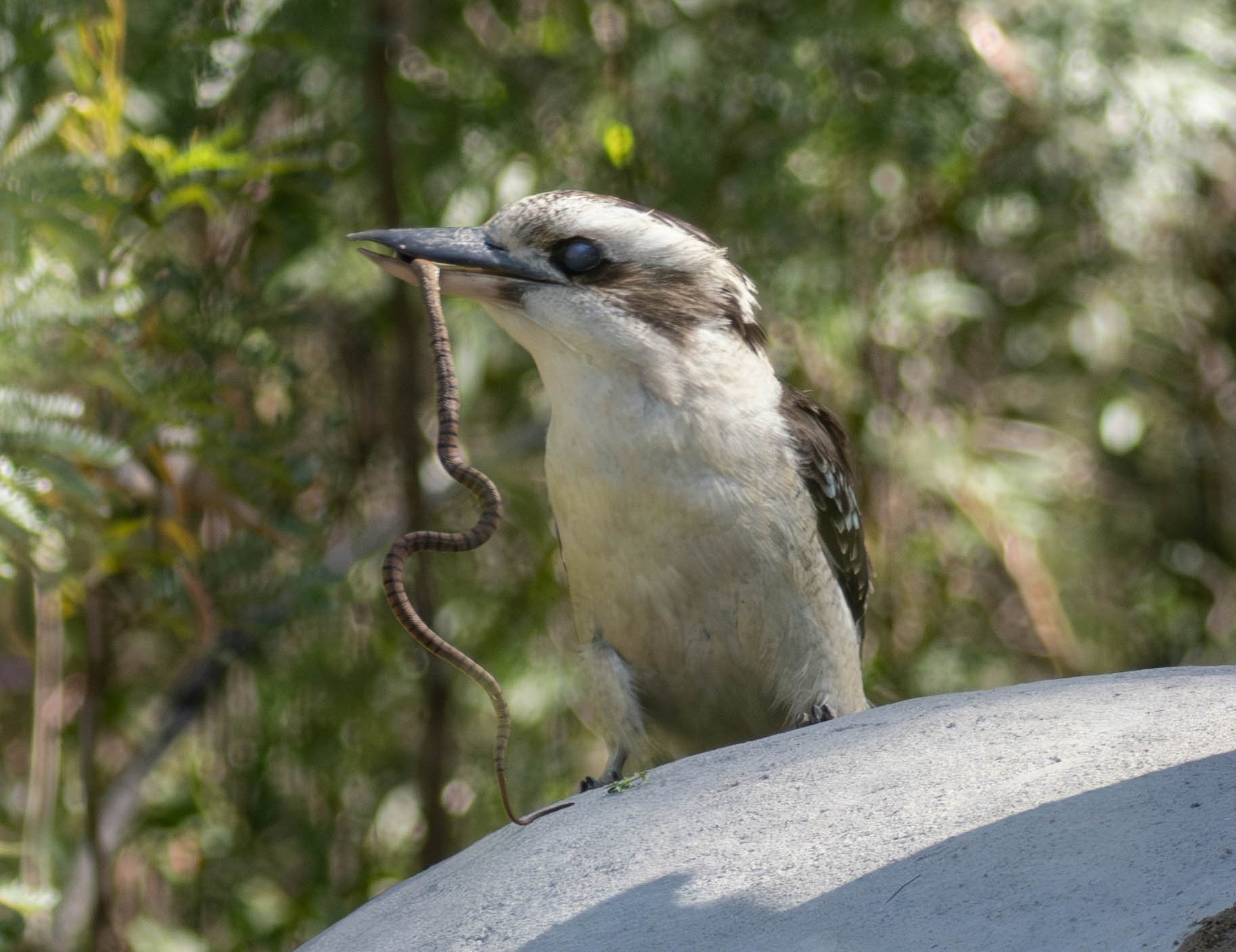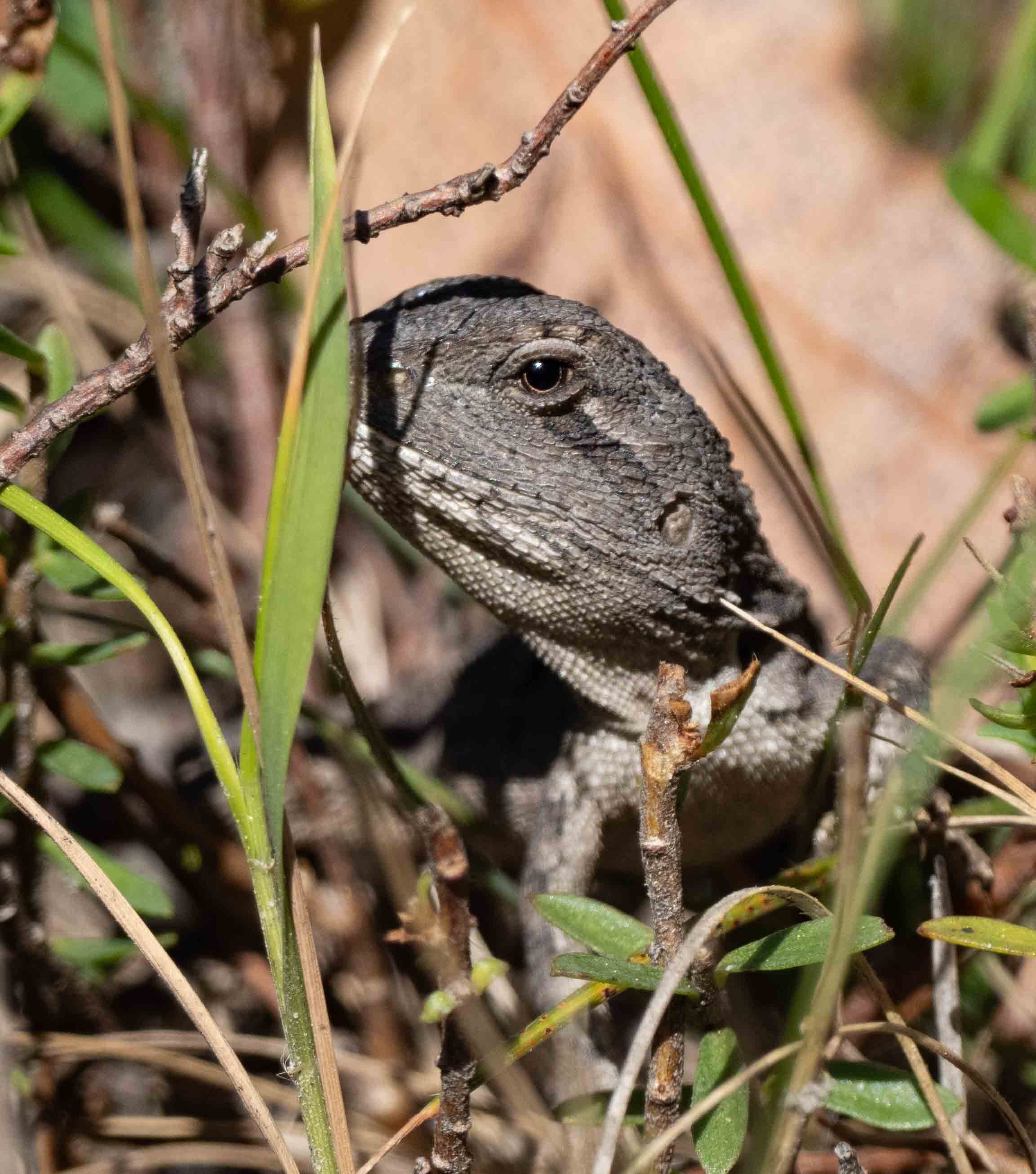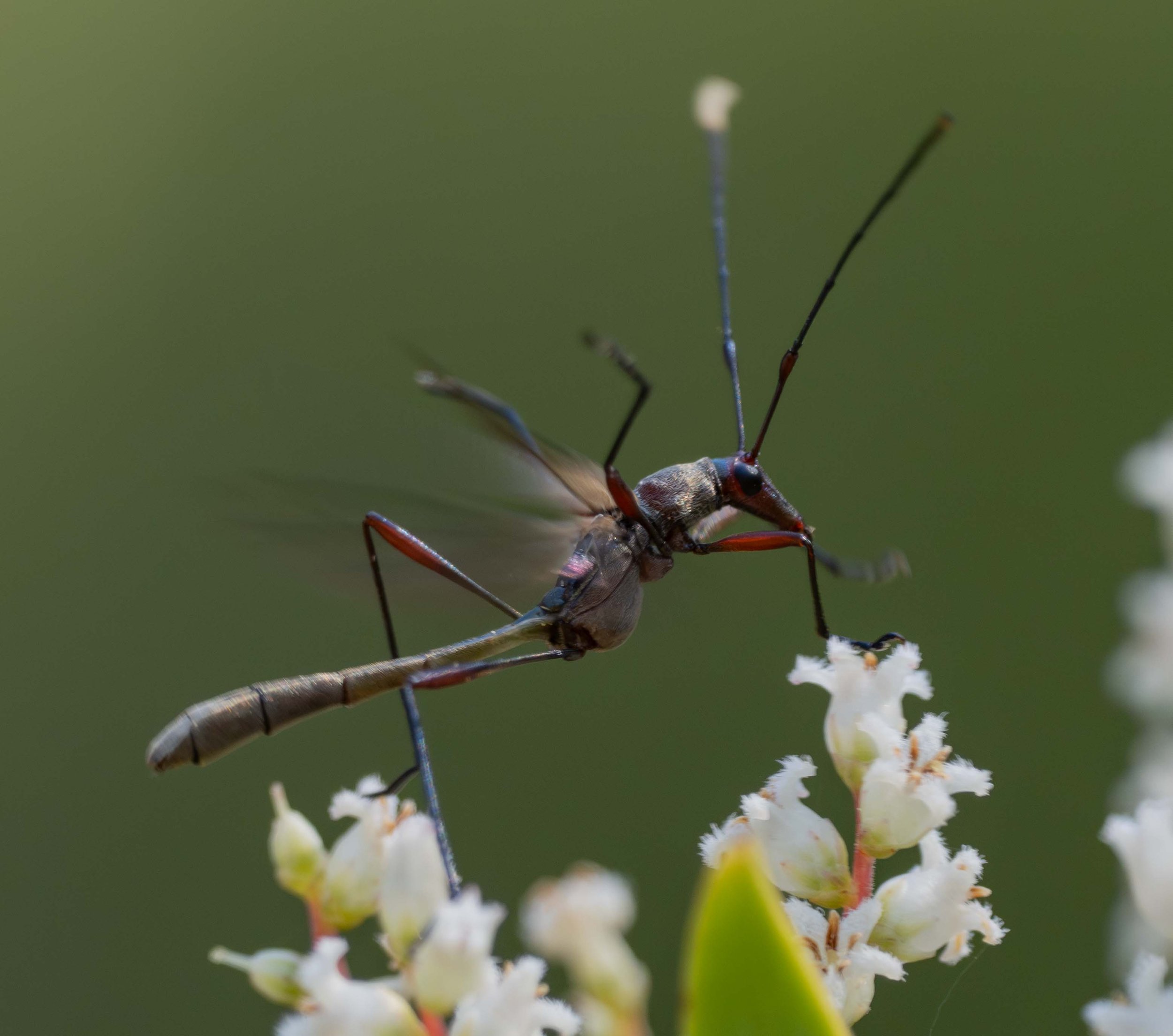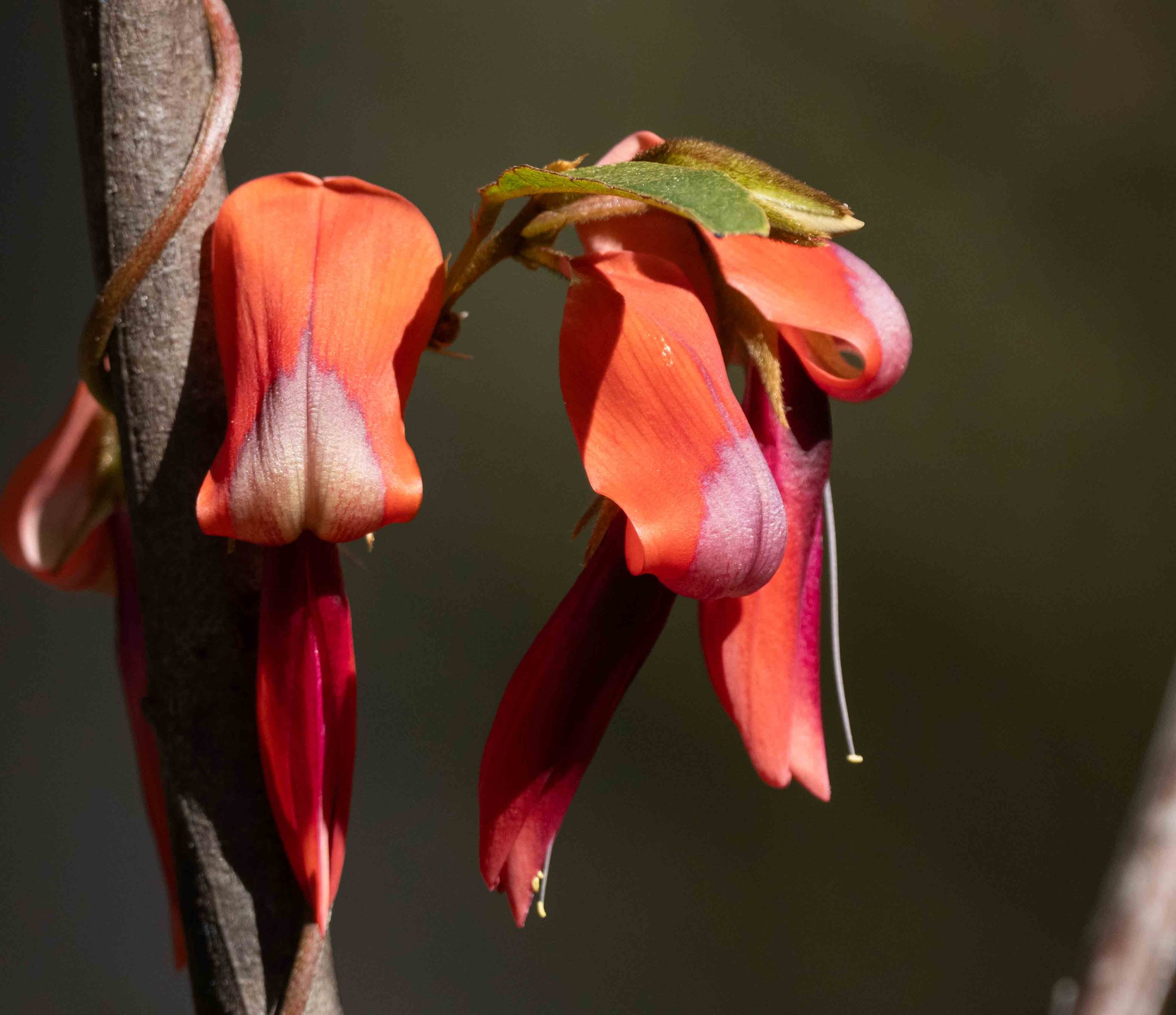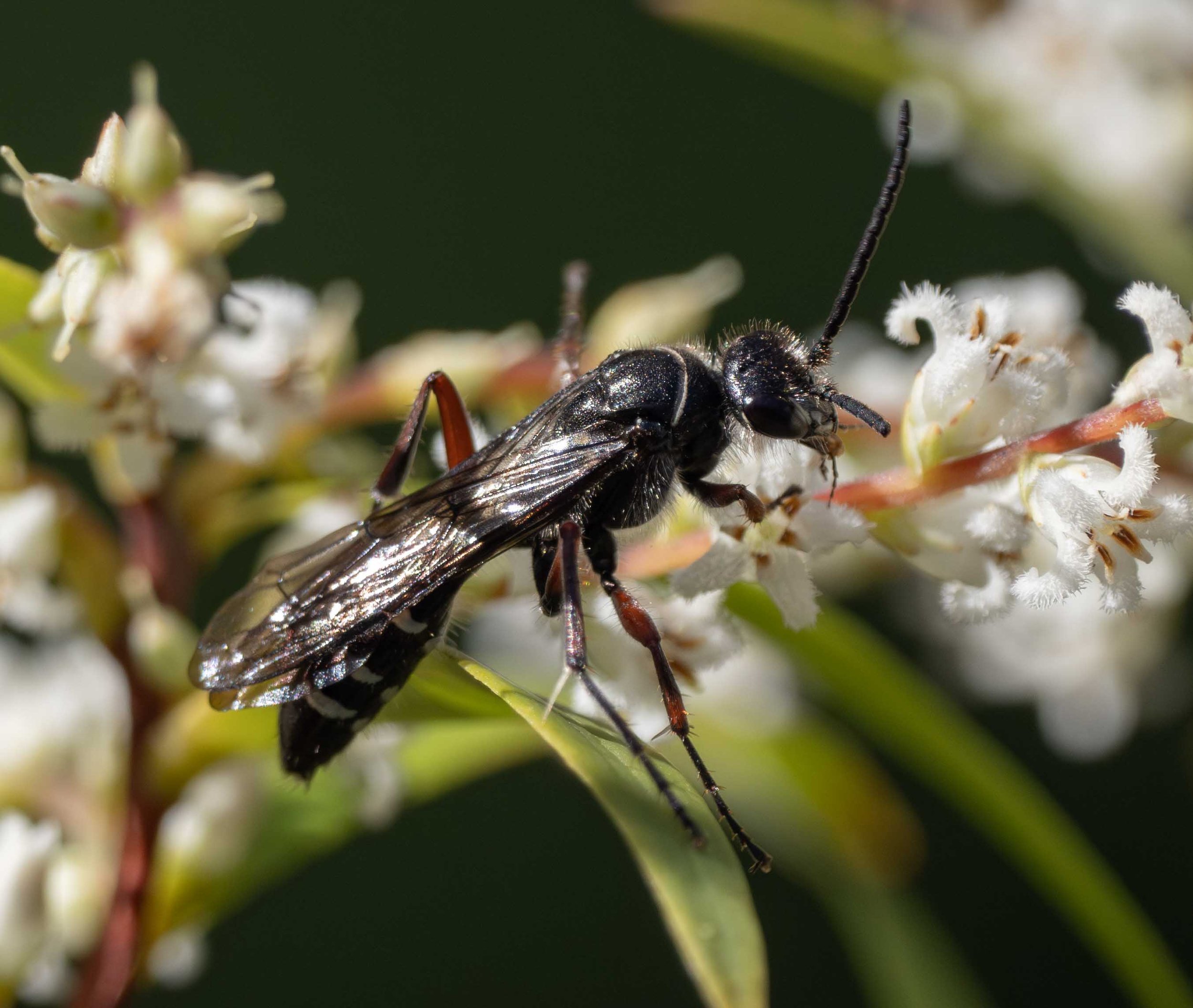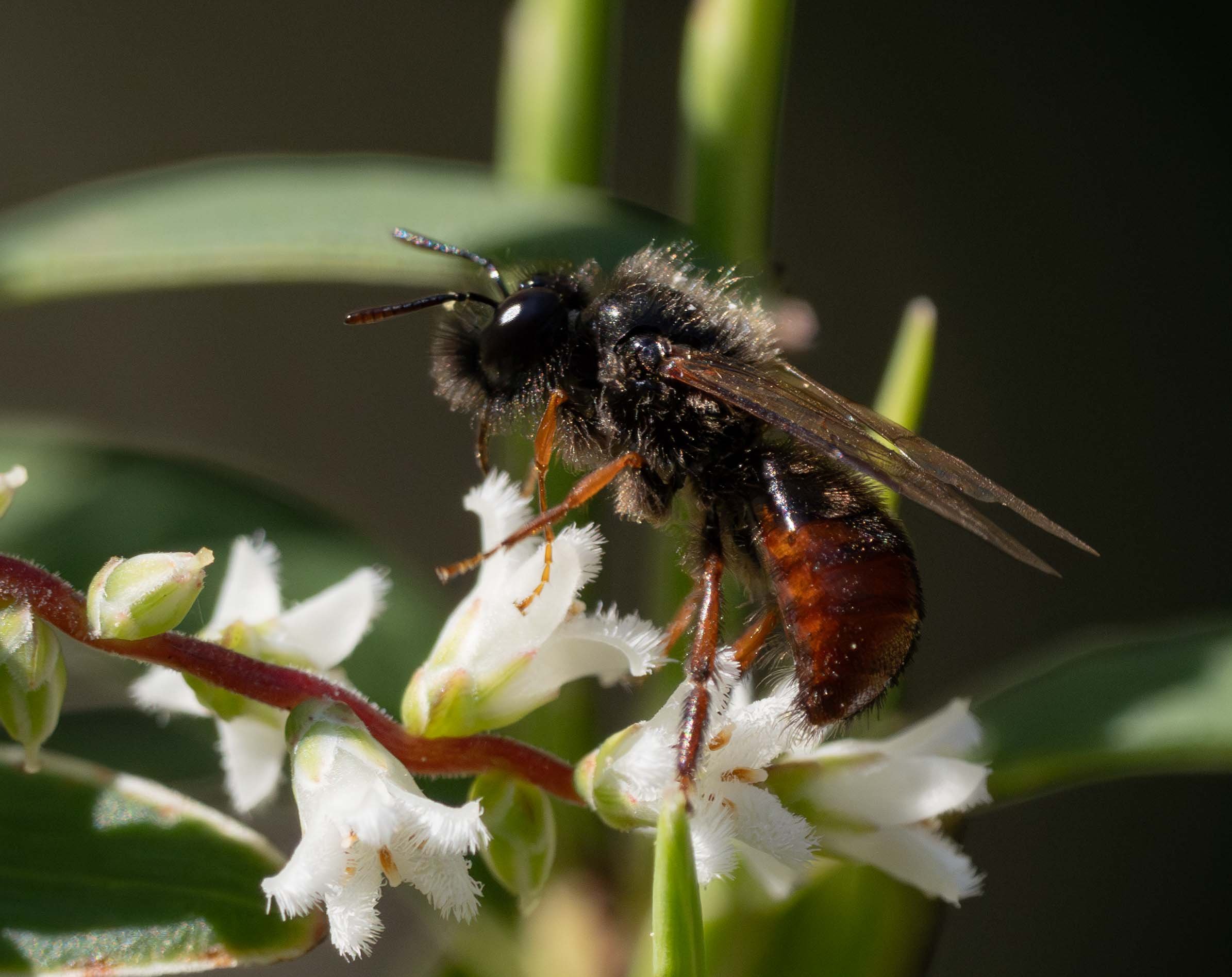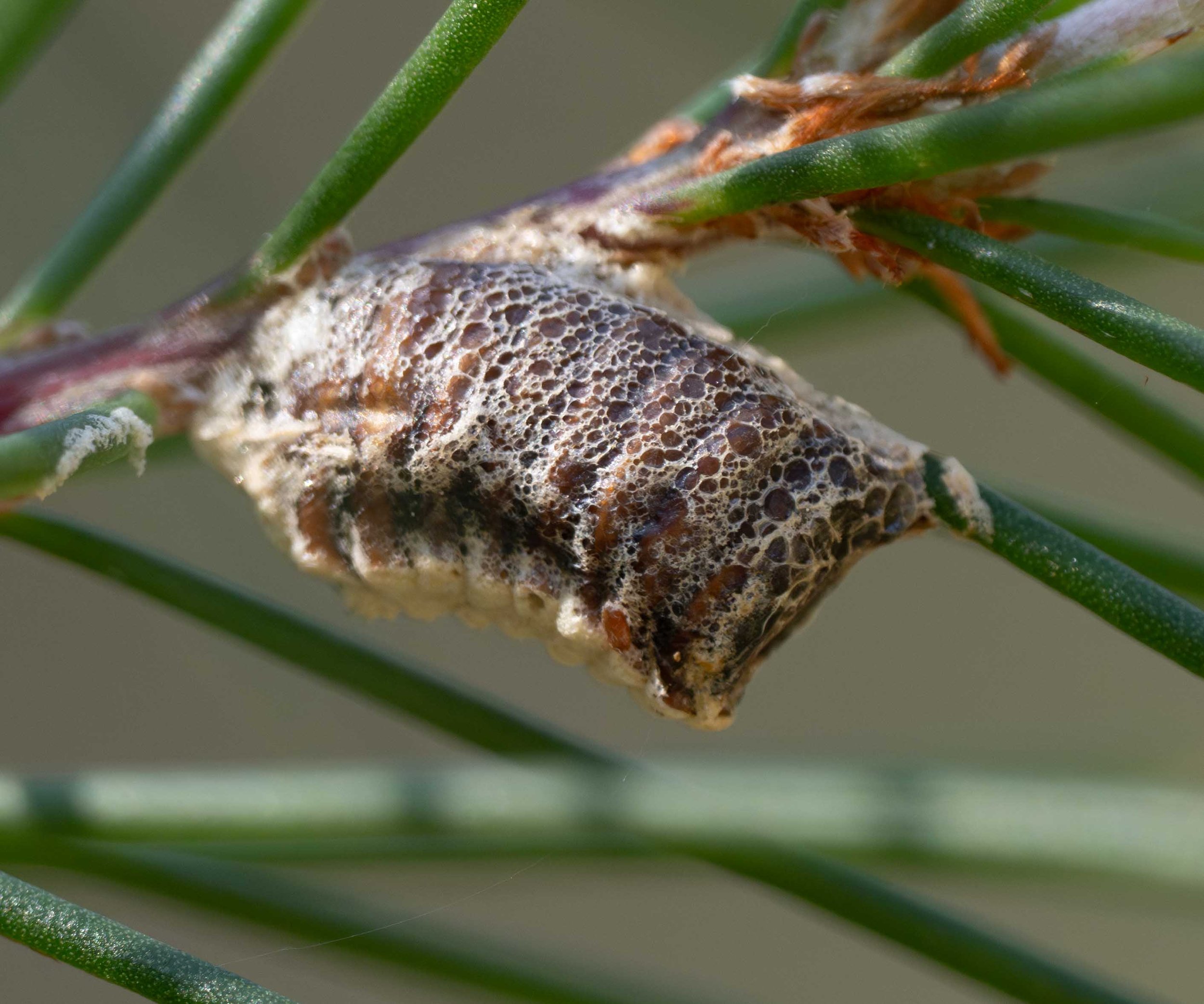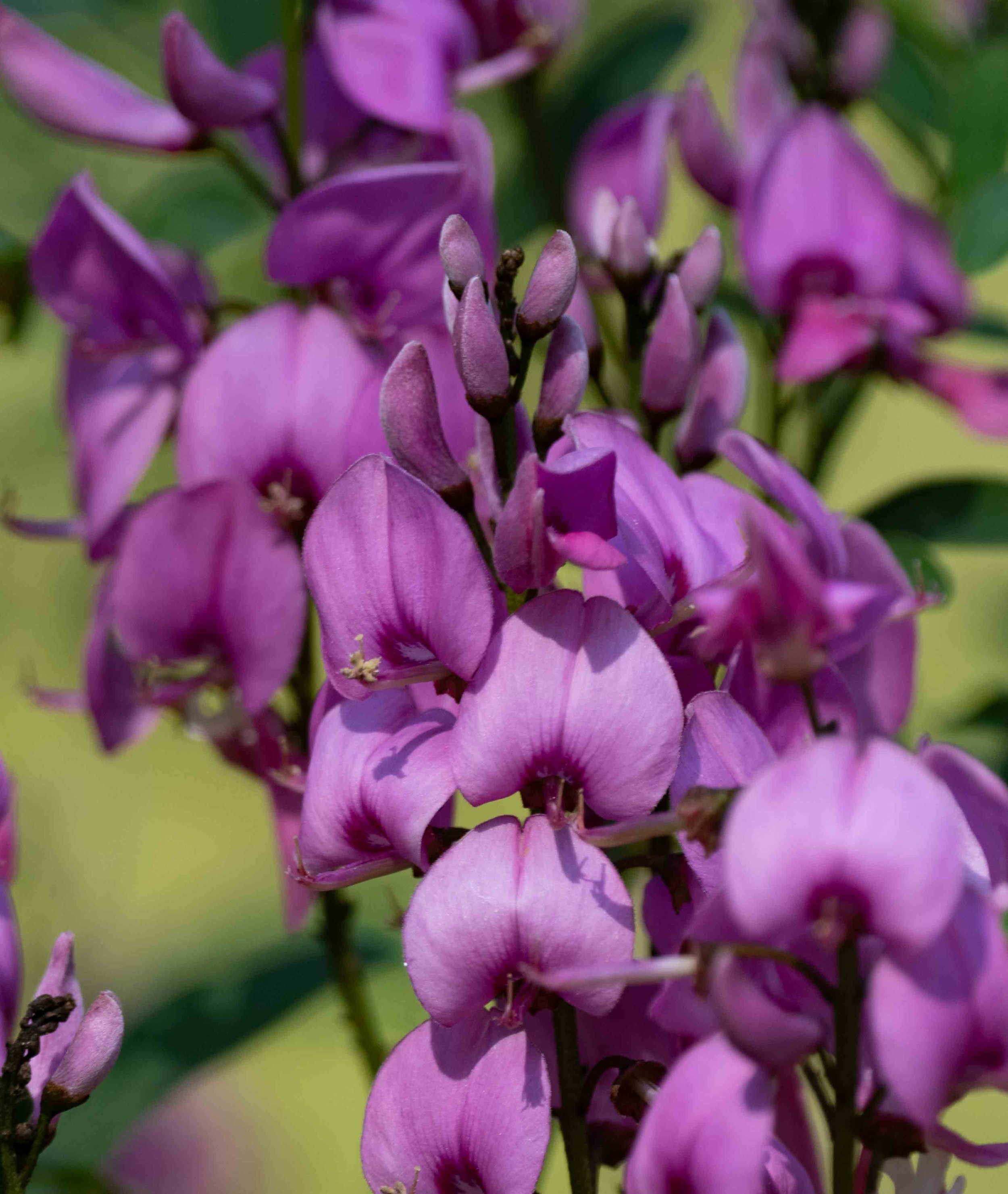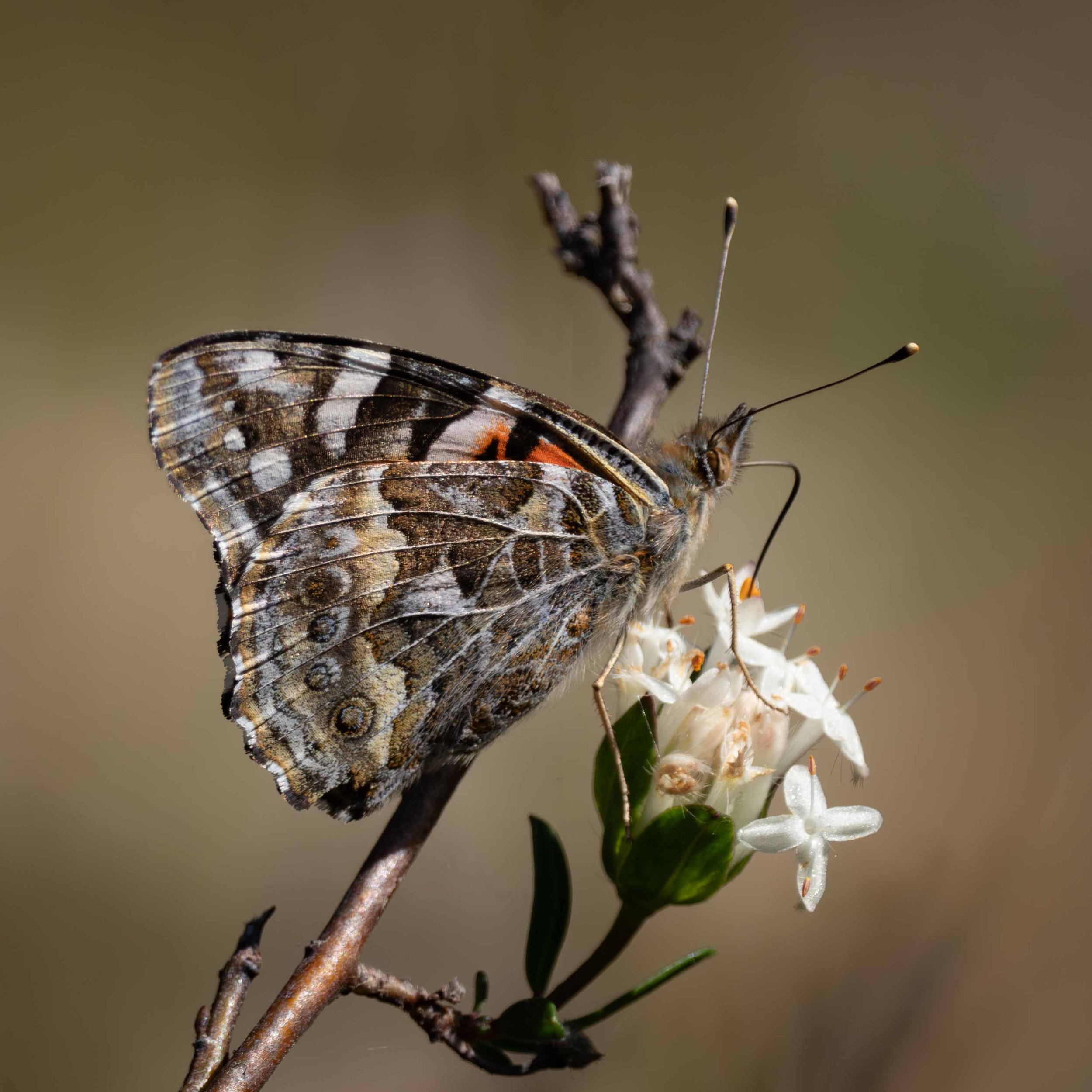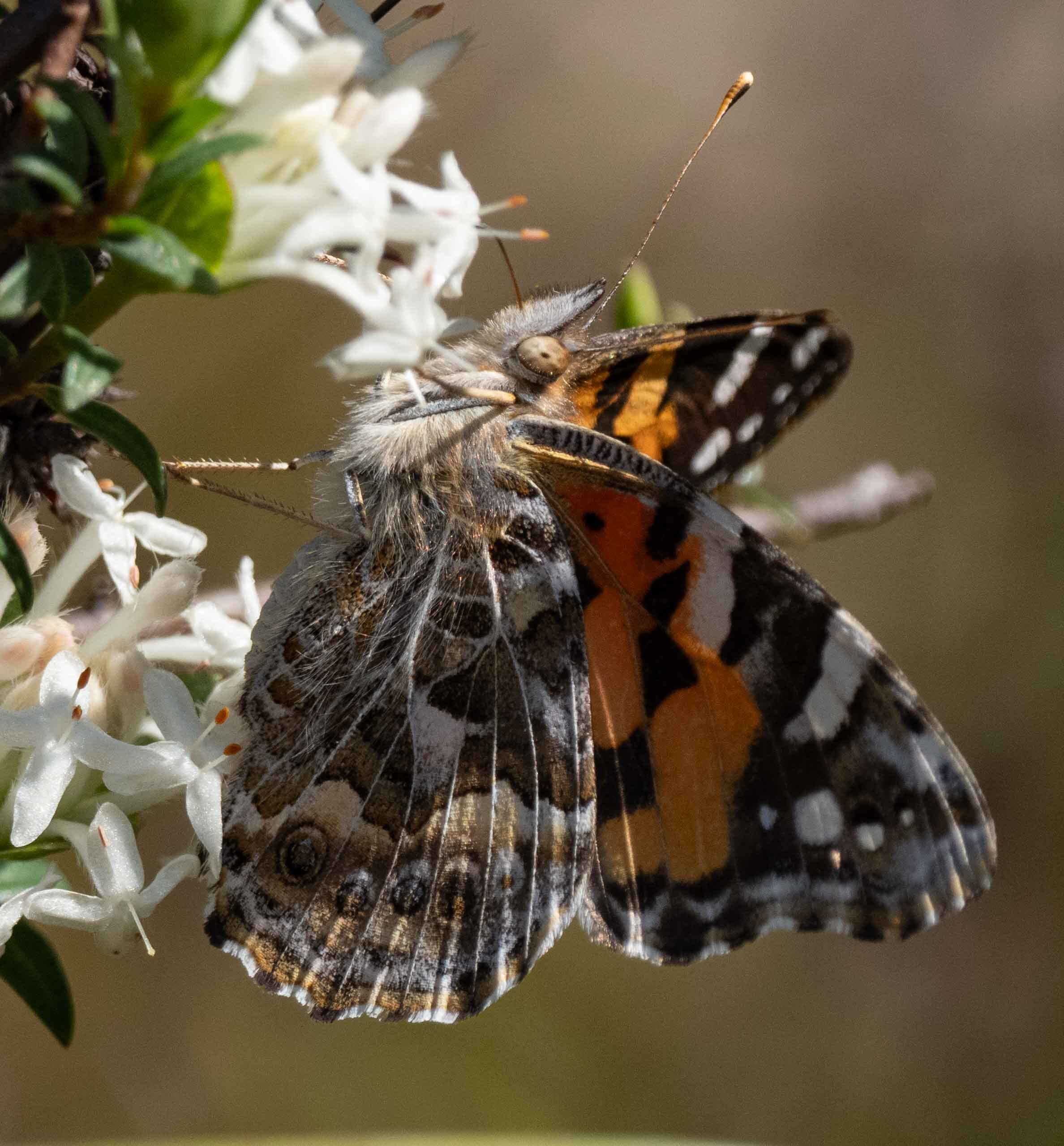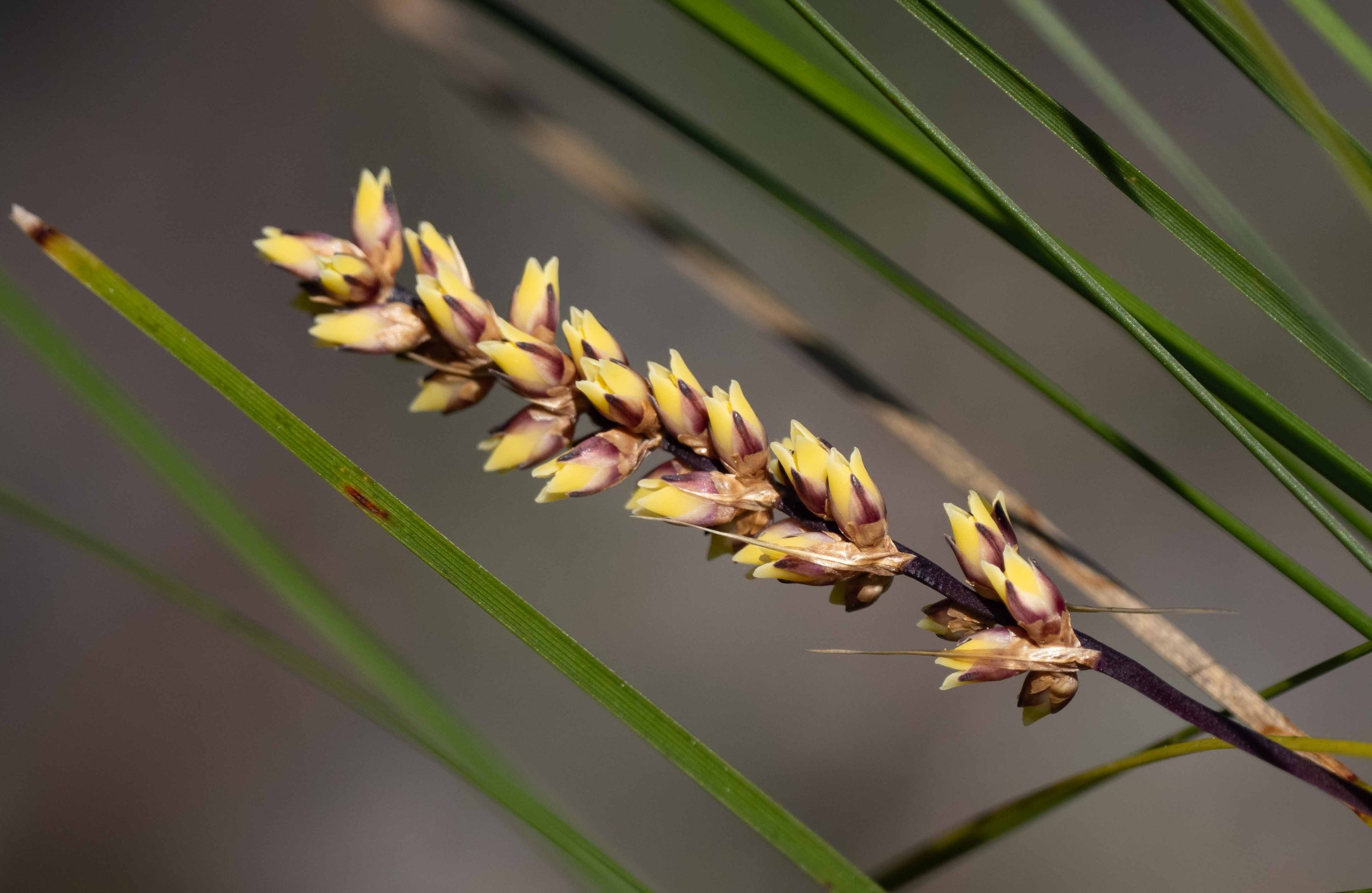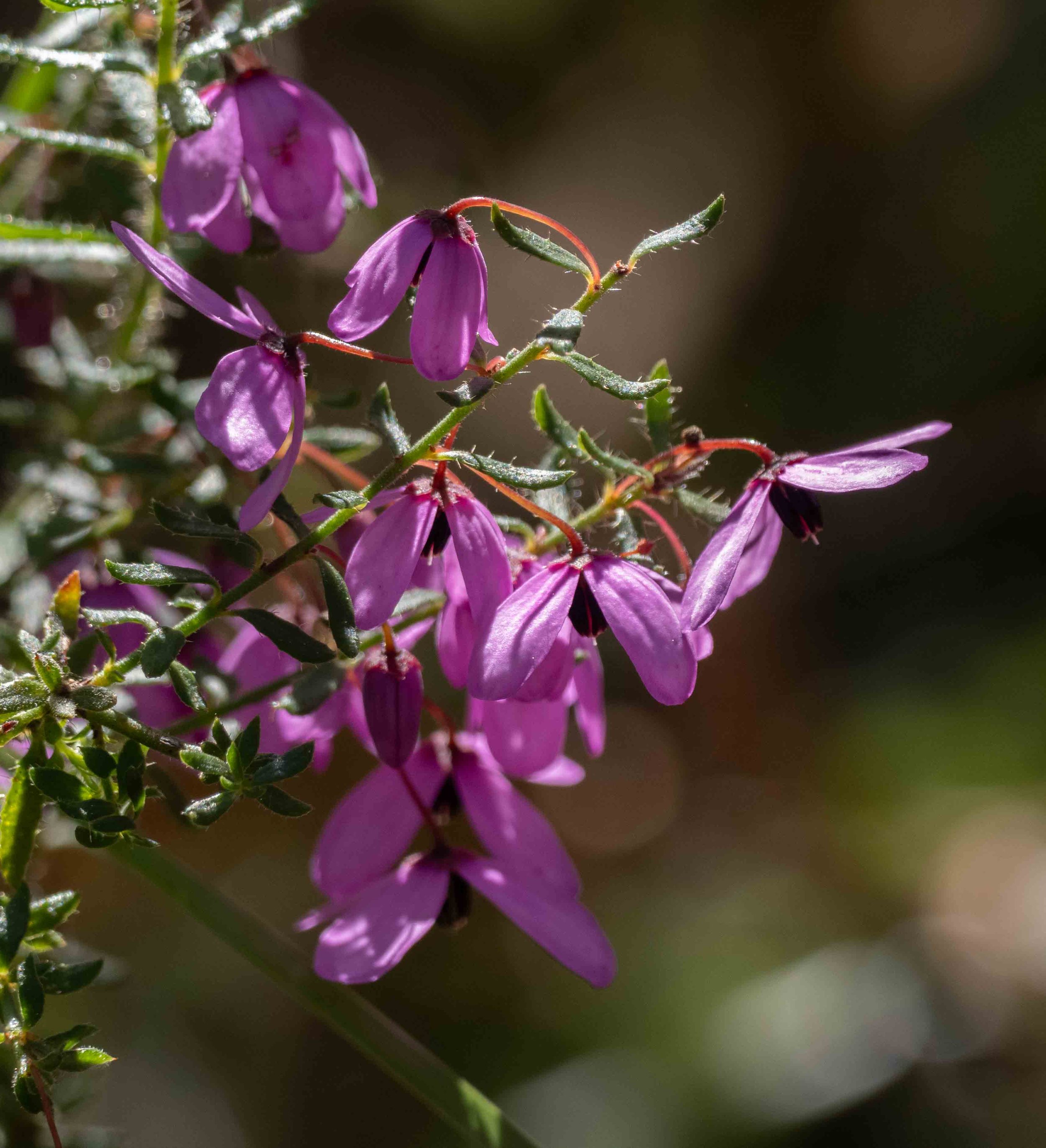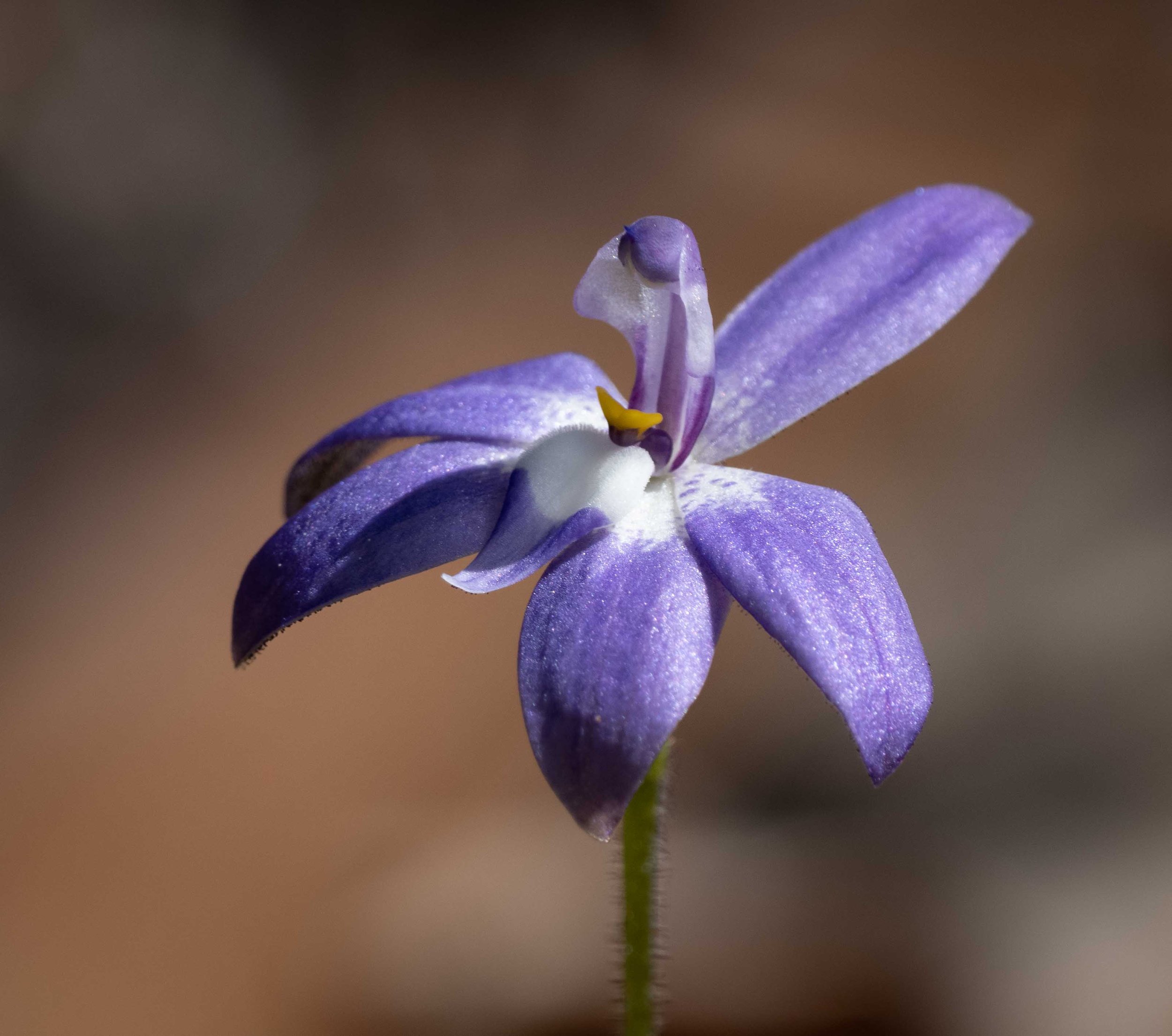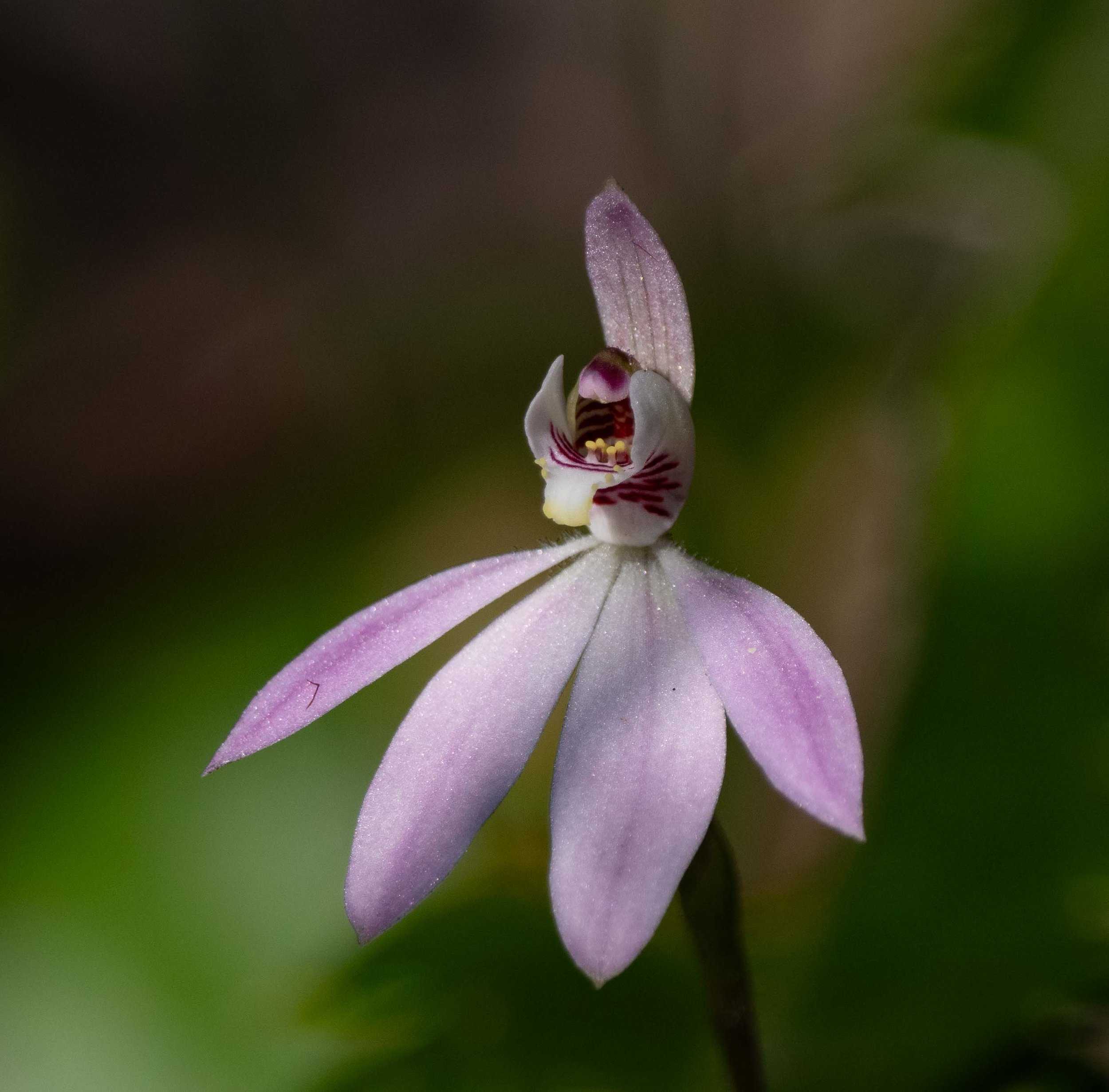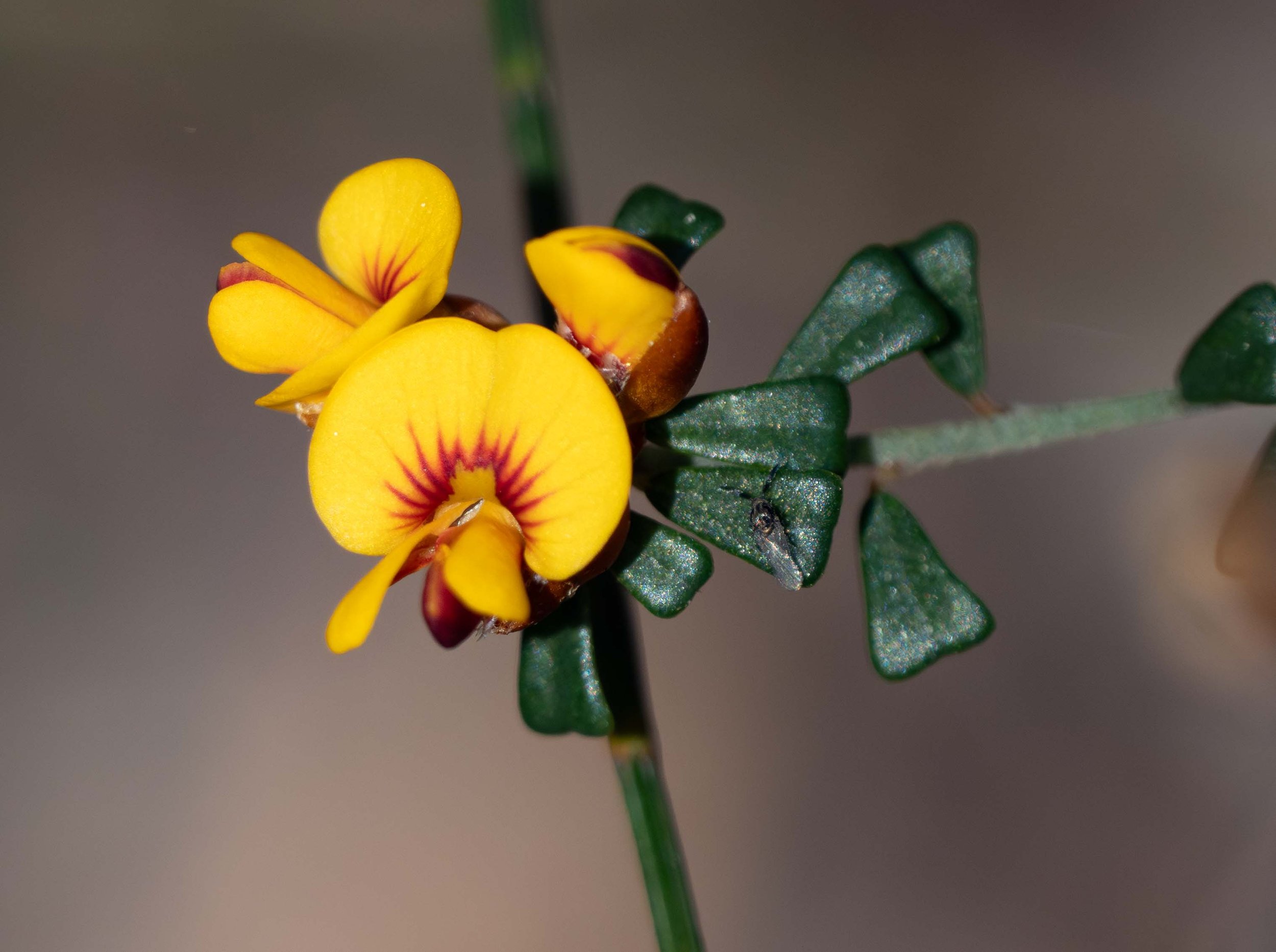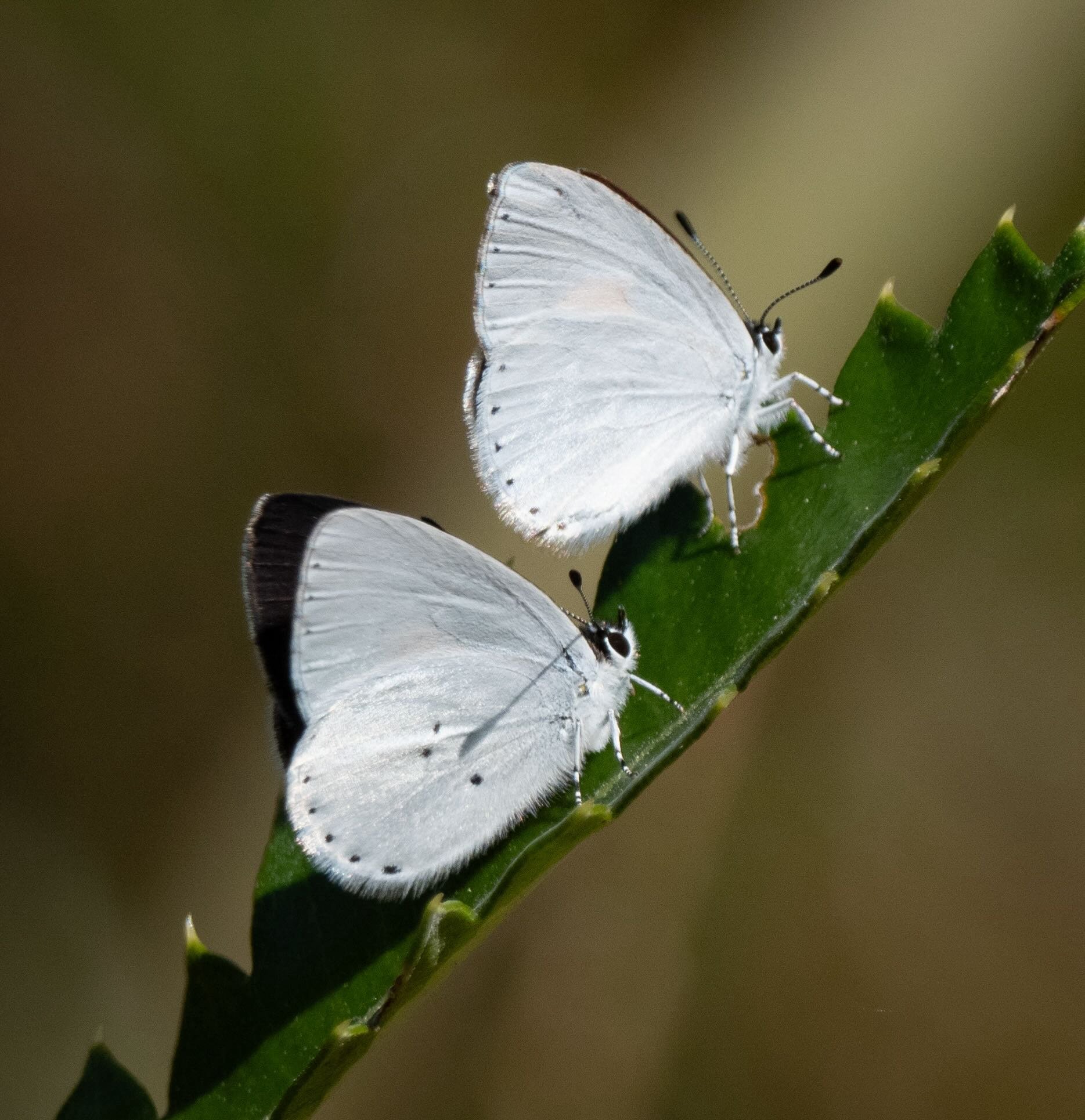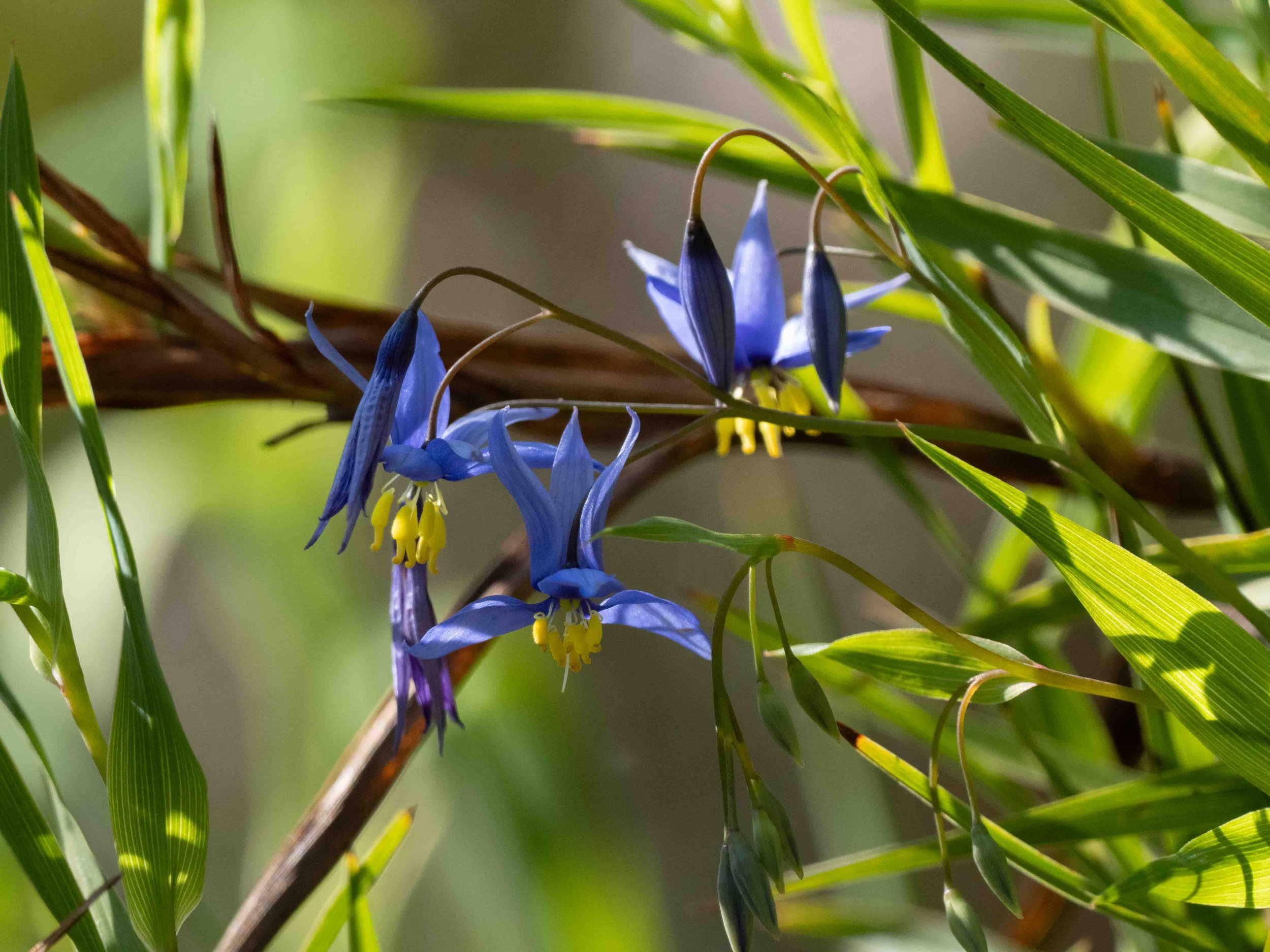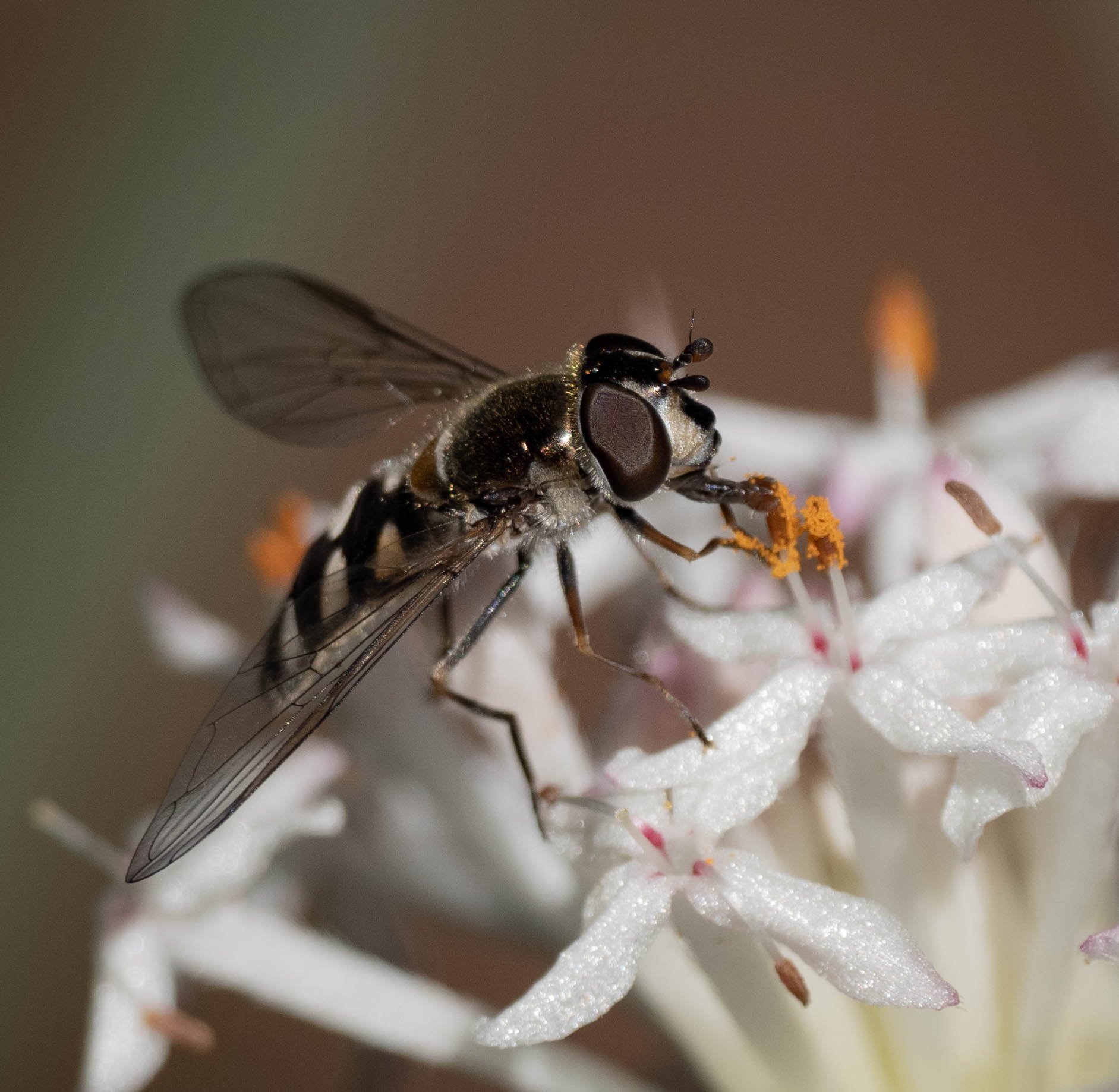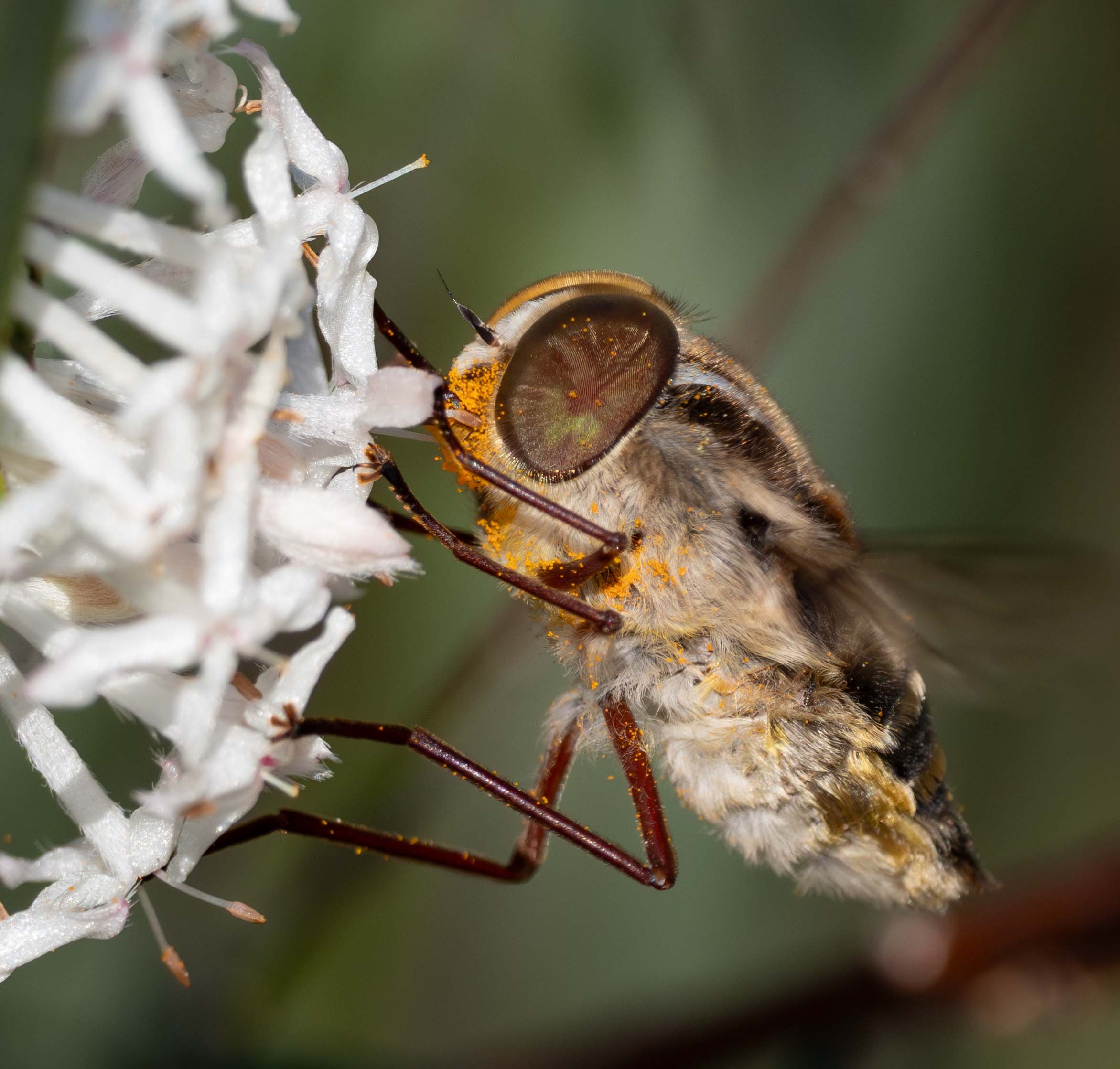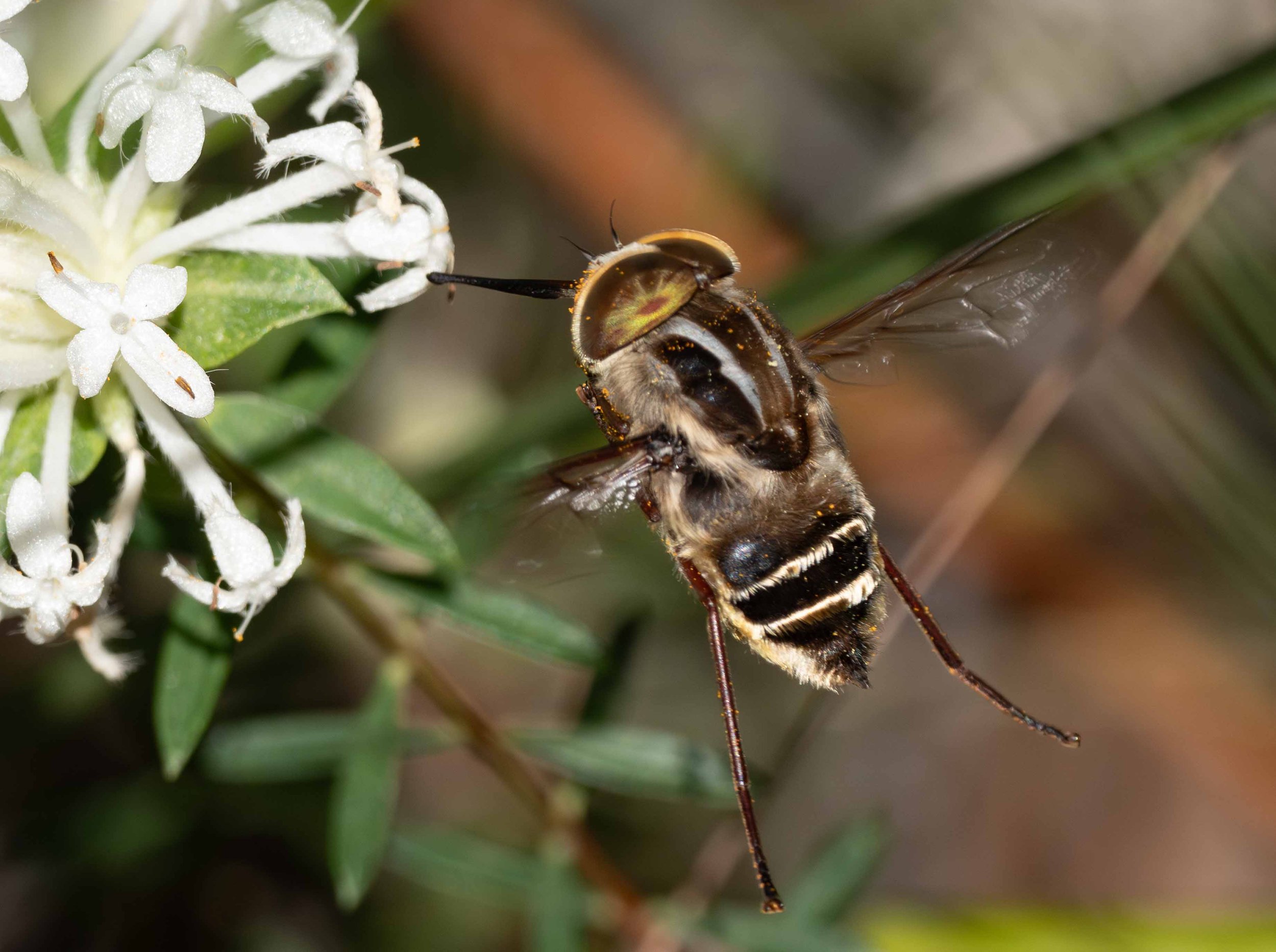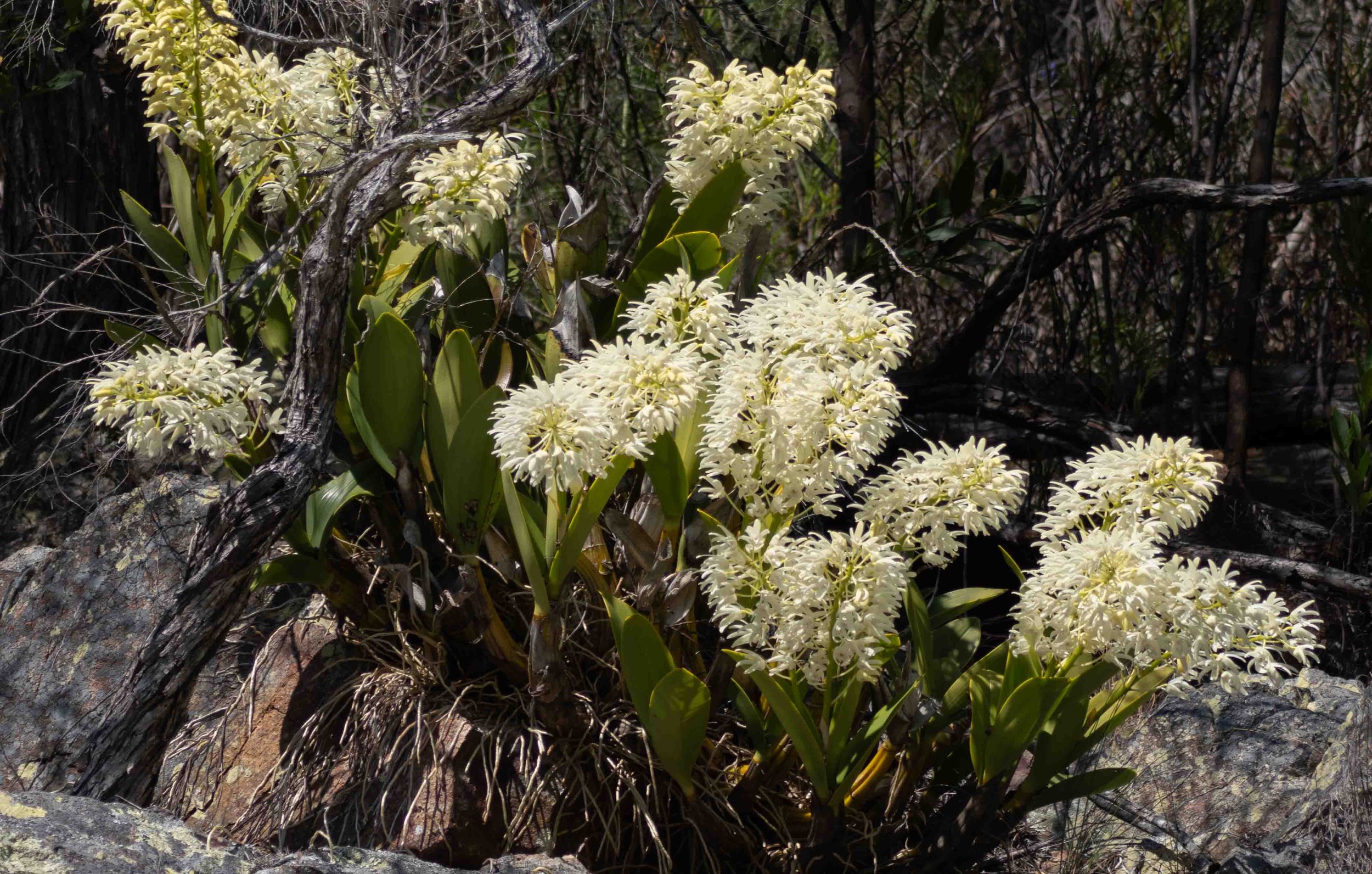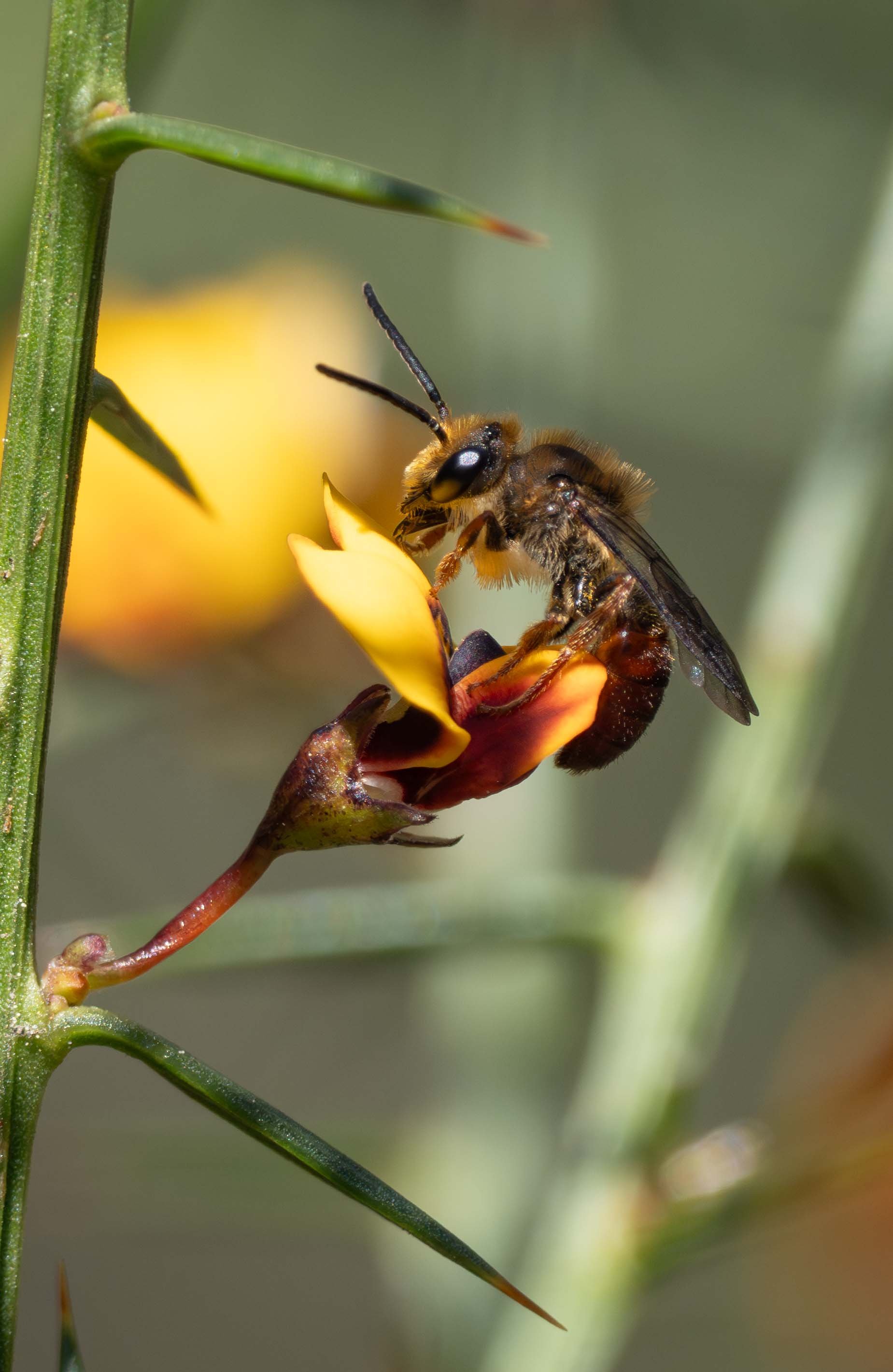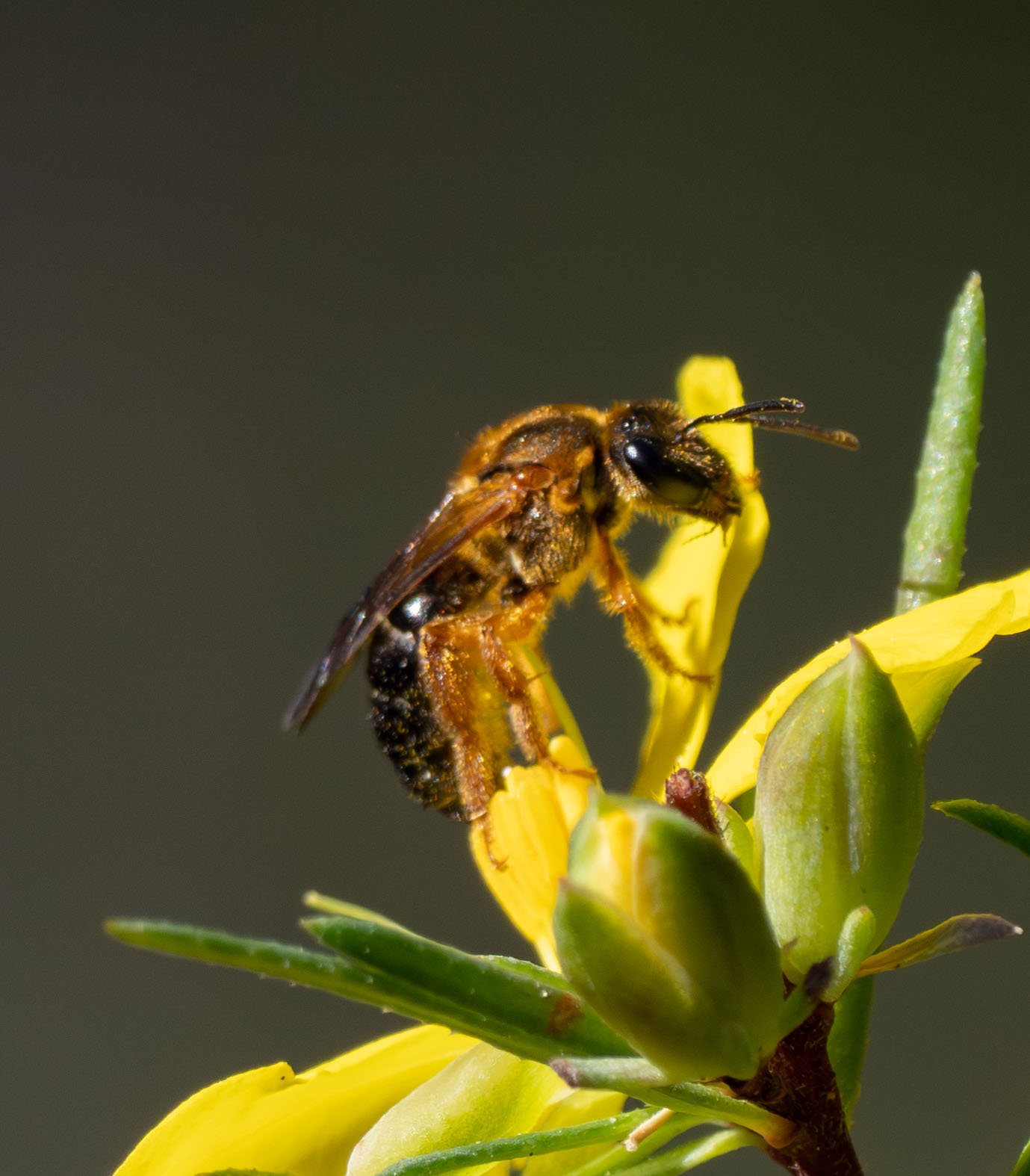And so it begins ... again
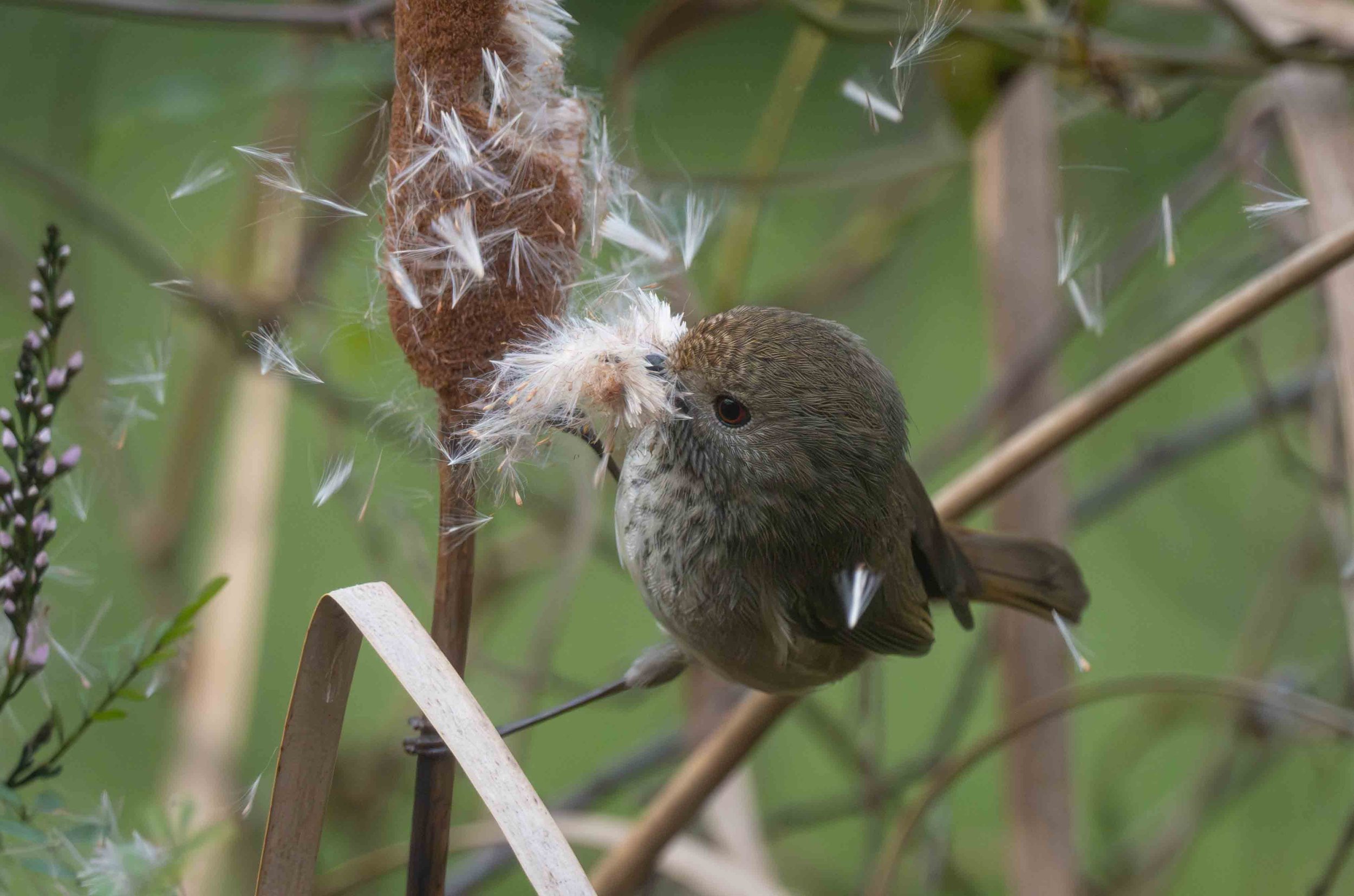
After good winter rains and a bizarrely warm August, spring has definitely arrived in the forest. First the flowers, then the insects … and we are on the prowl again, cameras at hand. Many old favourites reappear, along with some very nice surprises. And it’s not all about the insects … although they are always our top priority. Forest birds are singing, putting on breeding colours and building nests, while reptiles are awakening.
Here’s a small glimpse.
August 2024
This male is the very first native bee we spotted this season. And he's particularly early this year. Tricholletes usually start to appear mid August.
Trichocolletes venustus (link to iNaturalist record)
... spring-flowering orchids. This year we anticipate a good orchid show. Last spring's offering was dismal due to a winter drought, but the signs this season are good.
Caladenia catenata (link to iNaturalist record)
One of the earliest insect visitors to the Styphelia blooms ... and a type of bee fly I've never seen before. The species identity remains a mystery, as we need the wings to stop moving to be able to tell one species from the other. But even at the genus level it's a relatively special sighting. There are currently just 15 sightings on iNaturalist ... well, 16 now.
Sisyromyia (link to iNaturalist record)
A cloud of long-legged insects, hovering in bobbing flight above a patch of flowering Styphelia bushes, proved to be a mating swarm of Dance Flies (tribe Empidini). This male landed briefly, still gripping his freshly killed prey.
tribe Empidini (link to iNaturalist record)
Dance Flies kill for their mates. Literally. He gifts her with a freshly killed insect, in exchange for ... well, you know. Females in the subfamily Empidinae are apparently unable to hunt for themselves. If they need protein for egg production they are reliant upon such largesse (Marshall 2012).
tribe Empidini (link to iNaturalist record)
The very first butterfly sighting of the season. This Varied Dusky-Blue is a common, widespread species of heath and open forests in eastern Australia.
Erina hyacinthina (link to iNaturalist record)
As caterpillars, Erina hyacinthina feeds on the parasitic vine Cassytha ... which we certainly have plenty of here in the forest. But as with virtually all butterflies, the adults simply take nectar from flowers.
Erina hyacinthina (link to iNaturalist record)
Brown Thornbills (Acanthiza pusilla) have been a regular sight at our frog pond of late, stuffing their beaks with seed-bearing hairs from the ripening Cumbungi heads (Typha sp.). I guess the fluffy fibres make a lovely soft nest lining. It is a rather comical performance ... an avian equivalent of kids with fairy floss!
Scroll to the bottom of the page for a short video of the action.
Brown Thornbill (link to iNaturalist record)
The sudden profusion of these small, pinkish flowers is the hallmark of spring here in the forest.
Styphelia ericoides
On warm, sunny days the scent from Styphelia is quite glorious ... it smells like vanilla to me. The flowers precede the insect boom, by weeks. I always find that a surprise, but perhaps the earlist visitors are tiny midges and wasps that escape my attention.
Styphelia ericoides (link to iNaturalist record of first flowering ... on 24th July!)
One of the first large flies to appear, they dwarf the tiny Styphelia flowers as they clamber about collecting nectar.
Dasybasis (tbc) (link to iNaturalist record)
The Syrphidae have been described as "the butterflies of the fly world" and "the most popular group of flies among insect photographers" (Marshall 2012). They certainly gain our attention, but perhaps no more so than their less colourful or less cooperative cousins.
Melangyna sp.
Nearly half the world's Syrphidae belong to the subfamily Eristalinae ... commonly called drone flies. Most have larvae that develop in decomposing vegetation, including in wet, rotting wood. And yes, this sluggish & colourful syrphid is certainly photogenic!
Cyphipelta rufocyanea (link to iNaturalist record)
I had been checking the Styphelia flowers almost daily all month, and not a single Exoneura in sight. Then in the space of a single day, they became the most numerous group of bees about. Various species in a range of sizes, many (like this very first one) quite small.
Exoneura (link to iNaturalist record)
Black Rock Skinks tend to live in family groups ... among rocks. This family has taken up residence in the trunk of a large fallen eucalypt, about a 1.5m above ground. Perfect eye height for me!
Egernia saxatilis (link to iNaturalist record ... and a later sighting here)
My first snake sighting of spring ... a large, shiny Red-bellied Black Snake. Wary, but also reluctant to move away. Both of us.
Pseudechis porphyriacus (link to iNaturalist record)
Identification of this species is child's play.
Pseudechis porphyriacus (link to iNaturalist record)
Hardenbergia is out in all its glory. The first flowers opened in mid August, and now there are splashes of purple at ground level and adorning the many shrubs seconded by this scrambling climber.
Hardenbergia violacea (link to iNaturalist record)
The wattle regrowth here in the forest, post the 2020 bushfire, has certainly been prolific. But just like the dense stands of autumn-flowering Acacia terminalis, Acacia longifolia is already starting to thin out ... due in part to insect attack. In the meantime, it put on a brilliant early-spring show this year.
Acacia longifolia
The beautiful but deadly leaves of the sundew. The delicate pink flowers began to appear at the end of August.
Drosera auriculata
Sporting the first signs of his breeding plumage, this male fairywren (Malurus cyaneus) was looking just a little bit tattered. Now, less than 3 weeks on, he and his fellow males are fully feathered, gorgeous ... and extremely vocal.
Superb Fairywren (link to iNaturalist record)
We discovered this little-known species nesting here a couple of years ago. Having studied them in detail, we are currently preparing a paper for a scientific journal ... as nothing has previously been published about their breeding biology. In the meantime we keep a close watch on their comings and goings. This appearance of a female, digging her burrow in the same patch of bare ground as in previous years, was therefore cause for celebration. By me, anyway. It is also added incentive to get on with that paper!
Rhopalum coriolum
Just centimetres from the nesting crabronid, this small bee was exploring the soil ... probably seeking a nesting site of her own. Most bees in this family are ground-burrowing.
Lasioglossum (link to iNaturalist record)
Although the very first flowers of Leucopogon affinis opened in early August, their flowering is generally later than for Styphelia ericoides, peaking well into September. The bushes are just as showy, the flowers a little larger. And the nectar-feeding insects readily shift their foraging to the new nectar source.
Leucopogon affinis
This is typically the first of our three Pultenaea species to flower –but not the first yellow pea to appear. Bossiaea cordifolia gets underway in July, Daviesia ulicifolia mid August.
Pultenaea linophylla
These tough, spine covered bushes tend to grow in the same part of the forest as do the grass trees (Xanthorrhoea). Soil type, perhaps, or just chance. This is one of the least common pea species on our home list.
Daviesia ulicifolia
Towards the end of August the first Austral Indigo buds opened. The many, spindly bushes reach their flowering peak around mid September.
Indigofera australis (link to iNaturalist record)
These were the very first Love Creeper flowers to open ... and when I checked on them the following morning, they were gone. Flowers, buds, the lot. Pesky wallabies!! But no matter. More plants have since bloomed, adding their purple tones to the forest's increasingly colourful flowerscape.
Comesperma volubile (link to iNaturalist record)
Mating swarms of these stiletto flies (Therevidae) superficially resemble those of dance flies (Empididae). Males circle and hover a metre or so above the ground, particularly when the sun shines and the wind is light. Their styles are distinctive, however. Most notably, Ectinorhynchus rely on arm waving rather than nuptial gift giving.
Ectinorhyncus (link to iNaturalist record)
September 2024
A small group of Maroonhoods herald the official start of spring, flowering in their usual spot.
Pterostylis pedunculata (link to iNaturalist record)
Green-and-gold Nomia Bees are large, colourful ... and photogenic. This is the first I've seen this season, but I expect they will be a regular sight throughout spring and summer. They're ground-nesters, and I know at least one of their favoured nesting grounds. And they feed on a wide range of flowers. I know where to look for them!
Lipotriches australica (link to iNaturalist record)
These longhorn beetles are rather comical, with their dragon-like faces and gangly legs. They gather and feed at a range of flowers, including this Leucopogon bush. The host plants for Enchoptera larvae are unknown.
Enchoptera apicalis (link to iNaturalist record)
It begins with pursuit, then a furious fluttering of wings. The shape of the forewing marks the one on the right as the male. That, and his behaviour ... he is the obvious pursuer.
Erina hyacinthina (link to iNaturalist record)
One week into spring, officially, and Styphelia ericoides is already past its prime. Fruits are now forming in the wake of earlier blooms. Yet clusters of flowers and buds remain on some plants, and they continue to cater for their share of small bees.
Exoneura sp.
From atop our bread oven this Kookaburra made a quick dive into the undergrowth and was soon back with its prize: a writhing baby Eastern Brown Snake. Juvenile snakes of this species are readily identified by their stripes and head markings. After bashing it a couple of times on the top of the oven, the winner flew off into a nearby eucalypt.
Pseudonaja textilis (Eastern Brown Snake) (link to iNaturalist record)
This young Jacky Dragon is the first we've seen since the January 2020 fire. Why this should be, we don't know. They were numerous and obvious before the fire. Anyway, it is nice to have them back. They'll just need to beware hunting Kookaburras!
Amphibolurus muricatus (link to iNaturalist record)
Still hanging about the Leucopogon flowers. Still making me smile with their antics.
Enchoptera apicalis (link to iNaturalist record)
The growth of this tough climber was rampant for a couple of years after the January 2020 fire. Kennedia flowers festooned the standing trunks of dead trees throughout the forest. It has since settled back to pre-fire level, and now just provides decorative touches of colour here and there. Big and red, they're favoured by birds rather than bees. Eastern Spinebills and Yellow-faced Honeyeaters love them!
Kennedia rubicunda
Now this was a nice find! And the second sighting within two days (both times on this Leucopogon bush, so perhaps it was the same wasp each time). 'Blue Ants' ... Diamma bicolor ... are a type of flower wasp. The common name refers to the large, flightless females which are a brilliant blue ... and indeed quite commonly sighted. The males, however, are much smaller, winged ... and very rarely seen! This is only the second time I've photographed one, the previous being in October 2022. And it's not just here that they're a rare sighting. There are over 600 iNaturalist records of this species between Sept 2022 and now ... and only 21 of these are males (including my 2)!
Diamma bicolor (link to iNaturalist record)
Last spring I spotted these bees for the first time and was puzzled. The apically flattened abdomen is characteristic of Exoneura ... but those huge, bulging eyes and the very hairy face!?! After a bit of research the puzzle was solved ... these features are characteristic of the males of some species within the subgenus Exoneura (Exoneura). And now, almost exactly 12 months later, they make another appearance.
Exoneura robusta (link to iNaturalist record)
We rarely spot mantid ('praying mantis') egg cases, which is a little surprising given that we frequently see the insects themselves. Mantids surround their eggs in a frothy material that hardens upon drying and forms the 'ootheca', the shape of which varies between species. Despite the protective ootheca, mantid eggs are often targetted by tiny parasitic wasps. I have decided to bring this one inside to see what eventually emerges ... mantids, wasps, or both!
Orthodera (link to iNaturalist record)
Approaching peak pink, when Austral Indigo adorns the shrub layer with sprays of delicate pea flowers.
Indigofera australis
A widespread and common species ... and yet another butterfly species taking full advantage of its long proboscis to probe the tubular Pimelea flowers.
Vanessa kershawi (link to iNaturalist record)
The lower surface of their wings are even more decorative than the upper.
Vanessa kershawi
The tussock of green leaves is rather grass-like, but this is not a grass. Lomandra ('mat rushes') are hardy, adaptable, perennial ... and therefore well-suited to public spaces where they are widely used as both decoration and erosion control. This is one of five Lomandra species on our home list.
Lomandra confertifolia
Tetratheca grows well on our sandy, nutrient-poor soils. It is a plant of heath and sclerophyll forest in southern parts of Australia. Indeed, we are nearly at this species' northern limit for NSW!
Tetratheca pilosa
Another orchid makes its first appearance for the season. So far just a handful of blooms, but it really does look like we're in for a good orchid show this spring!
Glossodia major (now Caladenia major) (link to iNaturalist record)
Small pink to white orchids of this type are common and widespread ... and rather difficult to confidently take to species level. This one does appear to be Caladenia carnea, but among the growing number of flowers appearing we may also have C. fuscata. The differences are subtle ... largely coming down to the intensity of the pink.
Caladenia carnea
The genus is reportedly under revision, so names and groupings may change. For now, this is the third of our Pultenaea species to flower this spring.
Pultenaea retusa (link to iNaturalist record)
Suddenly these small, brilliantly white butterflies appear in numbers ... and quickly set about finding mates. Just seconds after this shot the pair where securely coupled, end-to-end.
Candalides xanthospilos (link to iNaturalist record)
More flowers appear, this time in dense swathes on the steep slope leading down to the river. The species does well in sandy or granitic soils and full sun, and these lilies are widespread across eastern NSW and southern Australia. I'll be checking the flowers regularly for insect visitors ... several of our bee species are quite adept at clinging upside down to the dangling anthers!
Stypandra glauca (link to iNaturalist record)
Hoverflies consume both pollen and nectar. The exposed anthers of Pimelea flowers are readily accessible to these short-tongued flies.
Melangyna (link to iNaturalist record)
What makes an insect an effective pollinator? Quite simply, it must move between flowers of the same species ... and it must transport pollen. This tangleveined fly (Nemestrinidae) no doubt has the potential to be an excellent pollinator of Pimelea! The bright orange pollen grains cling to its hairy body, as it progressively works from flower to flower, plant to plant. However, unlike hoverflies, tangleveined flies are rarely numerous ... the hoverflies, bees and butterflies no doubt play a more significant role for our local Pimelea population.
Trichophthalma laetilinea (link to iNaturalist record)
The very long mouthparts give this fly an advantage over hoverflies. Like the butterflies, and in stark contrast to hoverflies, Trichophthalma can reach the nectar which is held deep within the floral tube.
Trichophthalma laetilinea (link to iNaturalist record)
Of all the plants to begin flowering in the last month, this is certainly the most exciting for us! These attractive, tall shrubs with their drooping branches are not common in our region. Indeed, we are almost at their southern limit. The species is killed by fire and relies upon the post-burn release of seeds from its woody fruit to recolonise an area. We recorded the first seedlings three months post fire ... and on 31st August this year we celebrated the first flowering of some of those young shrubs!
Hakea macraeana (link to iNaturalist record of first flowers opening)
On the rocky cliffside above the river, this orchid survives and thrives. Some years it flowers en masse, other years hardly at all. This year is a great year! Like our Hakea species, we are near the southern limit of distribution of this Rock Orchid. It persists in a few locations in far East Gippland, but "unscrupulous collectors" have pushed the plant to Critically Endangered status in Victoria (link to VicFlora site).
Dendrobium speciosum var. speciosum (link to iNaturalist record)
A species commonly found on pea flowers, this male Leioproctus was one of many bees swarming about and feeding on a single Daviesia bush. It was quite a spectacle, and included at least two species of Leioproctus plus Trichocolletes orientalis.
Leioproctus platycephalus (link to iNaturalist record)
Bright yellow Hibbertia flowers are currently putting on a show to rival that of the nearby yellow peas. However, they appeal to a narrower range of insects because Hibbertia flowers lack nectar. They attract only pollen-gatherers, and the plants' pollen is available to only some insects ... those that can free the grains from the tubular anthers. This small female bee had been doing just that ... gripping the anthers of Hibbertia calycina and giving them a good shake.
Lasioglossum (link to iNaturalist record)
References
Marshall, S.A. 2012. Flies: the natural history and diversity of Diptera. Firefly Books, Ontario
